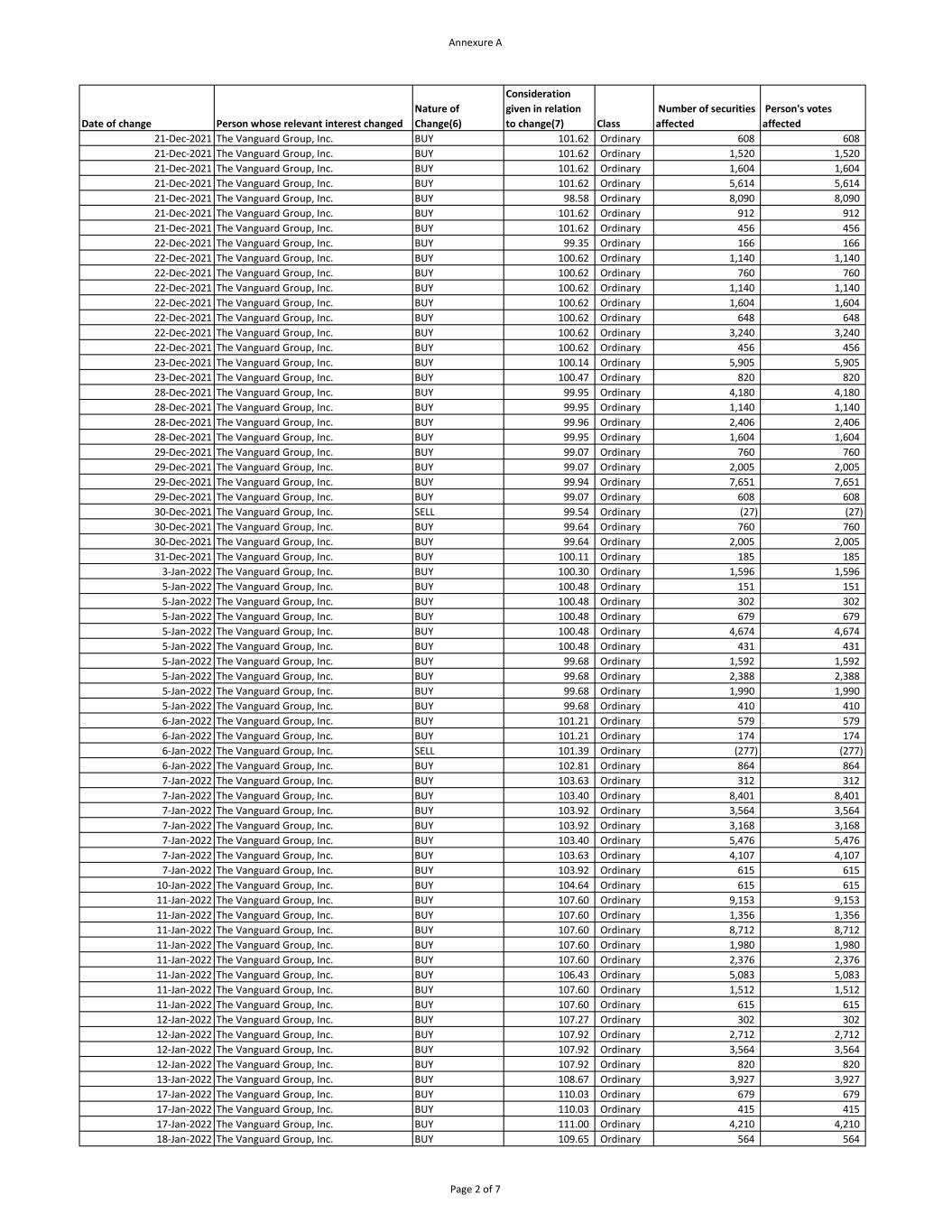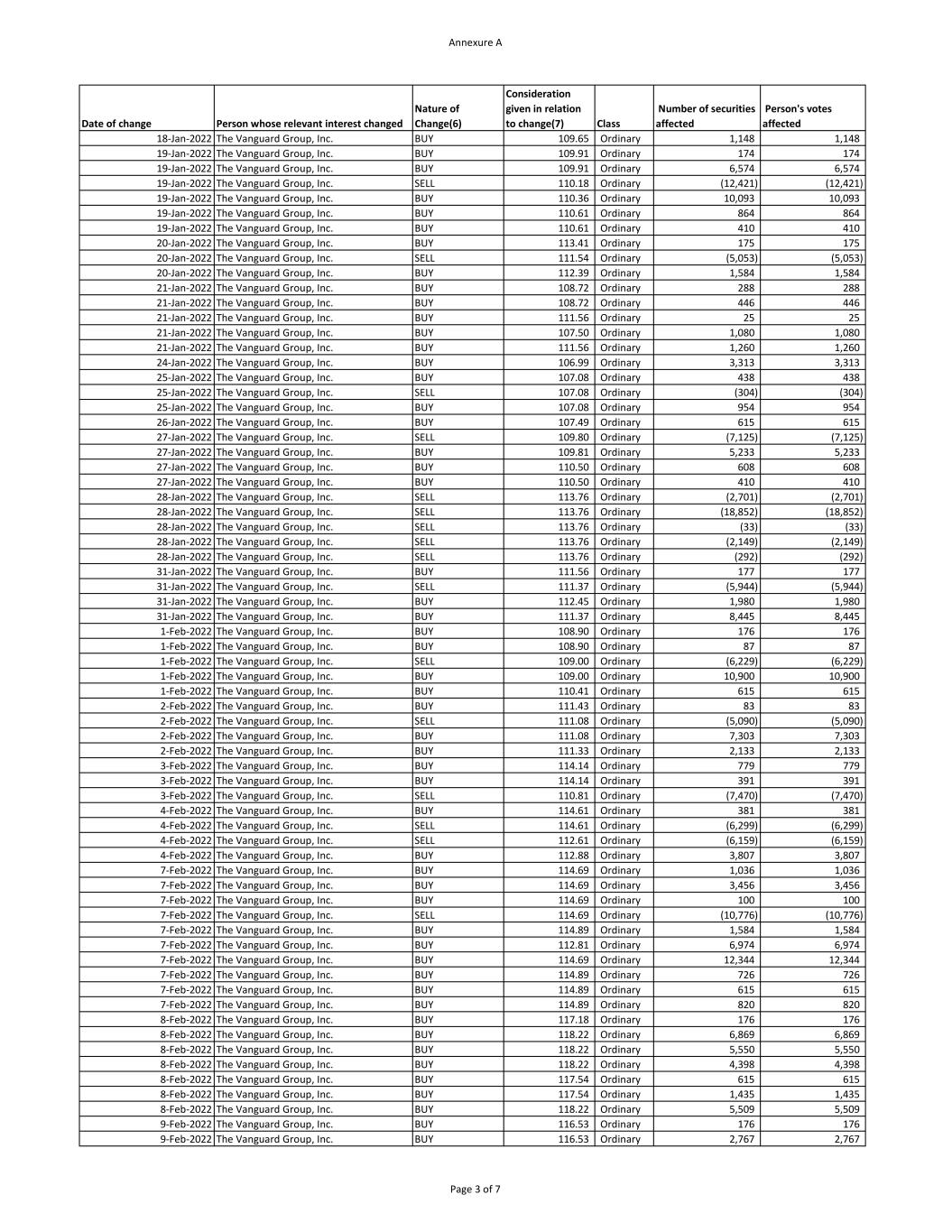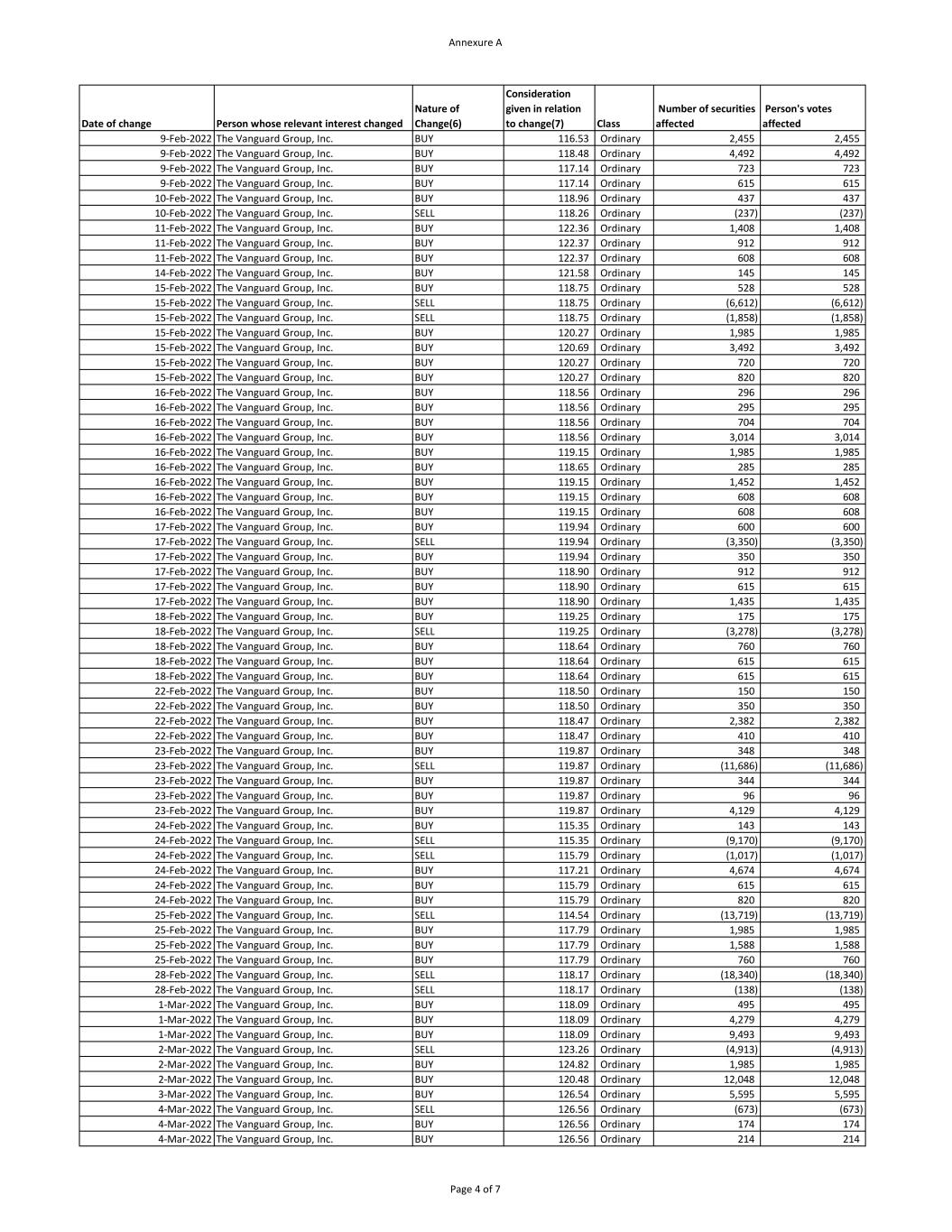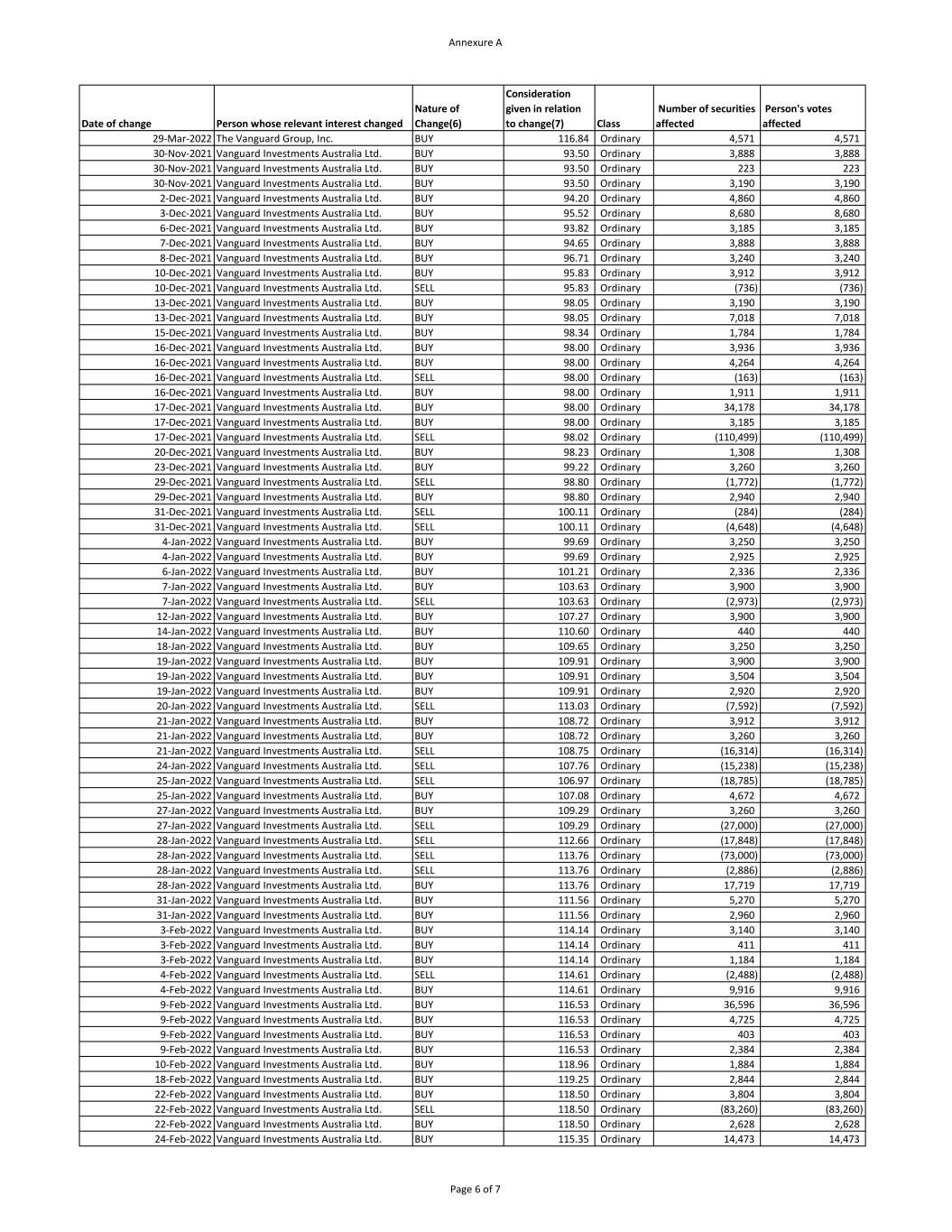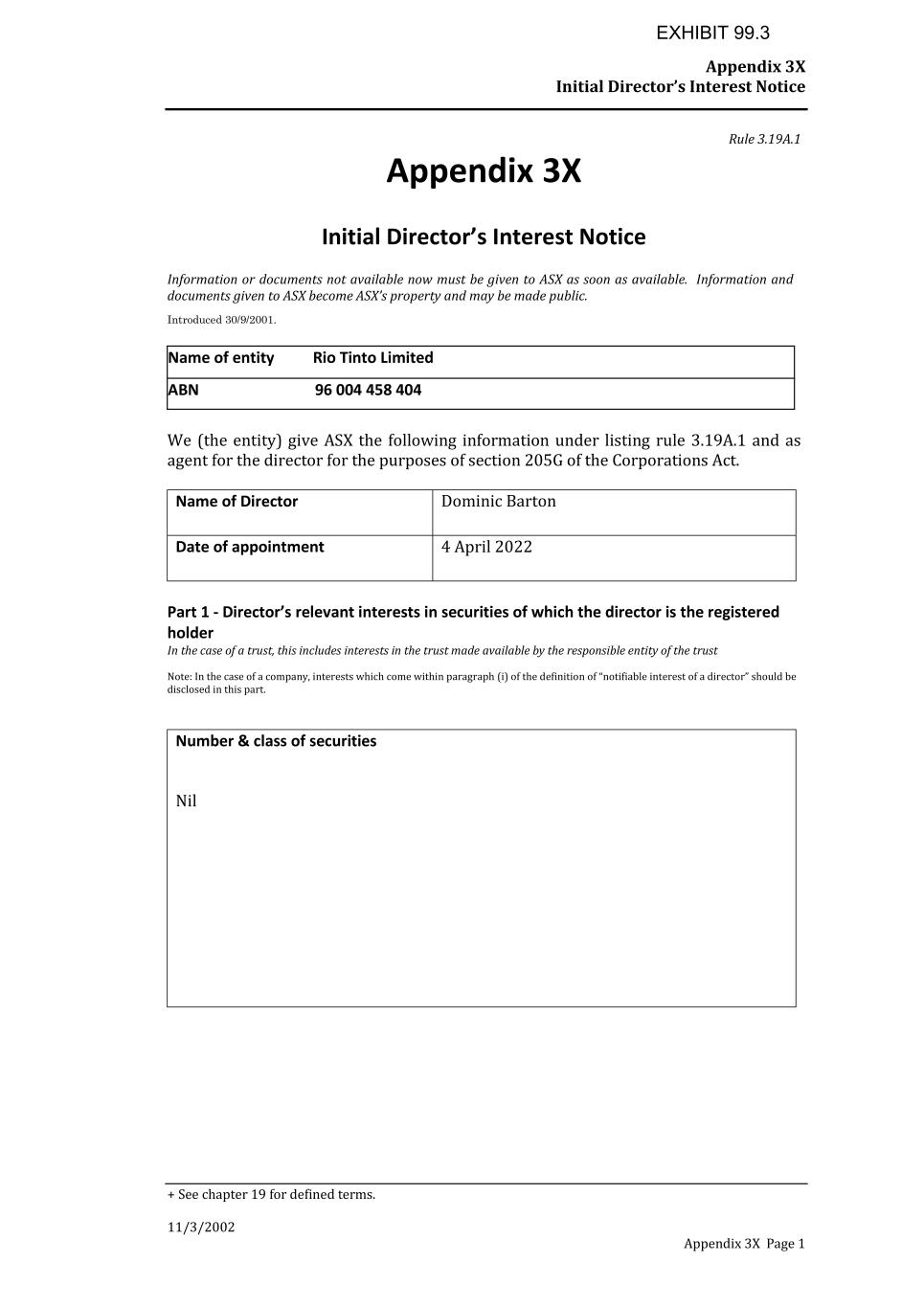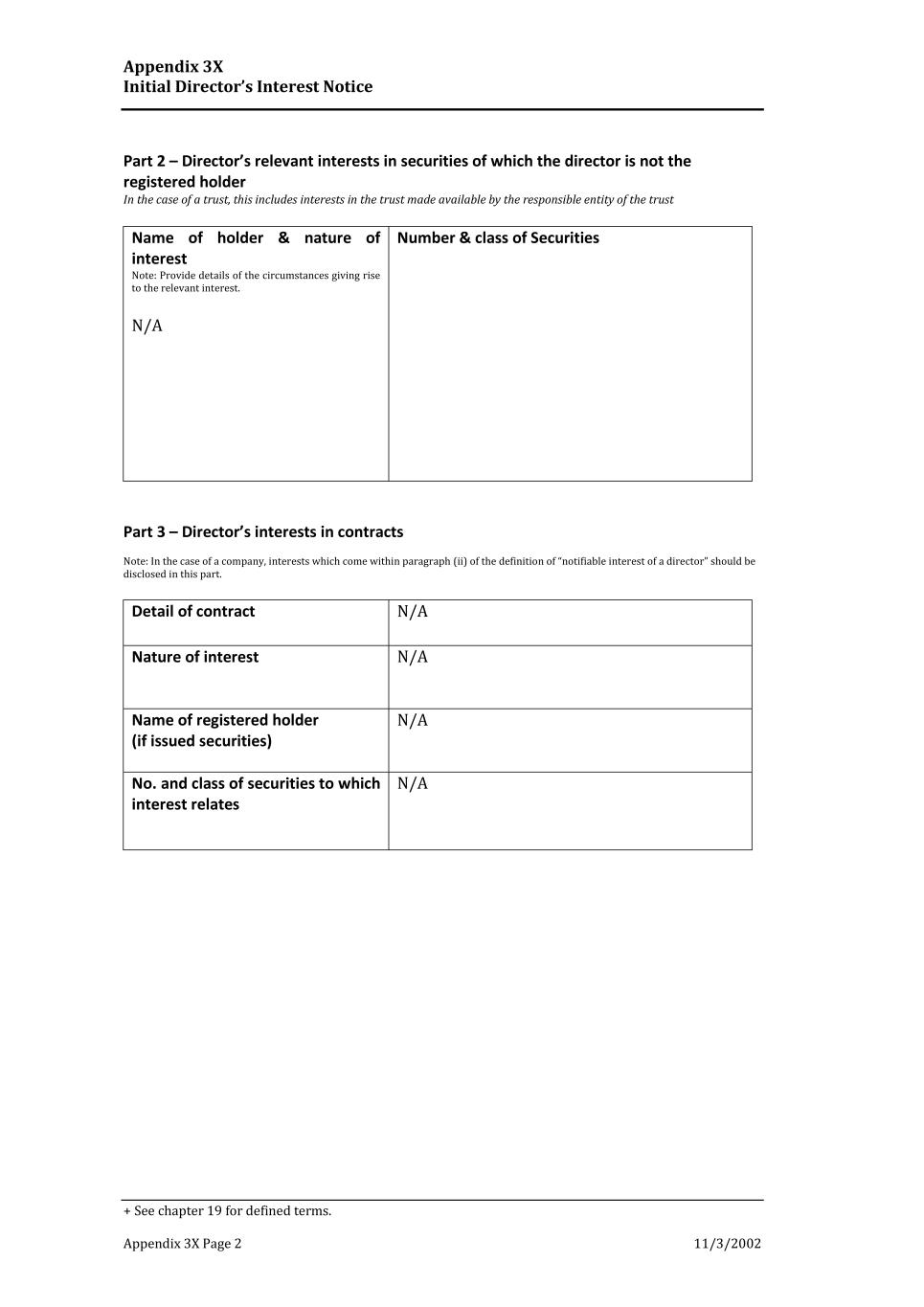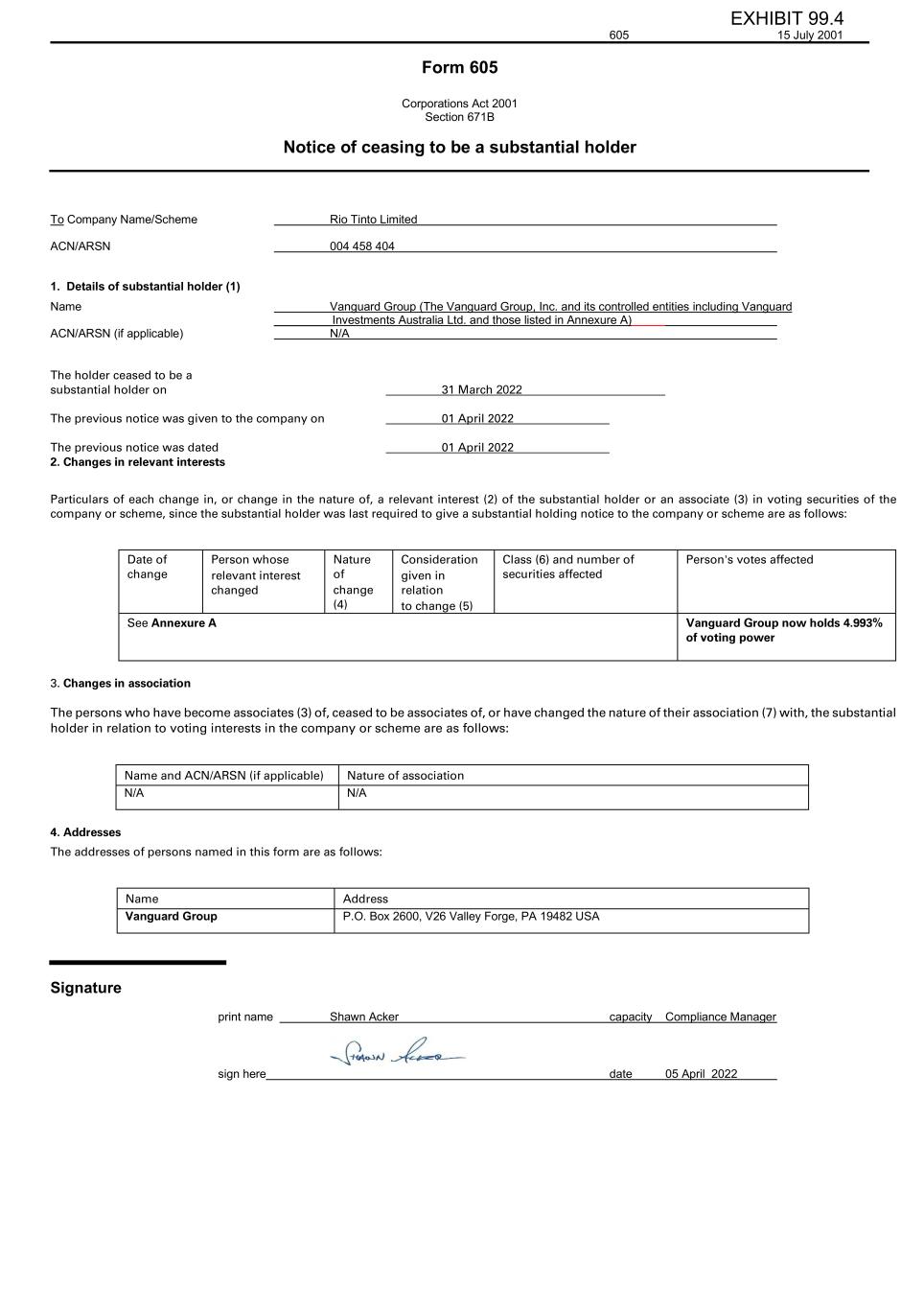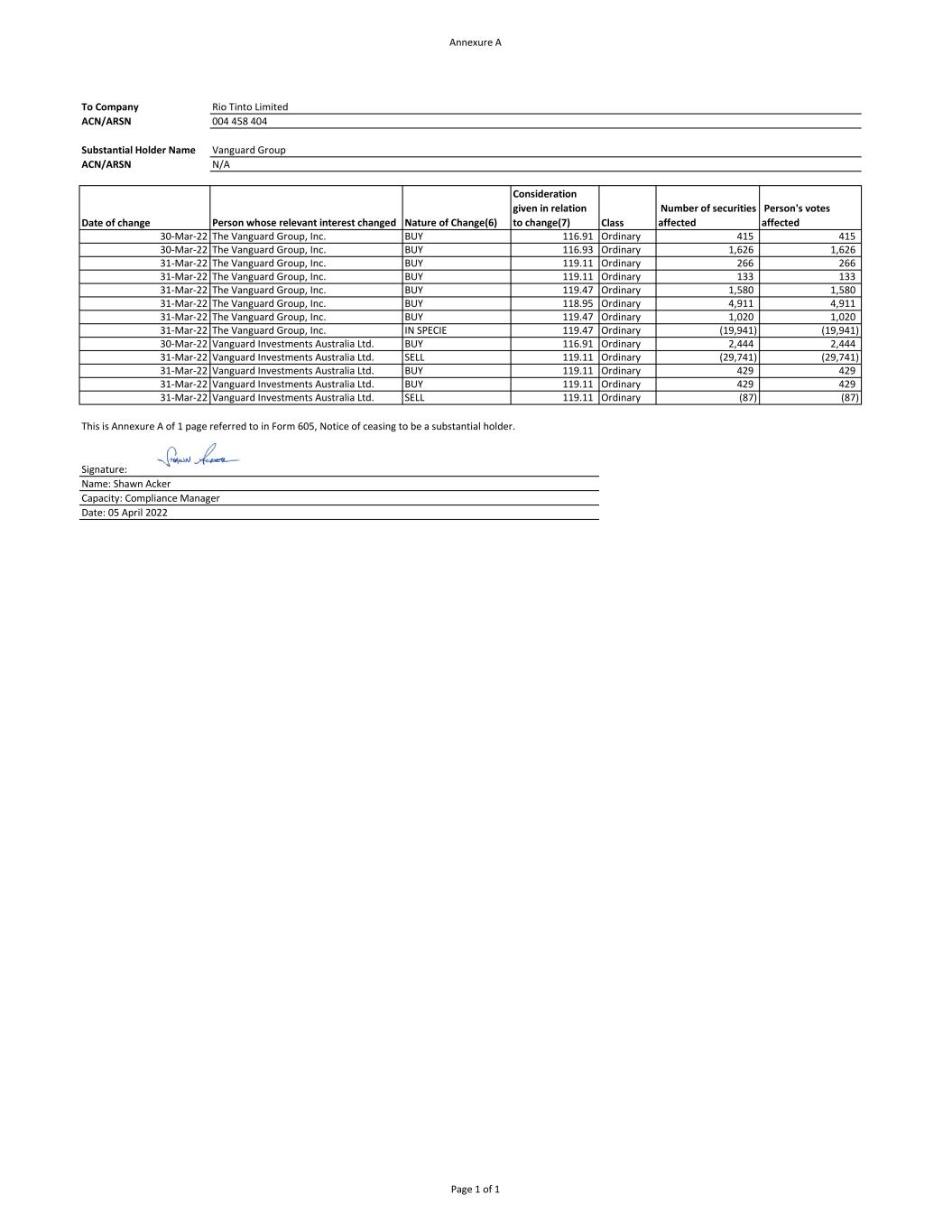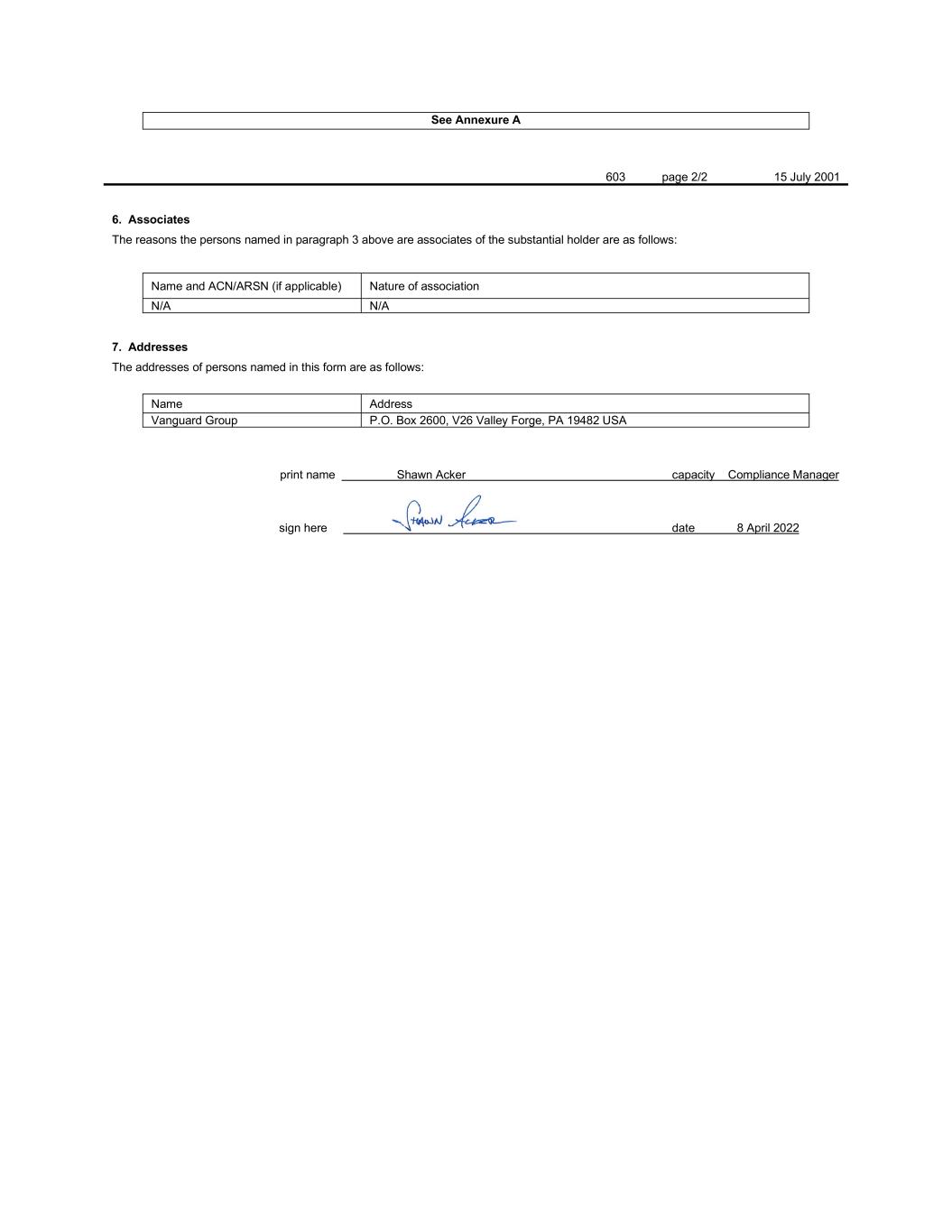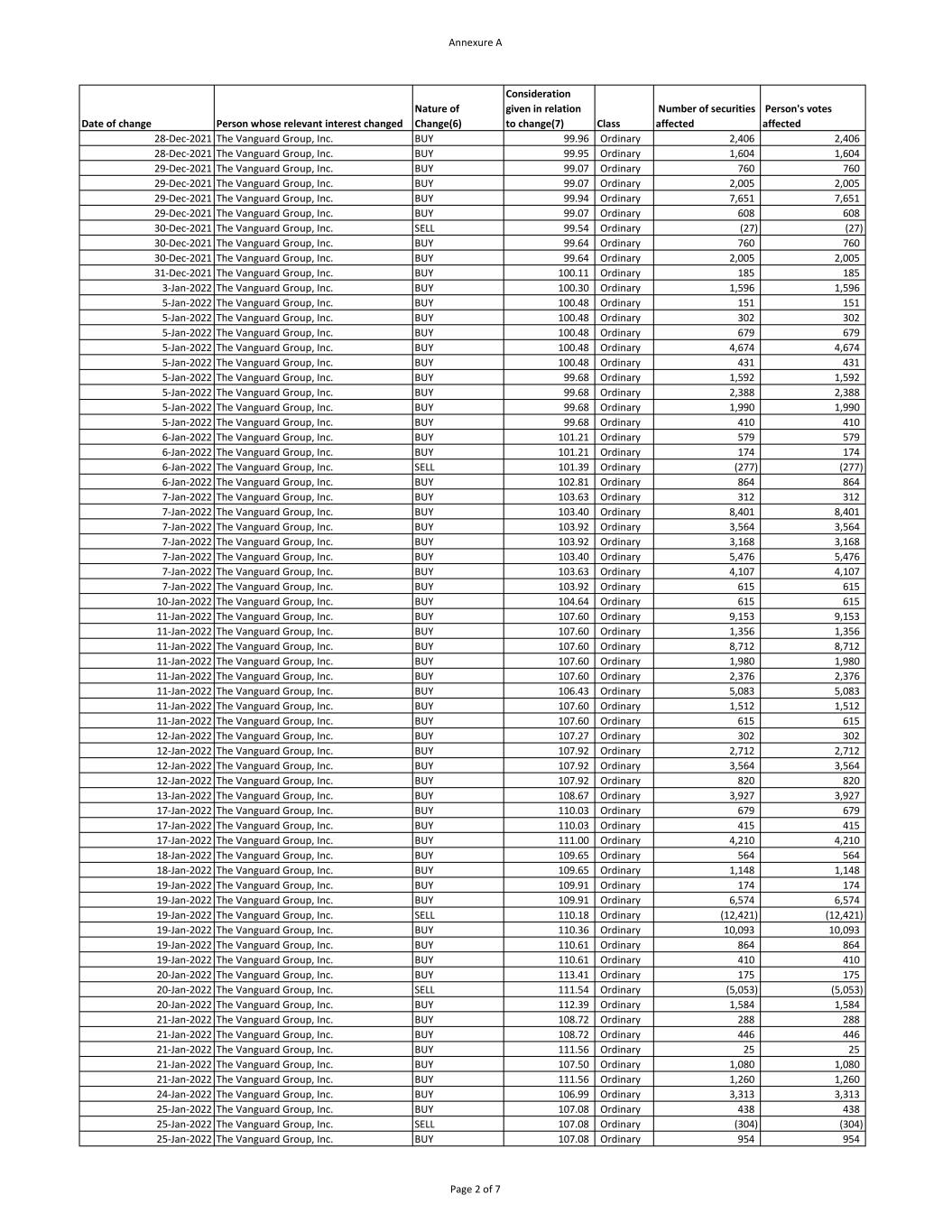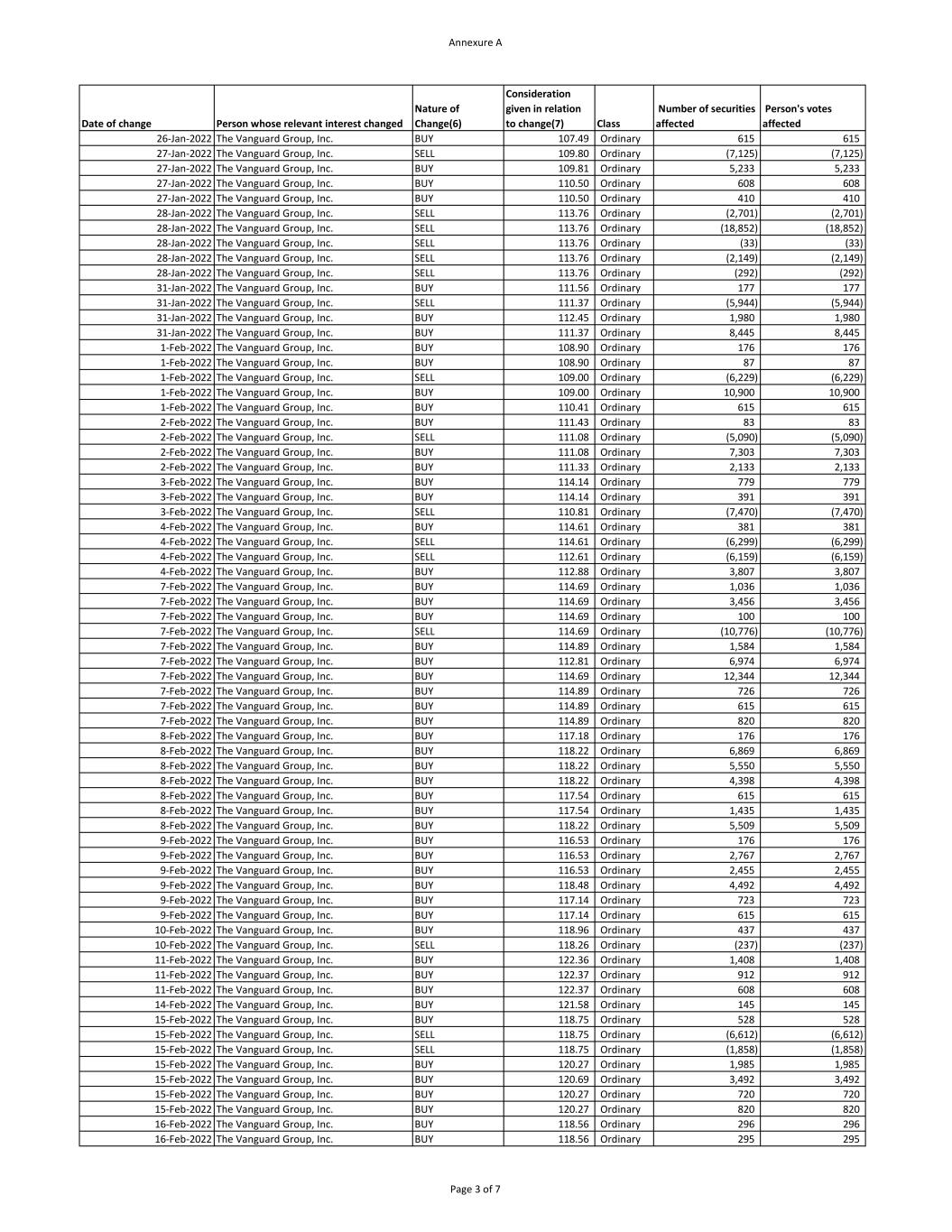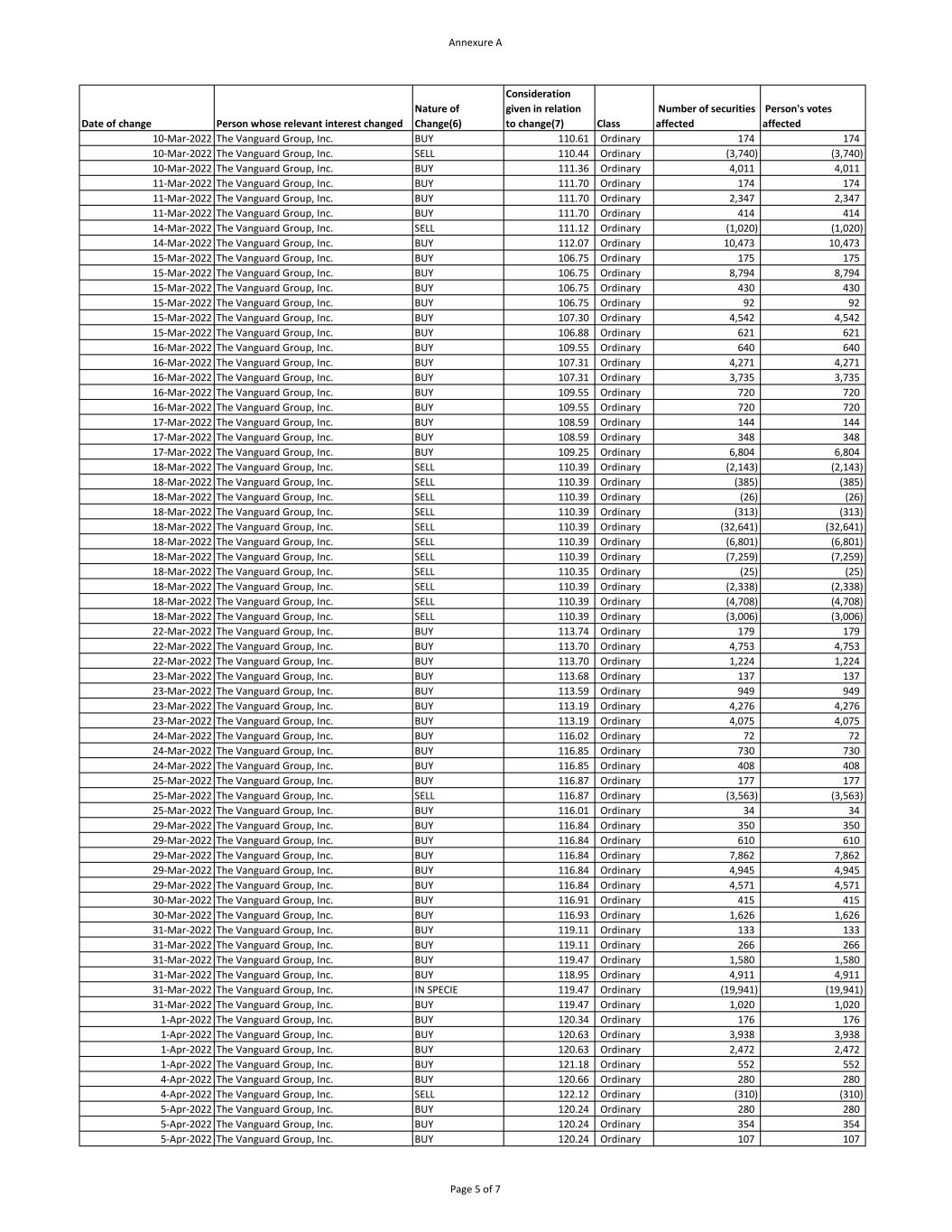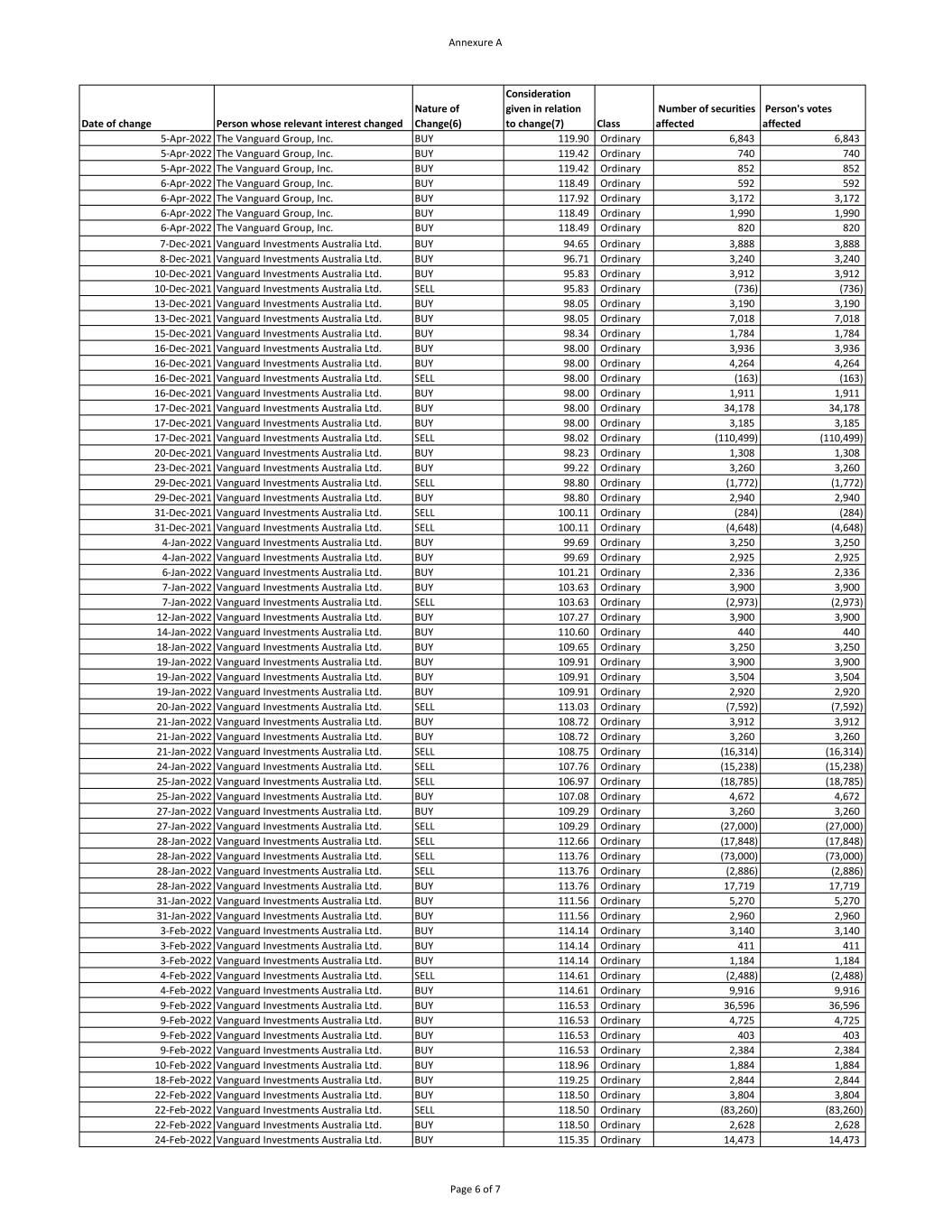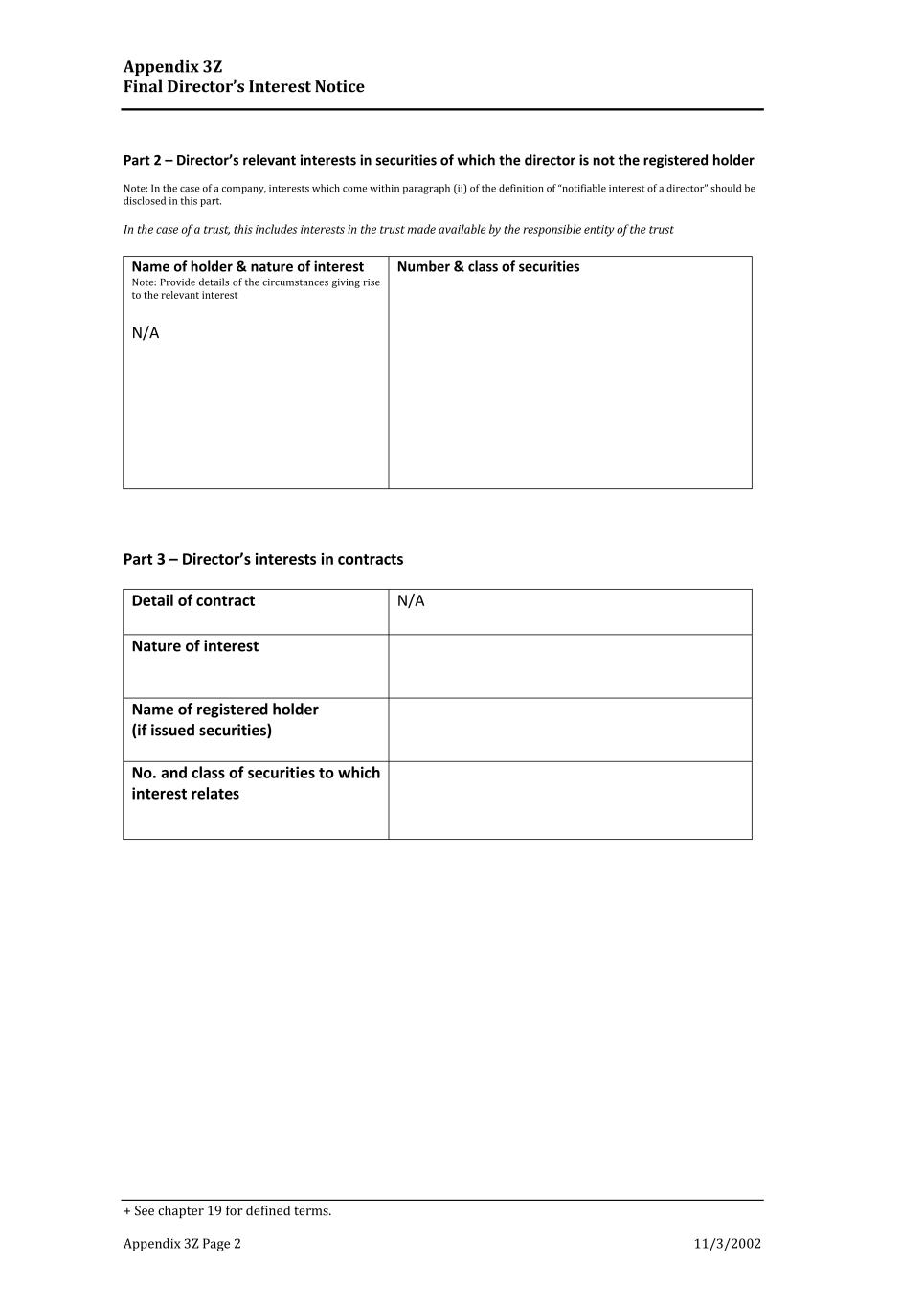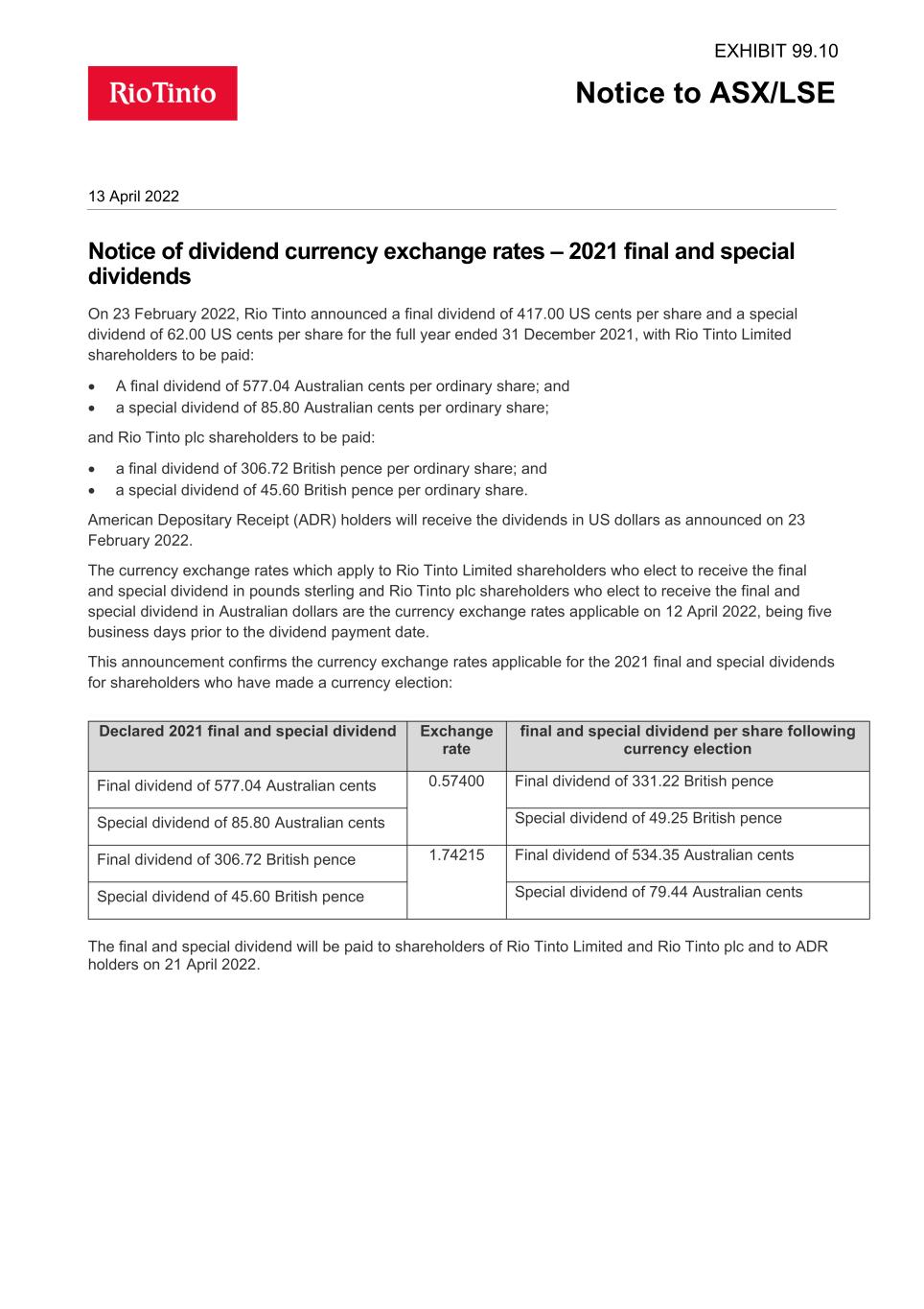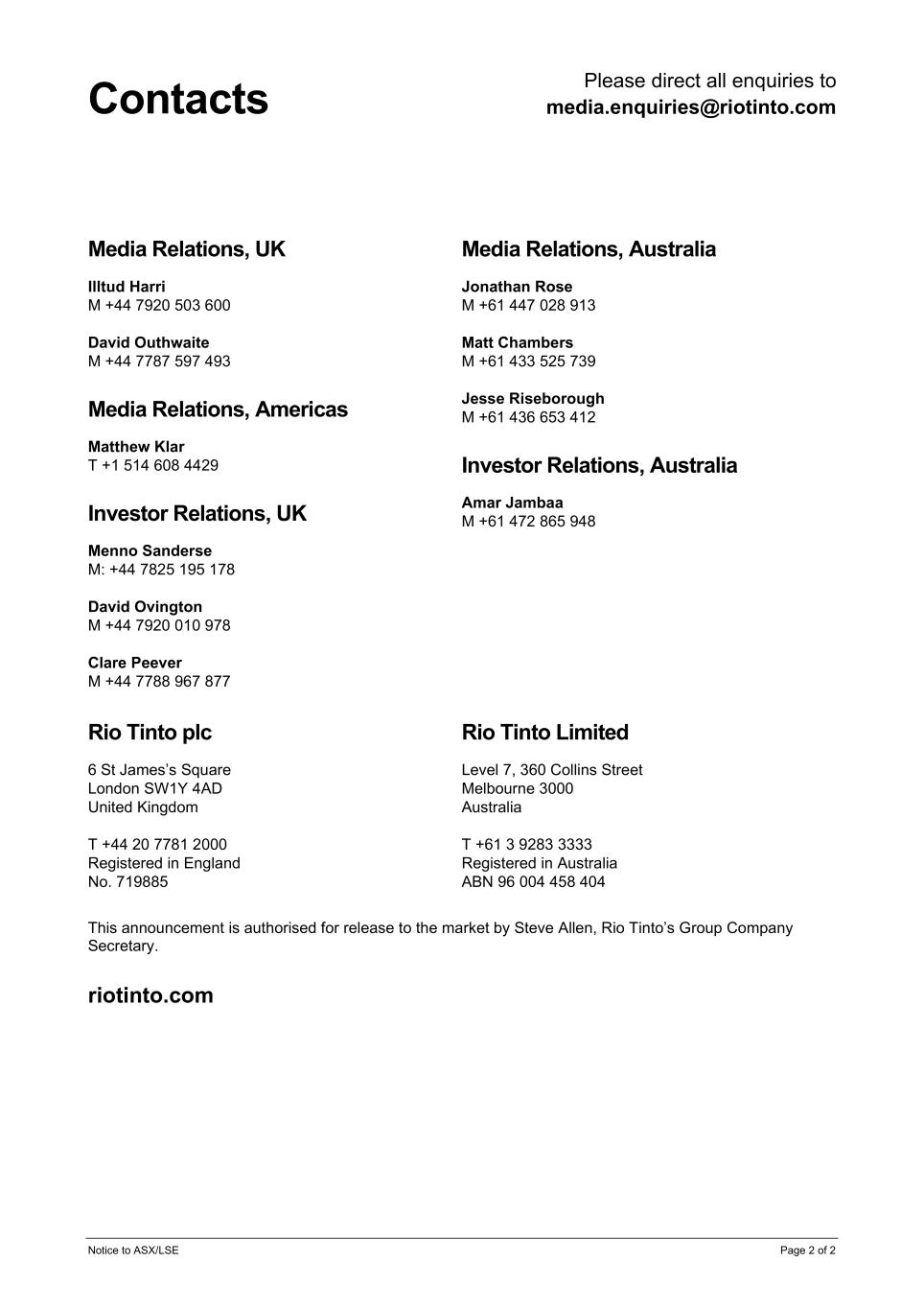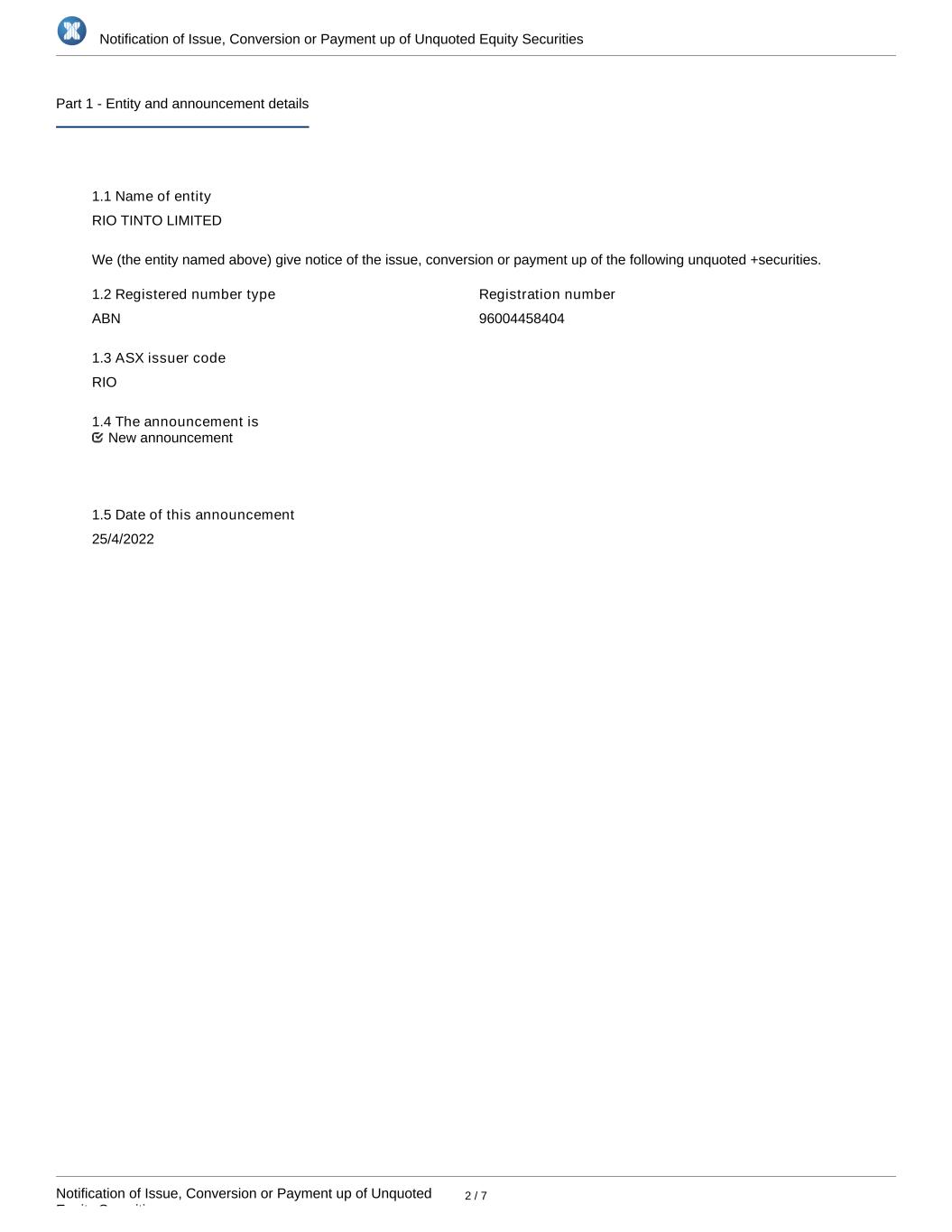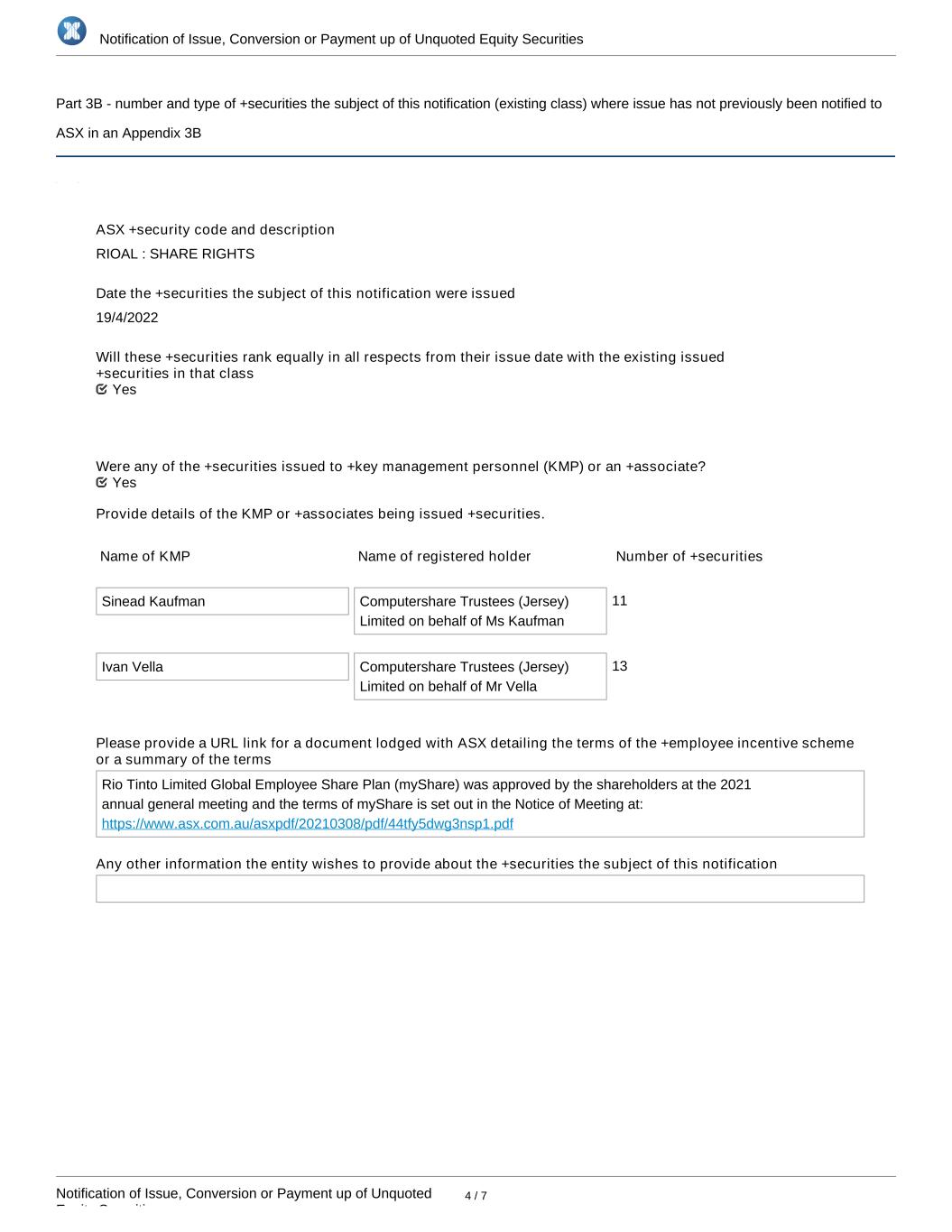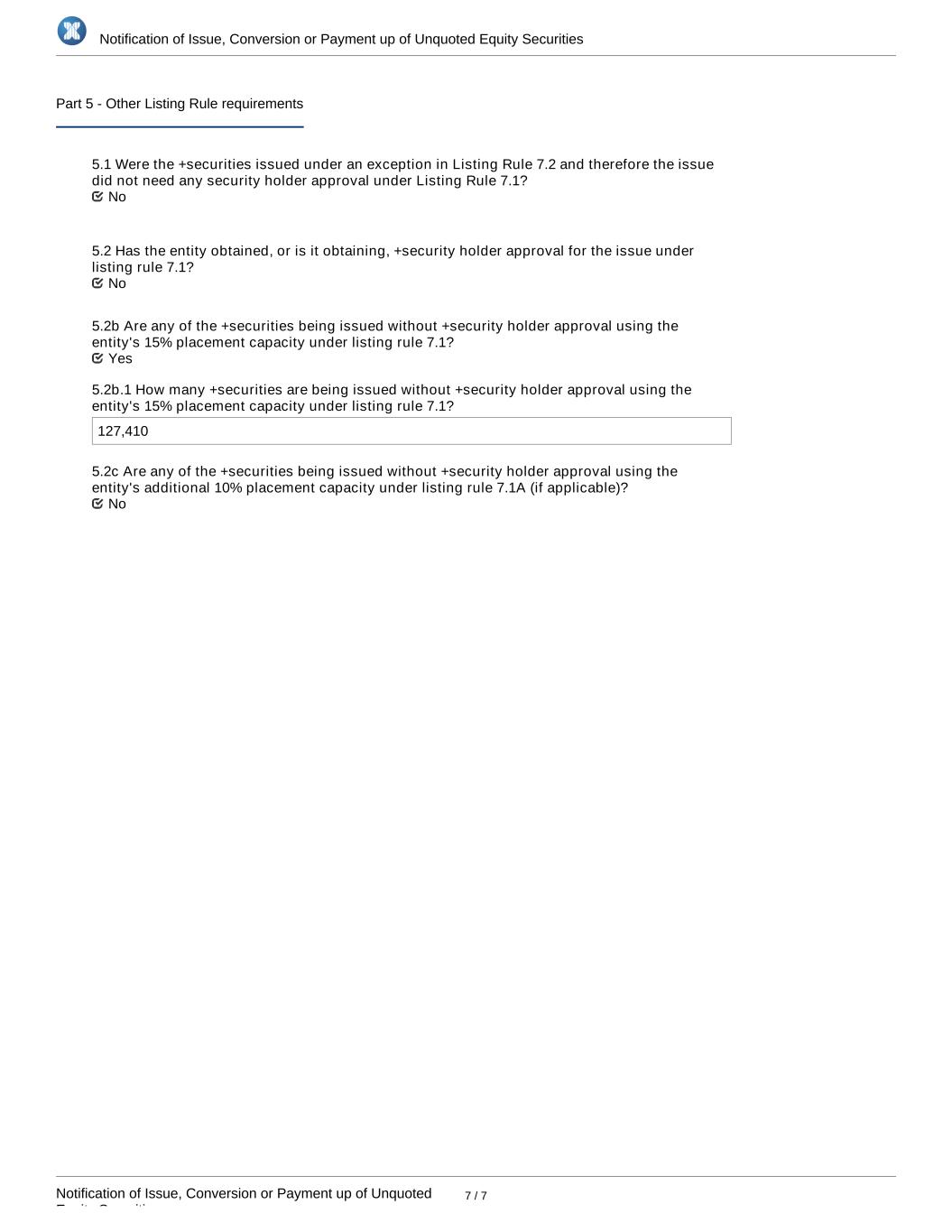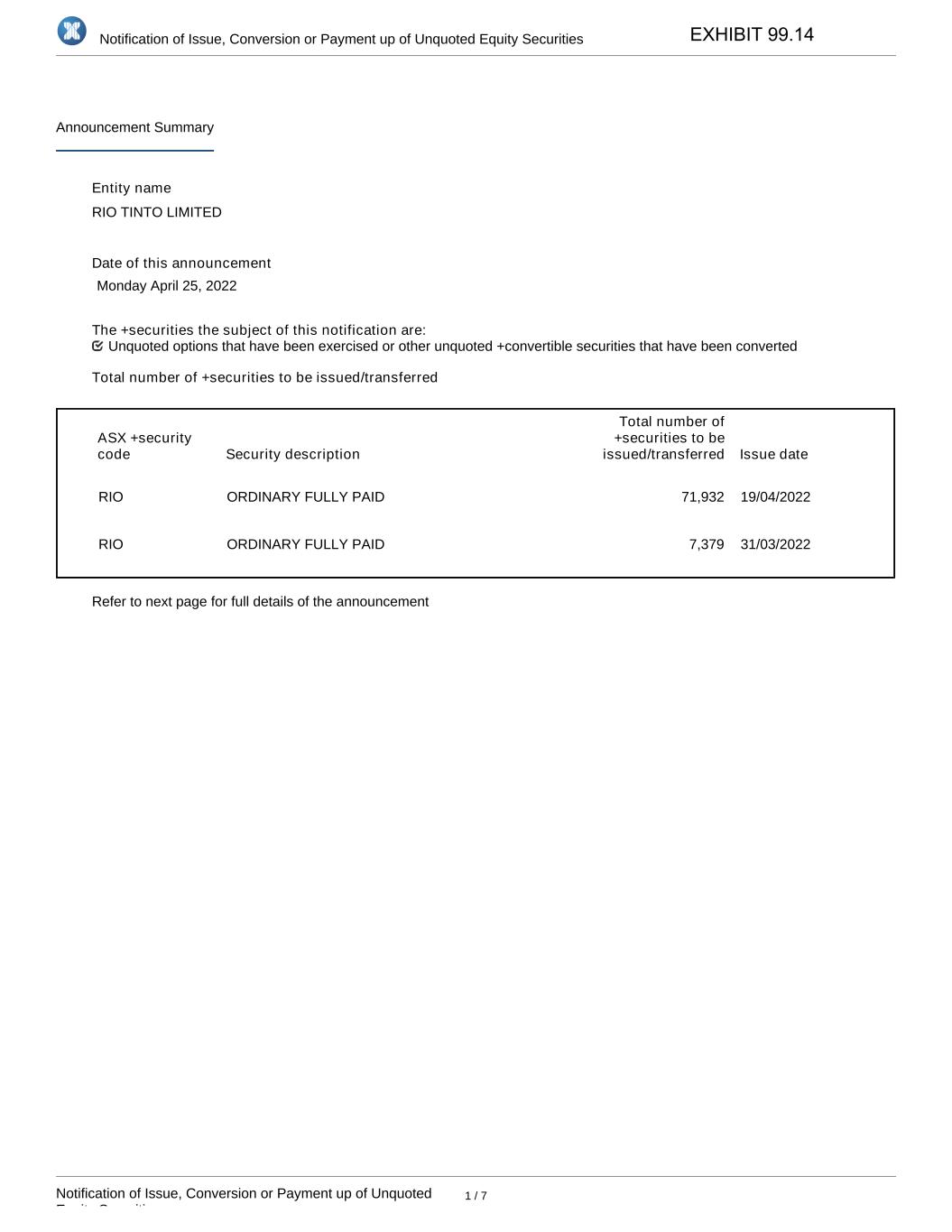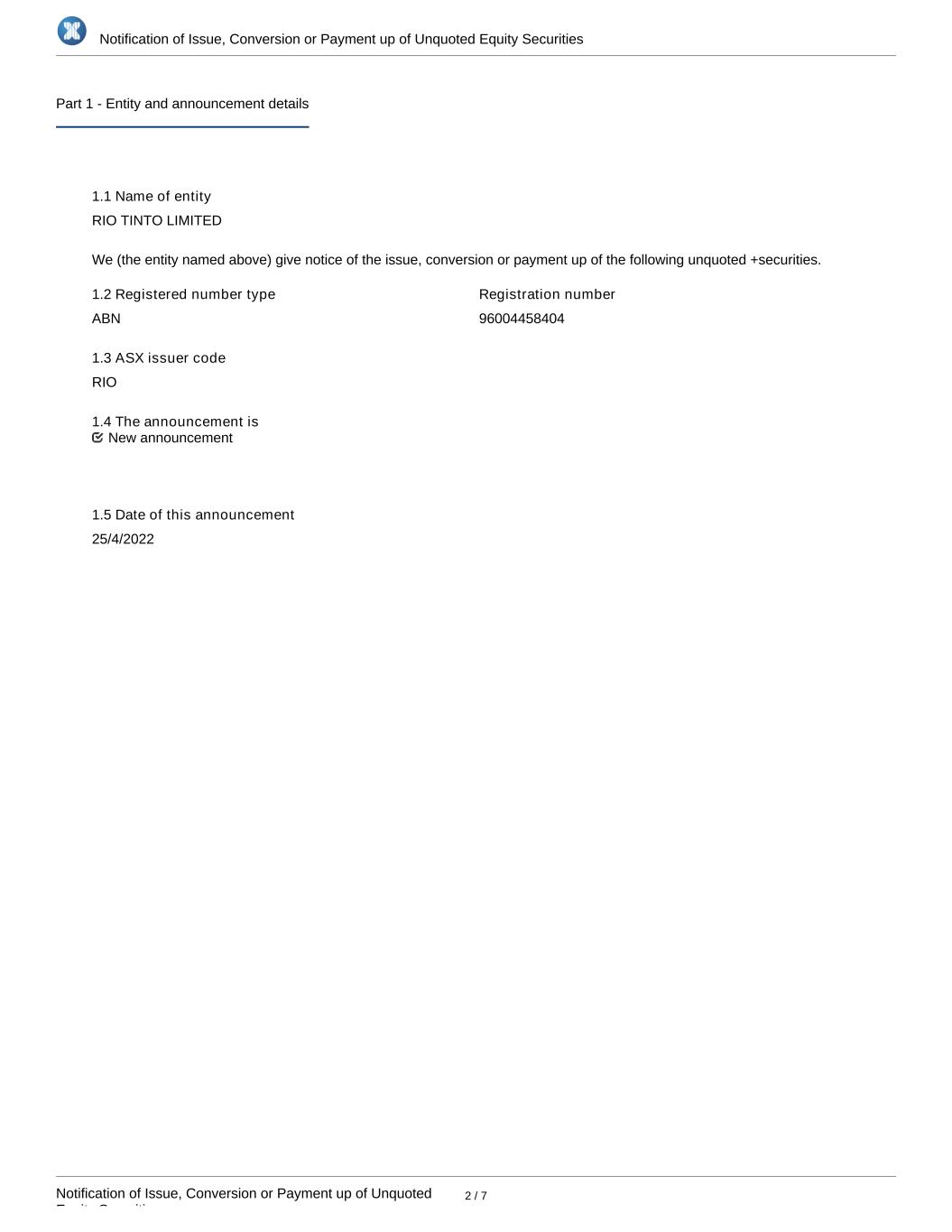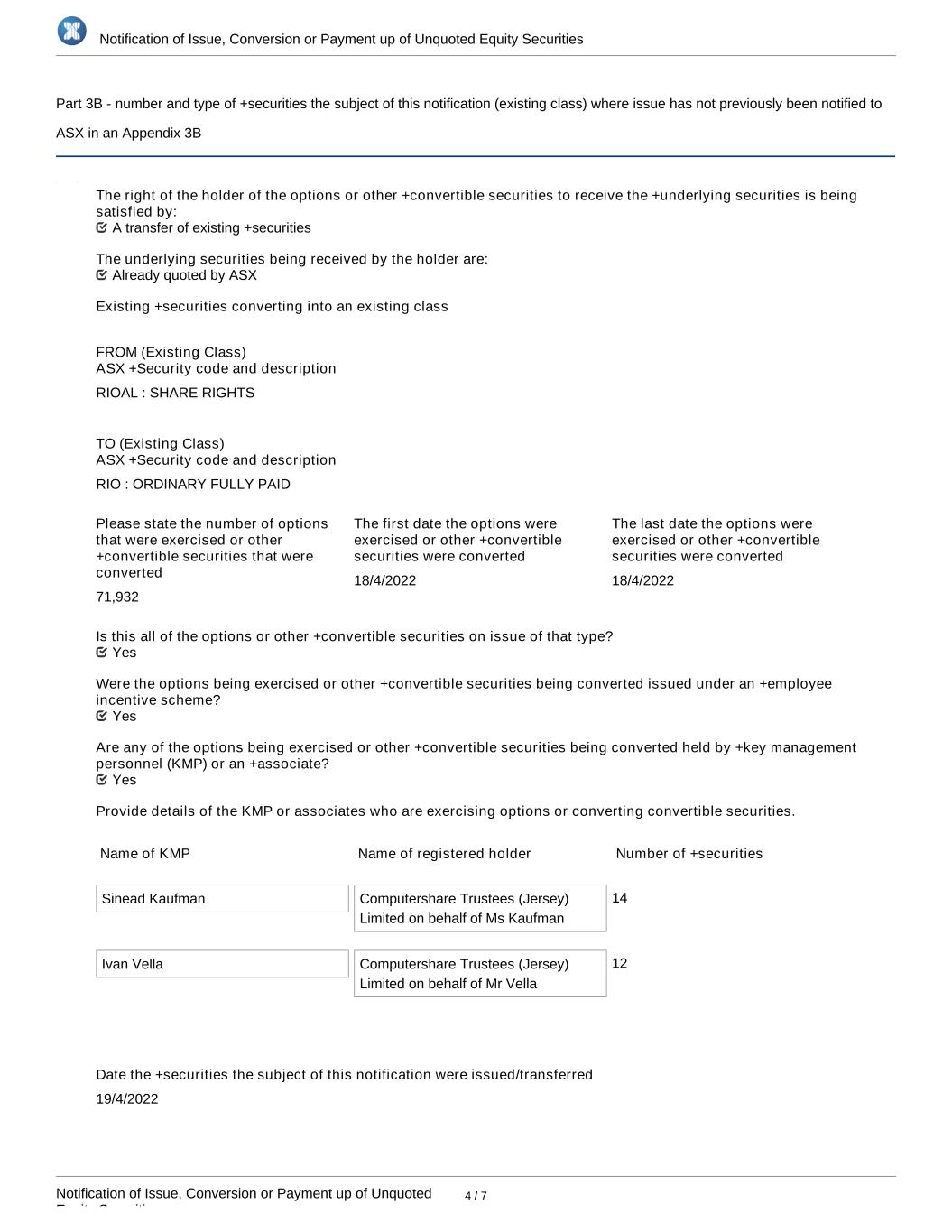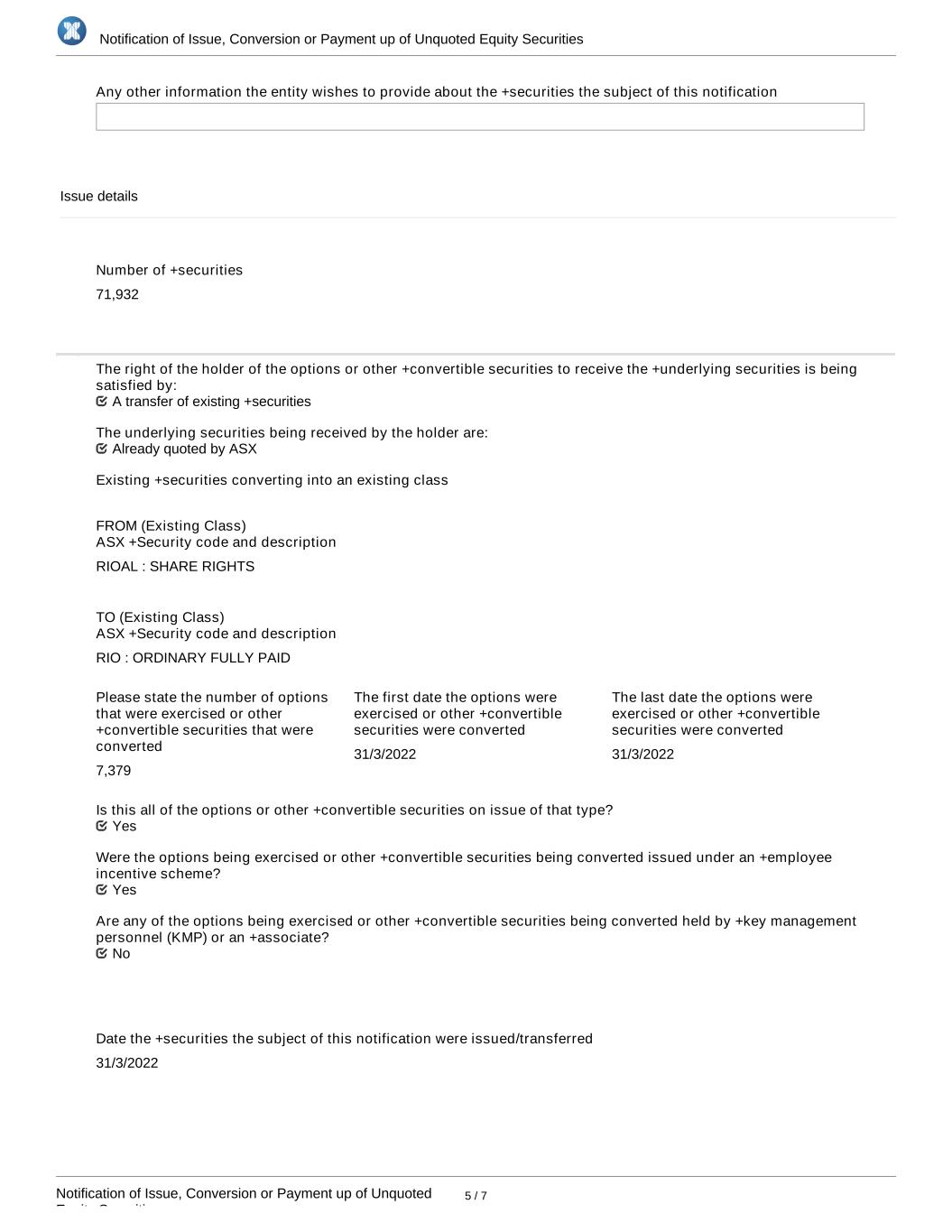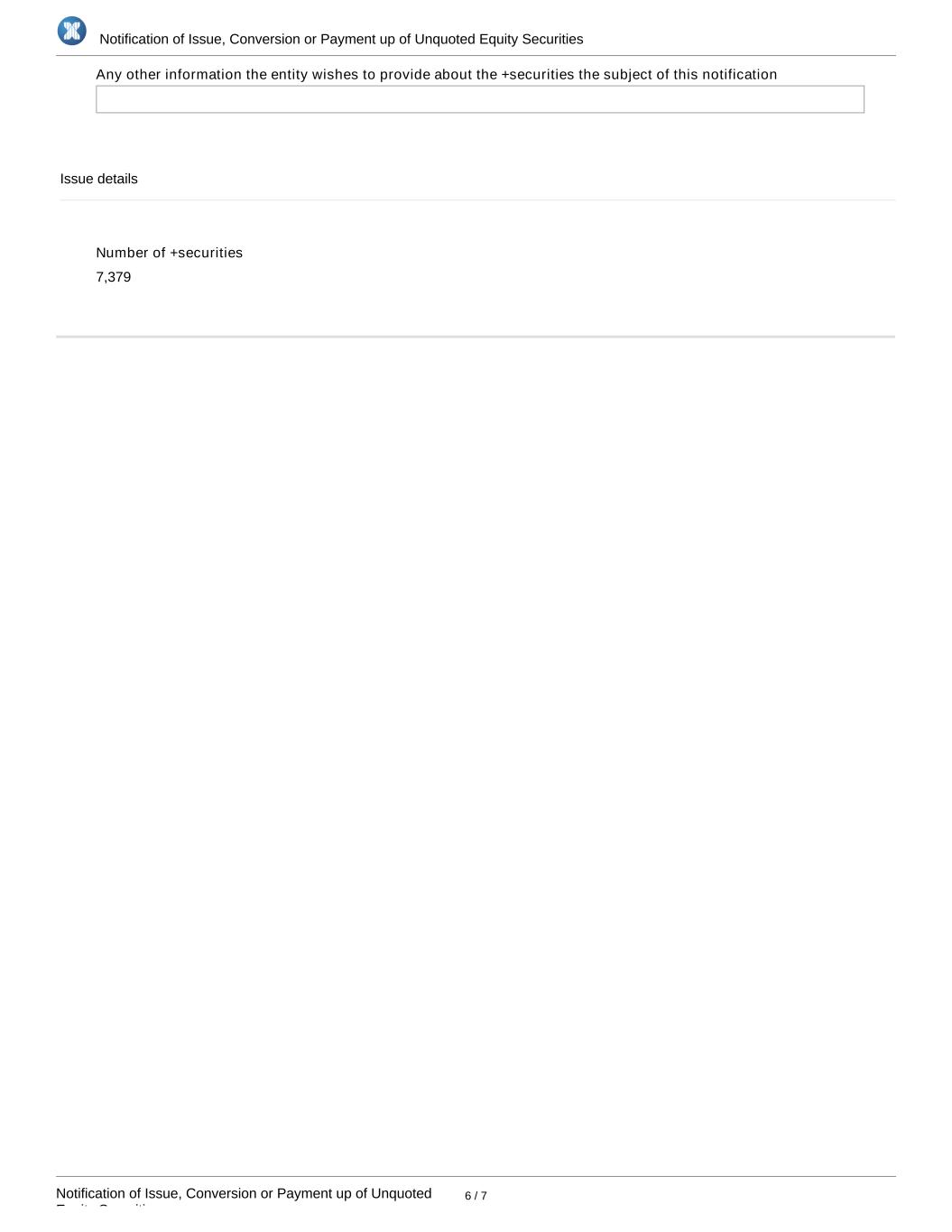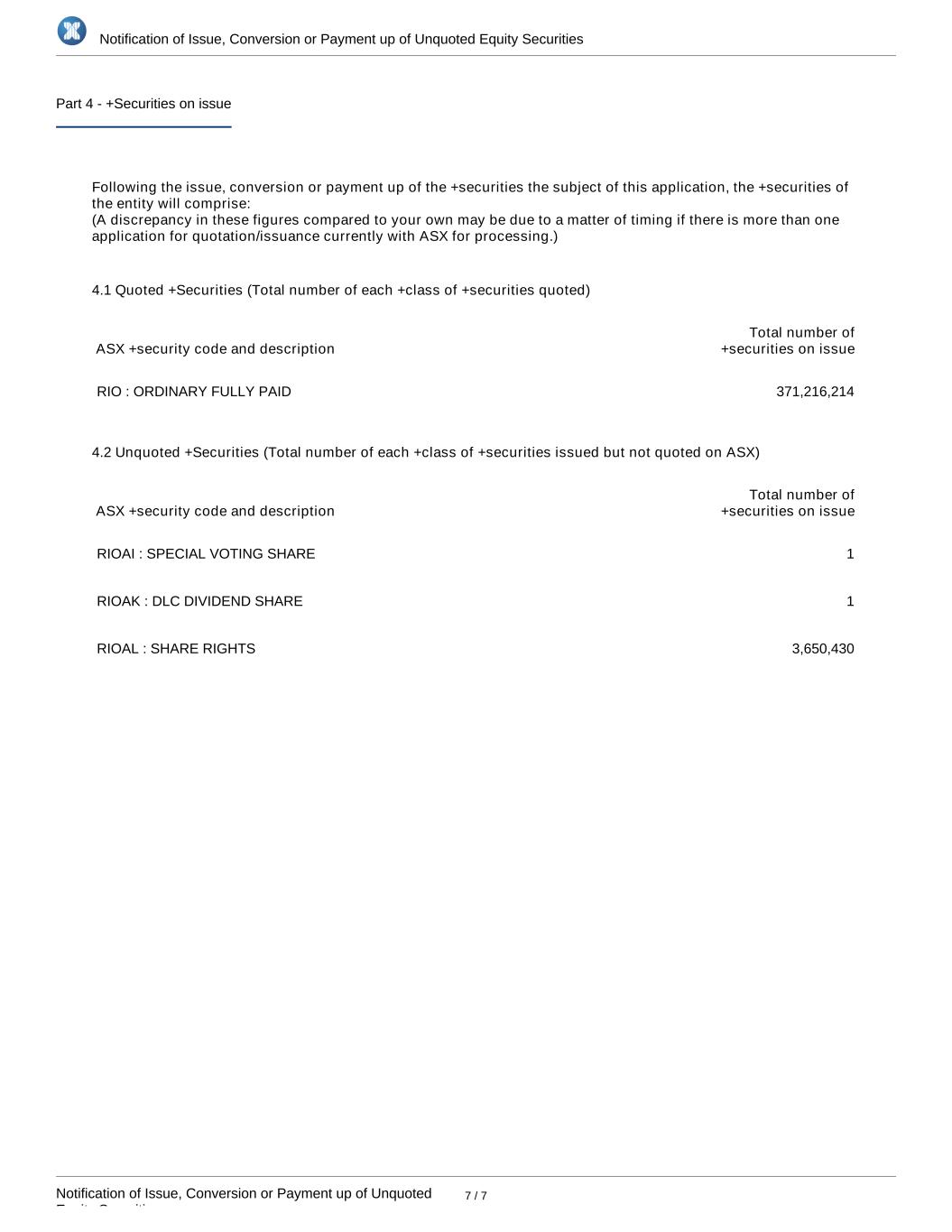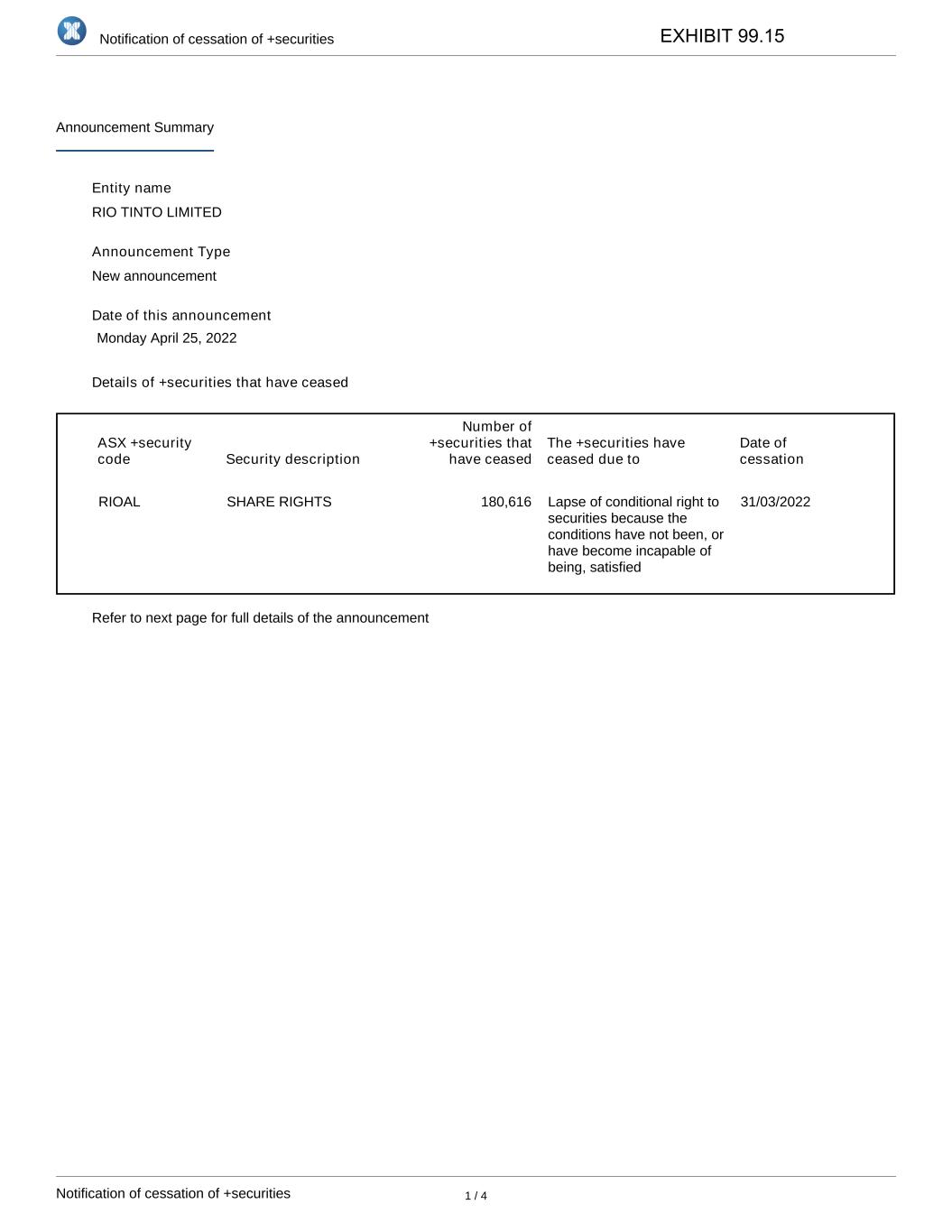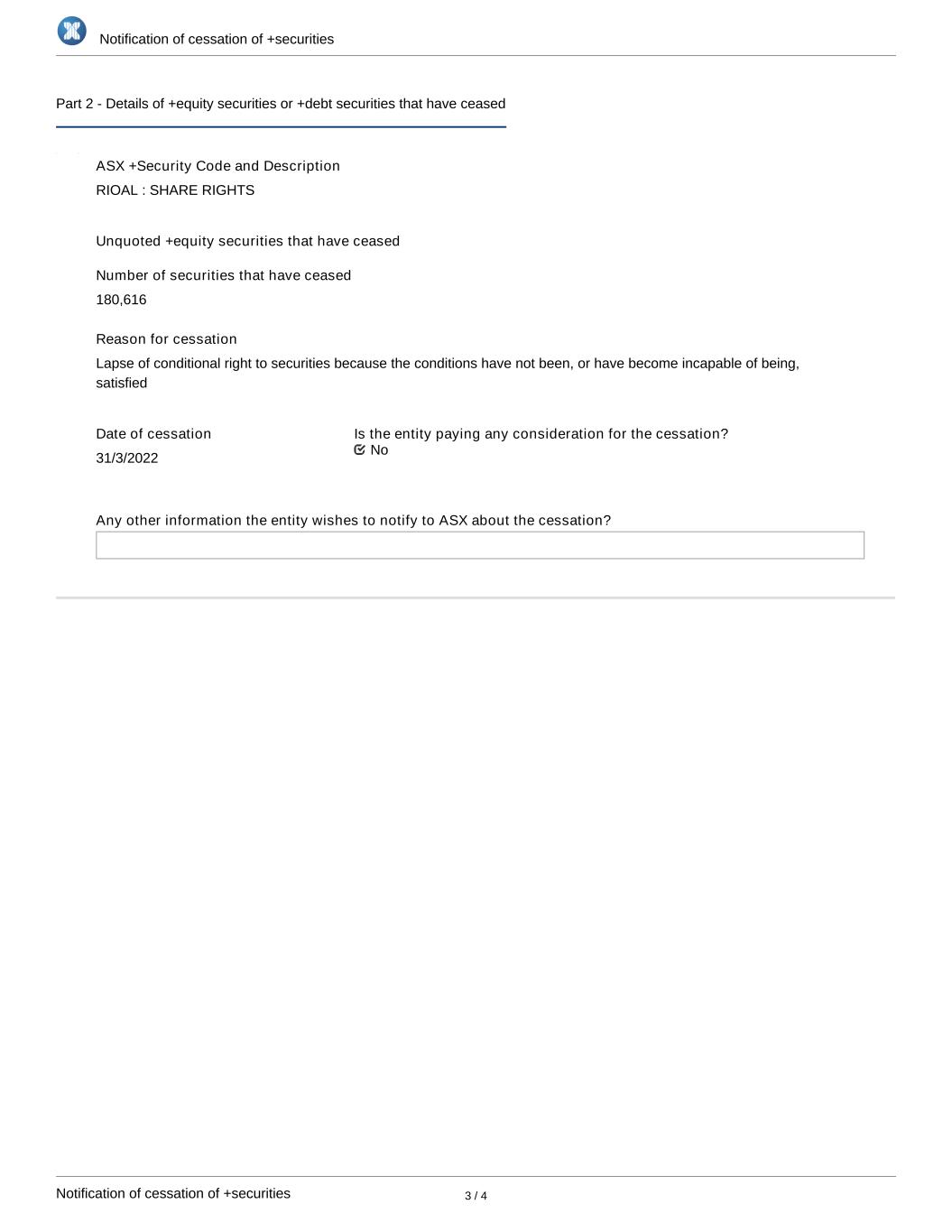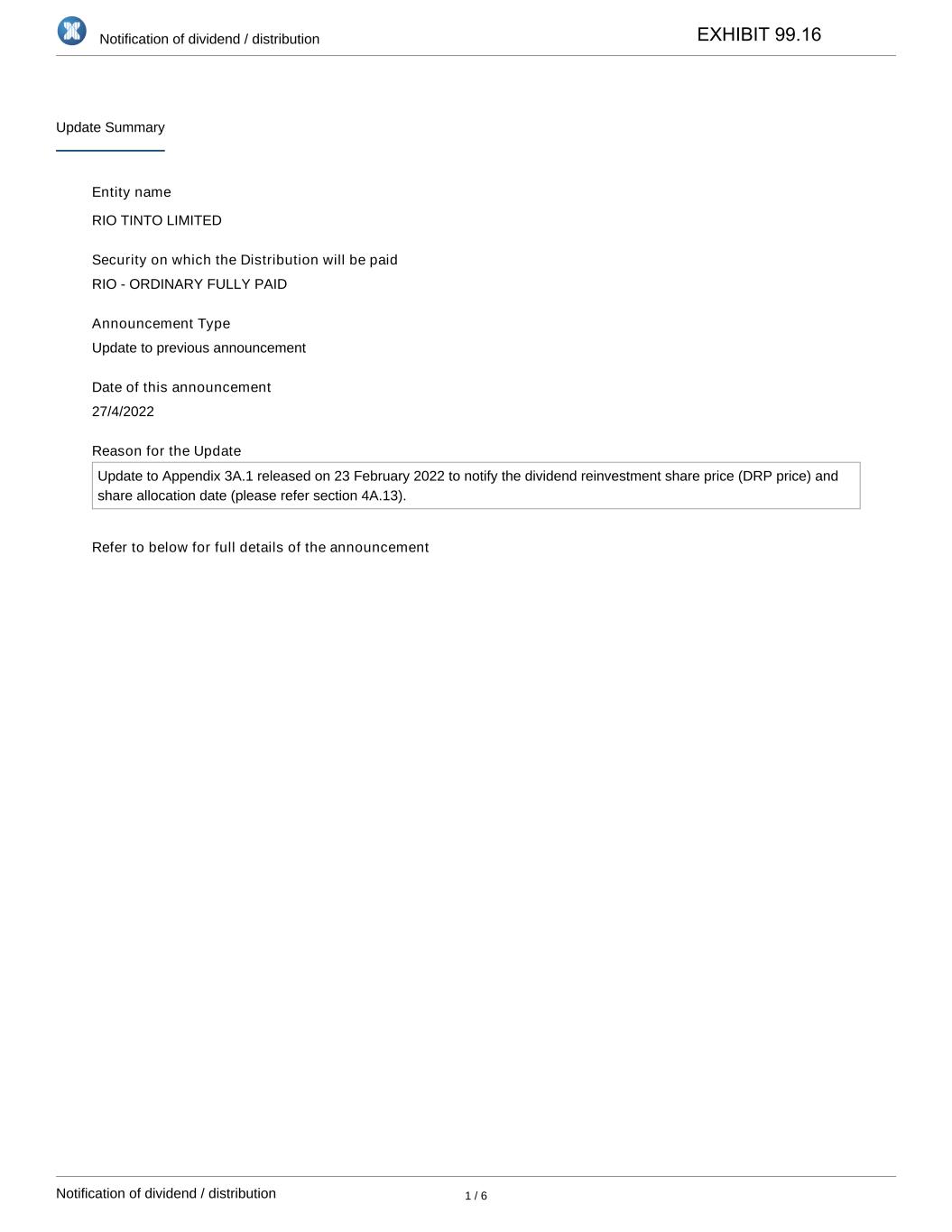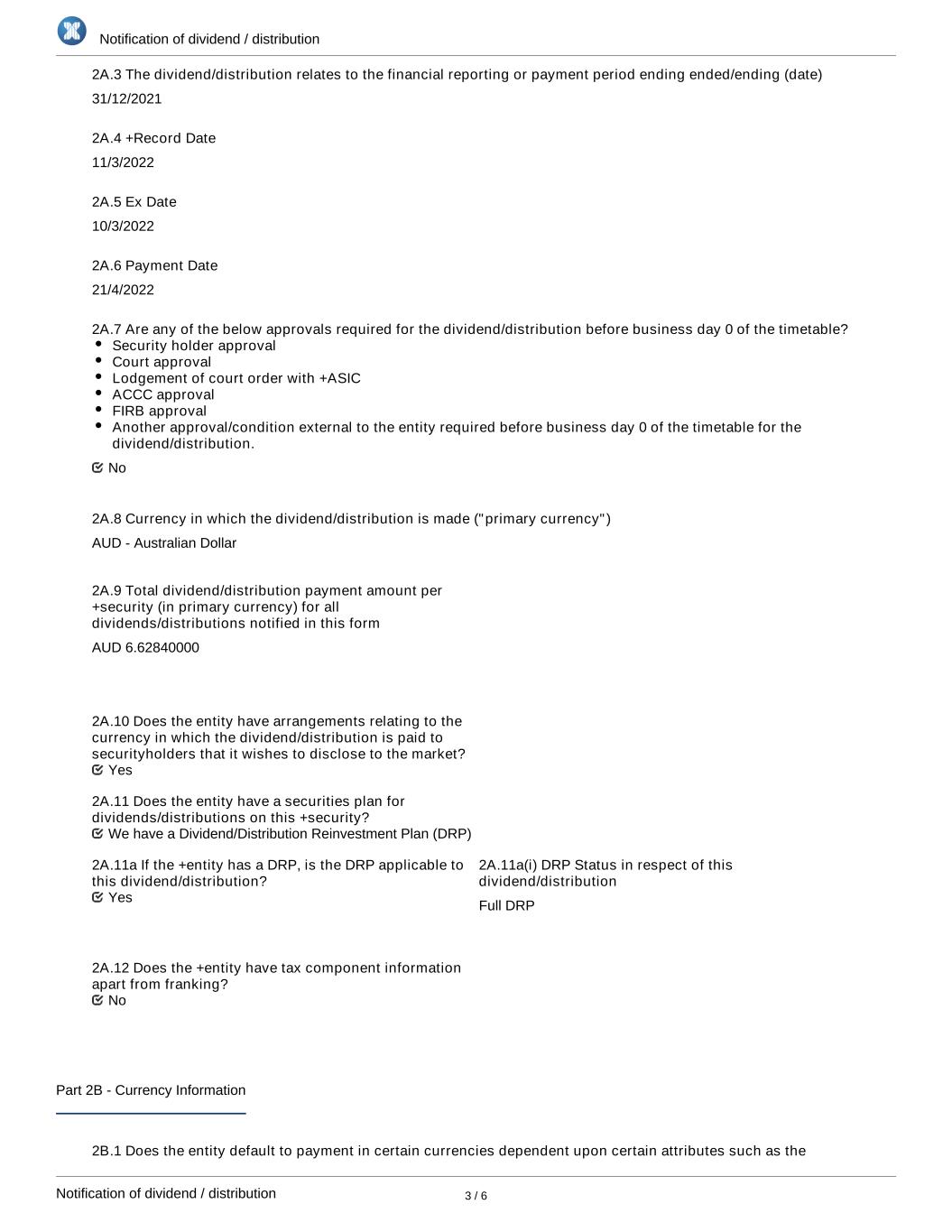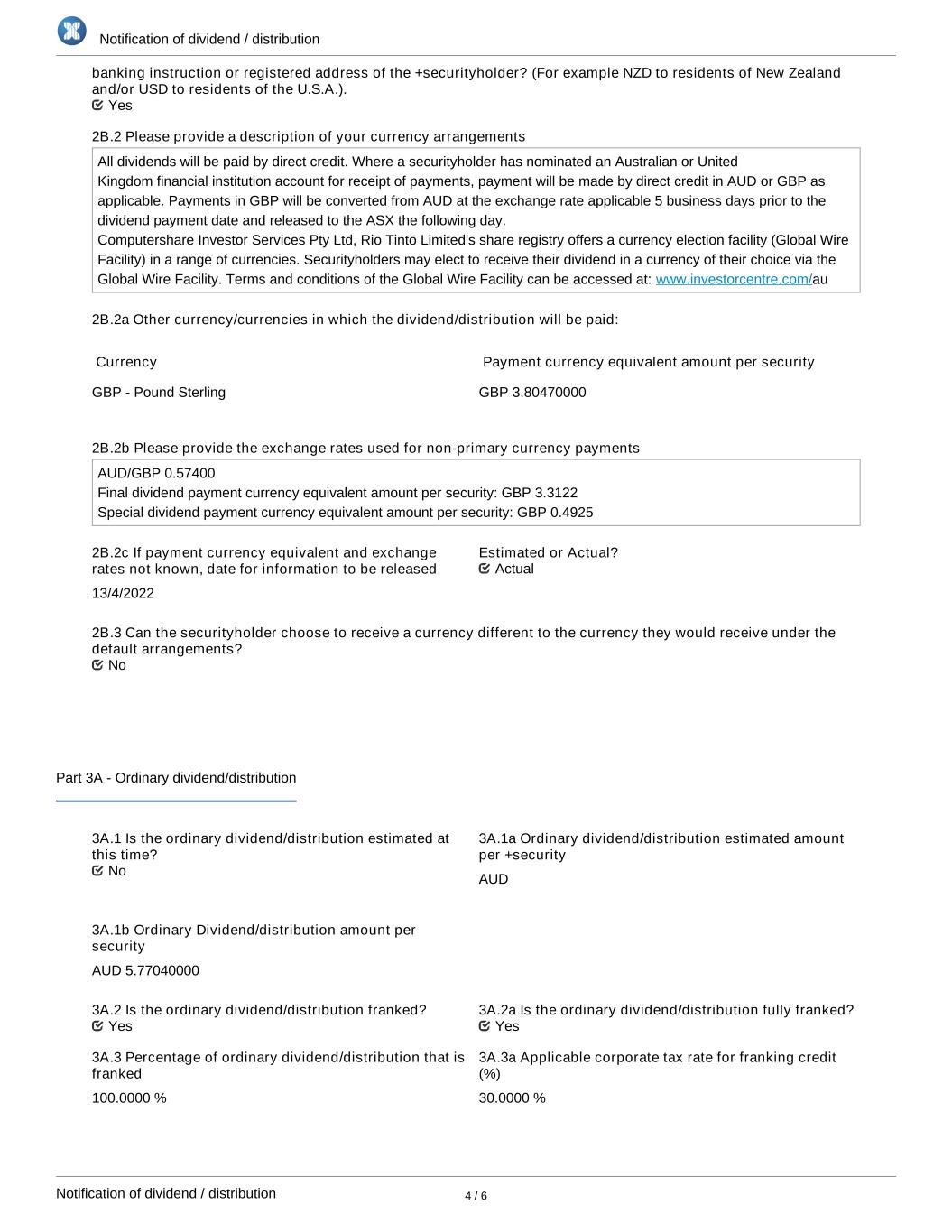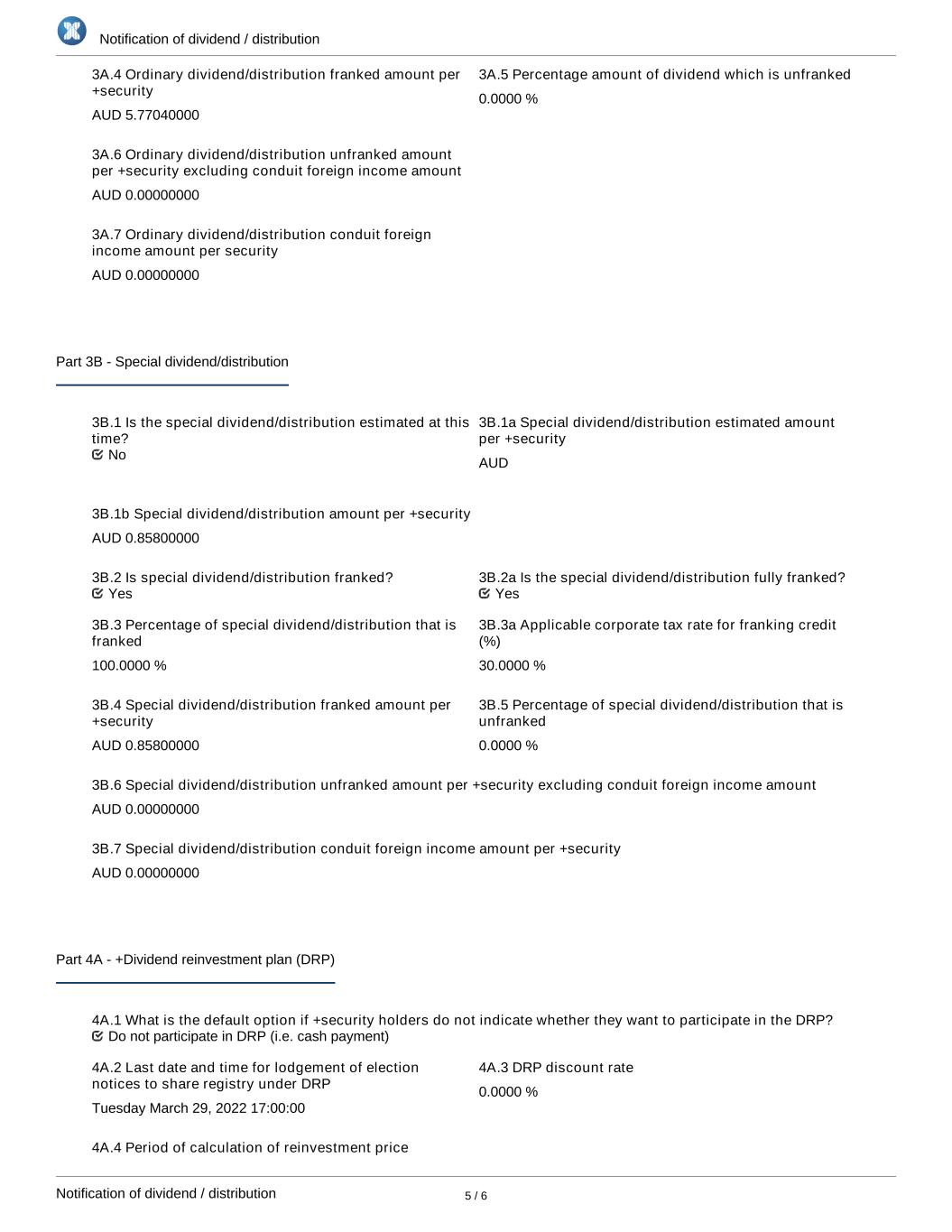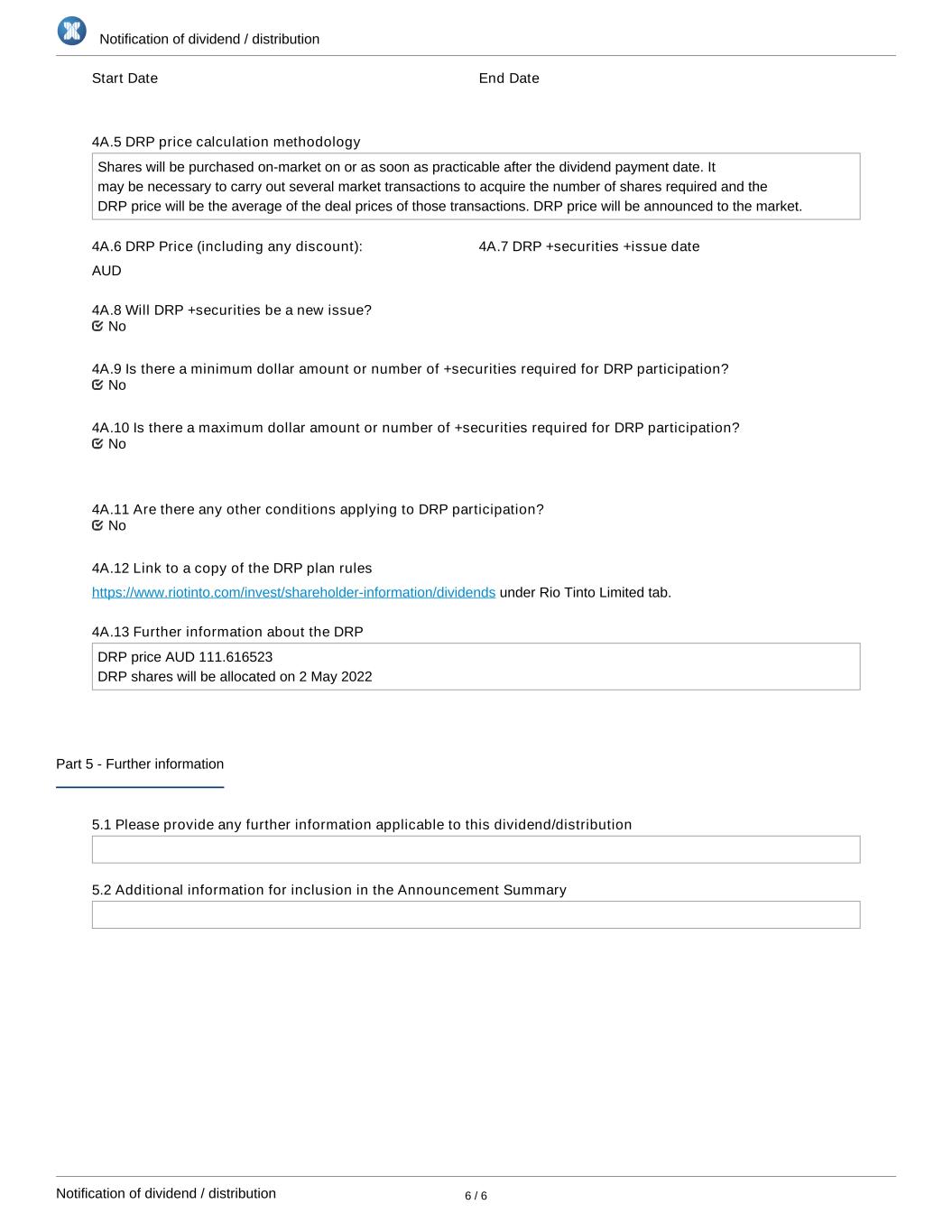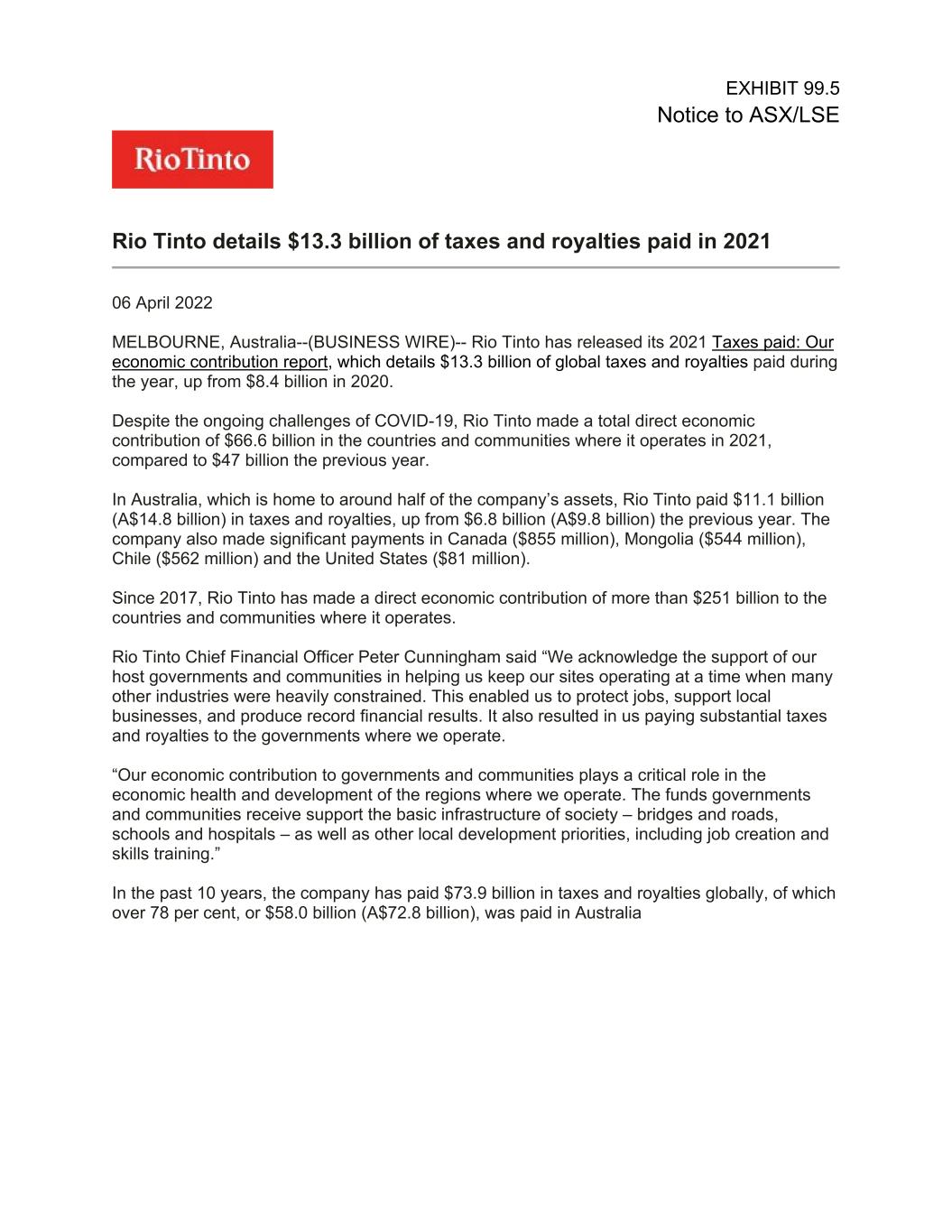
EXHIBIT 99.5 Notice to ASX/LSE Rio Tinto details $13.3 billion of taxes and royalties paid in 2021 06 April 2022 MELBOURNE, Australia--(BUSINESS WIRE)-- Rio Tinto has released its 2021 Taxes paid: Our economic contribution report, which details $13.3 billion of global taxes and royalties paid during the year, up from $8.4 billion in 2020. Despite the ongoing challenges of COVID-19, Rio Tinto made a total direct economic contribution of $66.6 billion in the countries and communities where it operates in 2021, compared to $47 billion the previous year. In Australia, which is home to around half of the company’s assets, Rio Tinto paid $11.1 billion (A$14.8 billion) in taxes and royalties, up from $6.8 billion (A$9.8 billion) the previous year. The company also made significant payments in Canada ($855 million), Mongolia ($544 million), Chile ($562 million) and the United States ($81 million). Since 2017, Rio Tinto has made a direct economic contribution of more than $251 billion to the countries and communities where it operates. Rio Tinto Chief Financial Officer Peter Cunningham said “We acknowledge the support of our host governments and communities in helping us keep our sites operating at a time when many other industries were heavily constrained. This enabled us to protect jobs, support local businesses, and produce record financial results. It also resulted in us paying substantial taxes and royalties to the governments where we operate. “Our economic contribution to governments and communities plays a critical role in the economic health and development of the regions where we operate. The funds governments and communities receive support the basic infrastructure of society – bridges and roads, schools and hospitals – as well as other local development priorities, including job creation and skills training.” In the past 10 years, the company has paid $73.9 billion in taxes and royalties globally, of which over 78 per cent, or $58.0 billion (A$72.8 billion), was paid in Australia
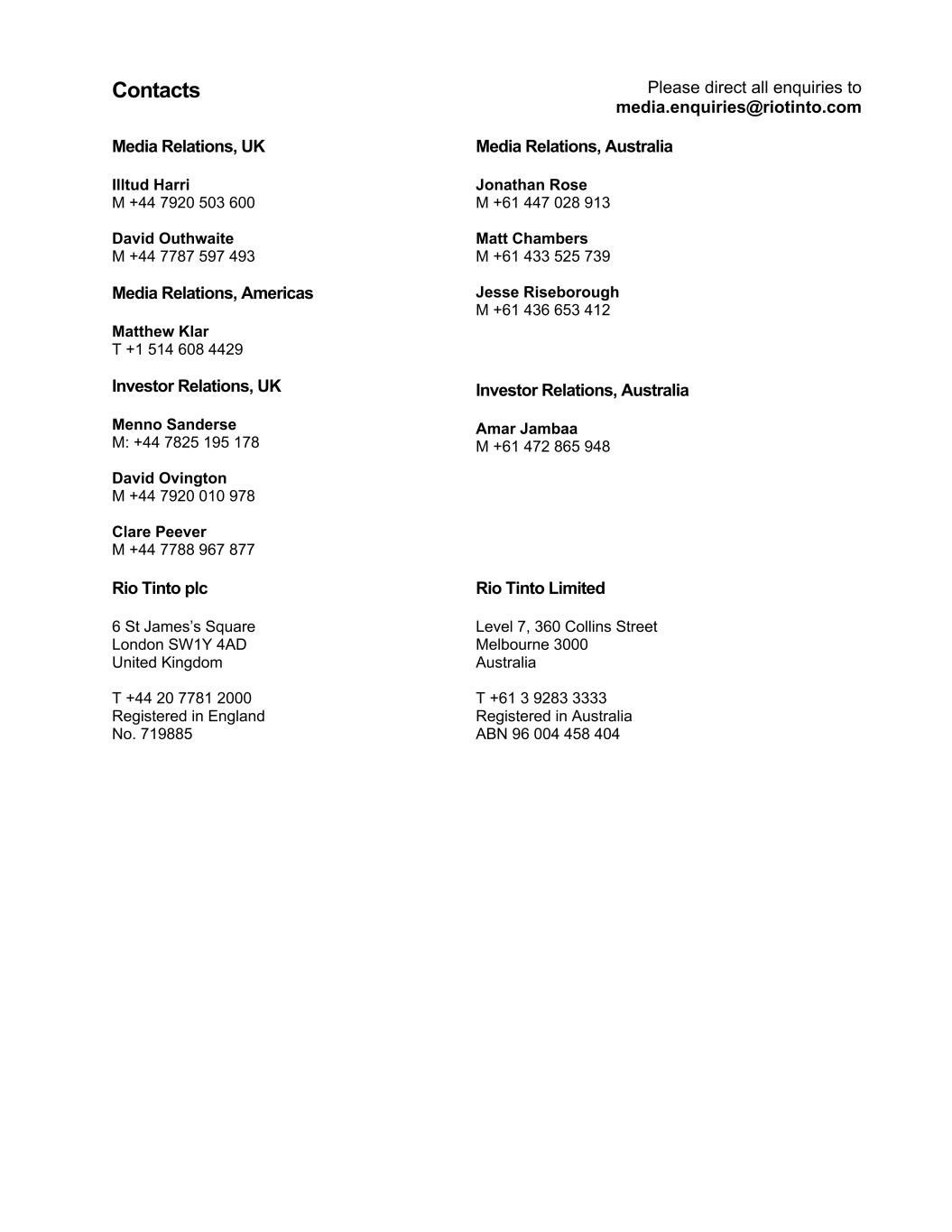
Contacts Please direct all enquiries to media.enquiries@riotinto.com Media Relations, UK Illtud Harri M +44 7920 503 600 David Outhwaite M +44 7787 597 493 Media Relations, Americas Matthew Klar T +1 514 608 4429 Investor Relations, UK Menno Sanderse M: +44 7825 195 178 David Ovington M +44 7920 010 978 Clare Peever M +44 7788 967 877 Media Relations, Australia Jonathan Rose M +61 447 028 913 Matt Chambers M +61 433 525 739 Jesse Riseborough M +61 436 653 412 Investor Relations, Australia Amar Jambaa M +61 472 865 948 Rio Tinto plc 6 St James’s Square London SW1Y 4AD United Kingdom T +44 20 7781 2000 Registered in England No. 719885 Rio Tinto Limited Level 7, 360 Collins Street Melbourne 3000 Australia T +61 3 9283 3333 Registered in Australia ABN 96 004 458 404
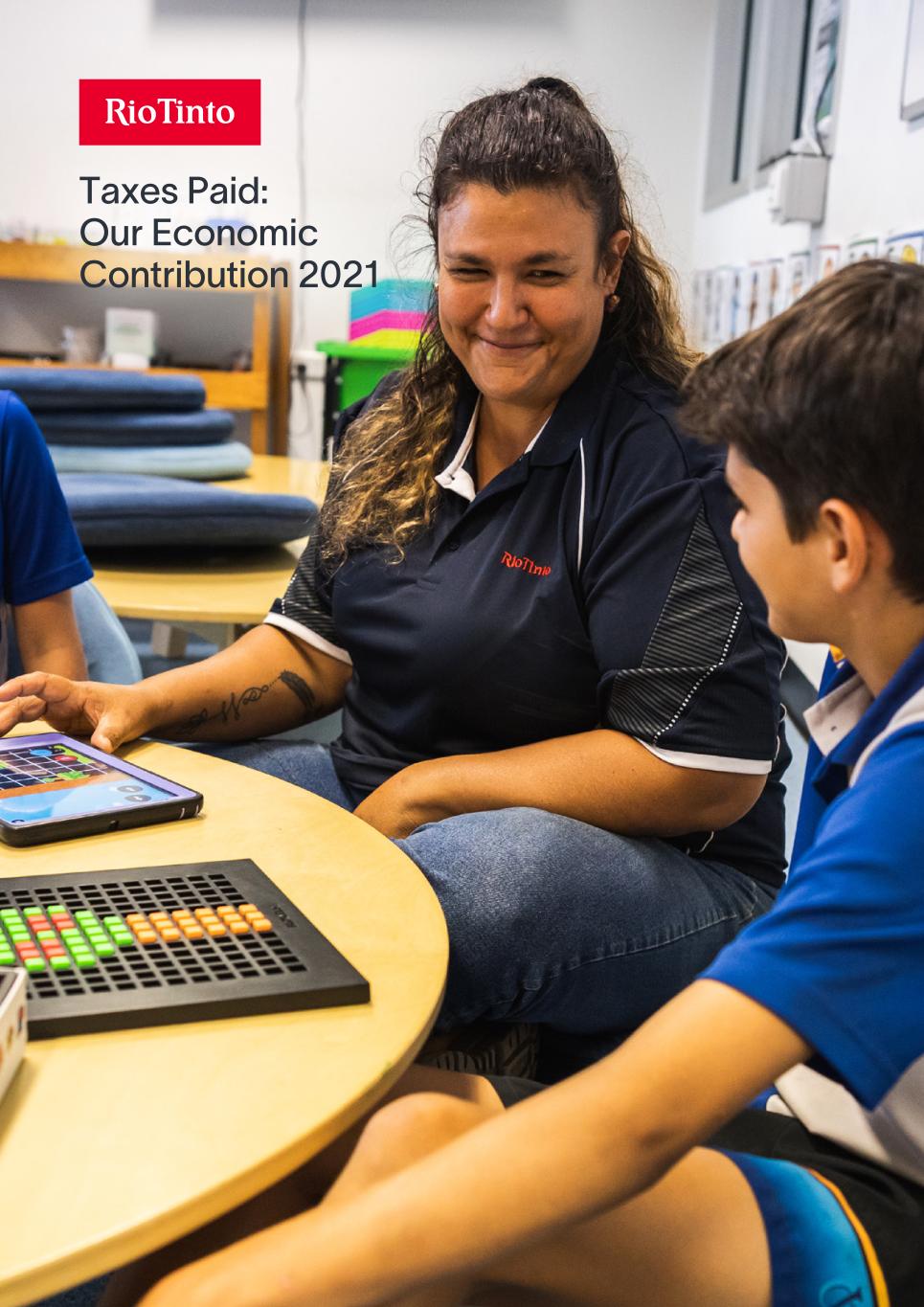
Taxes Paid: Our Economic Contribution 2021
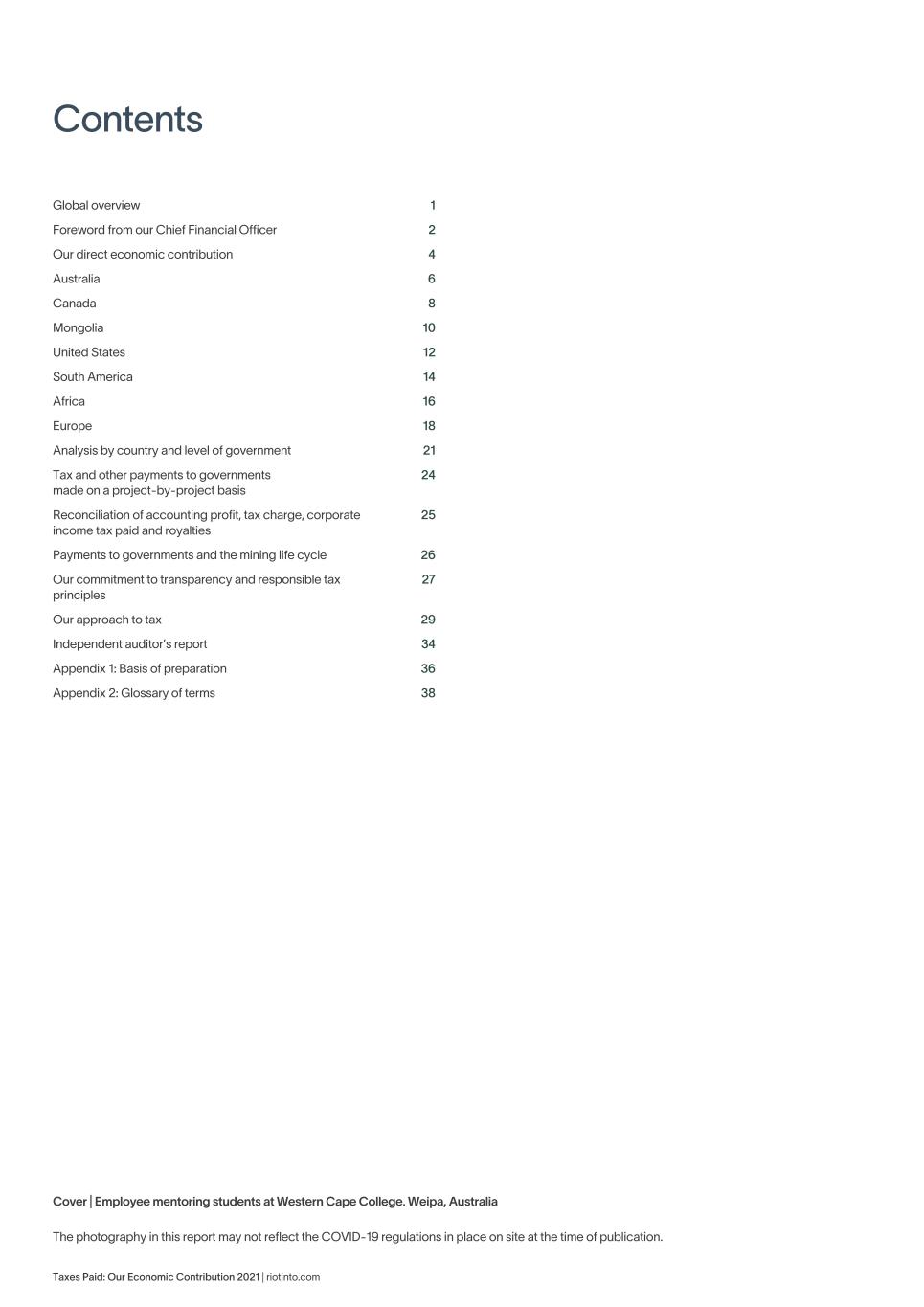
Global overview 1 Foreword from our Chief Financial Officer 2 Our direct economic contribution 4 Australia 6 Canada 8 Mongolia 10 United States 12 South America 14 Africa 16 Europe 18 Analysis by country and level of government 21 Tax and other payments to governments made on a project-by-project basis 24 Reconciliation of accounting profit, tax charge, corporate income tax paid and royalties 25 Payments to governments and the mining life cycle 26 Our commitment to transparency and responsible tax principles 27 Our approach to tax 29 Independent auditor’s report 34 Appendix 1: Basis of preparation 36 Appendix 2: Glossary of terms 38 Contents Cover | Employee mentoring students at Western Cape College. Weipa, Australia The photography in this report may not reflect the COVID-19 regulations in place on site at the time of publication. Taxes Paid: Our Economic Contribution 2021 | riotinto.com

Total global taxes and royalties paid in 2021 $13.3bn (2020: $8.4bn) Australia $11.1bn (2020: $6.8bn) Gudai-Darri, iron ore project. The Pilbara, Western Australia Chile $562m (2020: $246m) Mongolia $544m (2020: $277m) Canada $855m (2020: $651m) United States $81m (2020: $111m) 1Taxes Paid: Our Economic Contribution 2021 | riotinto.com
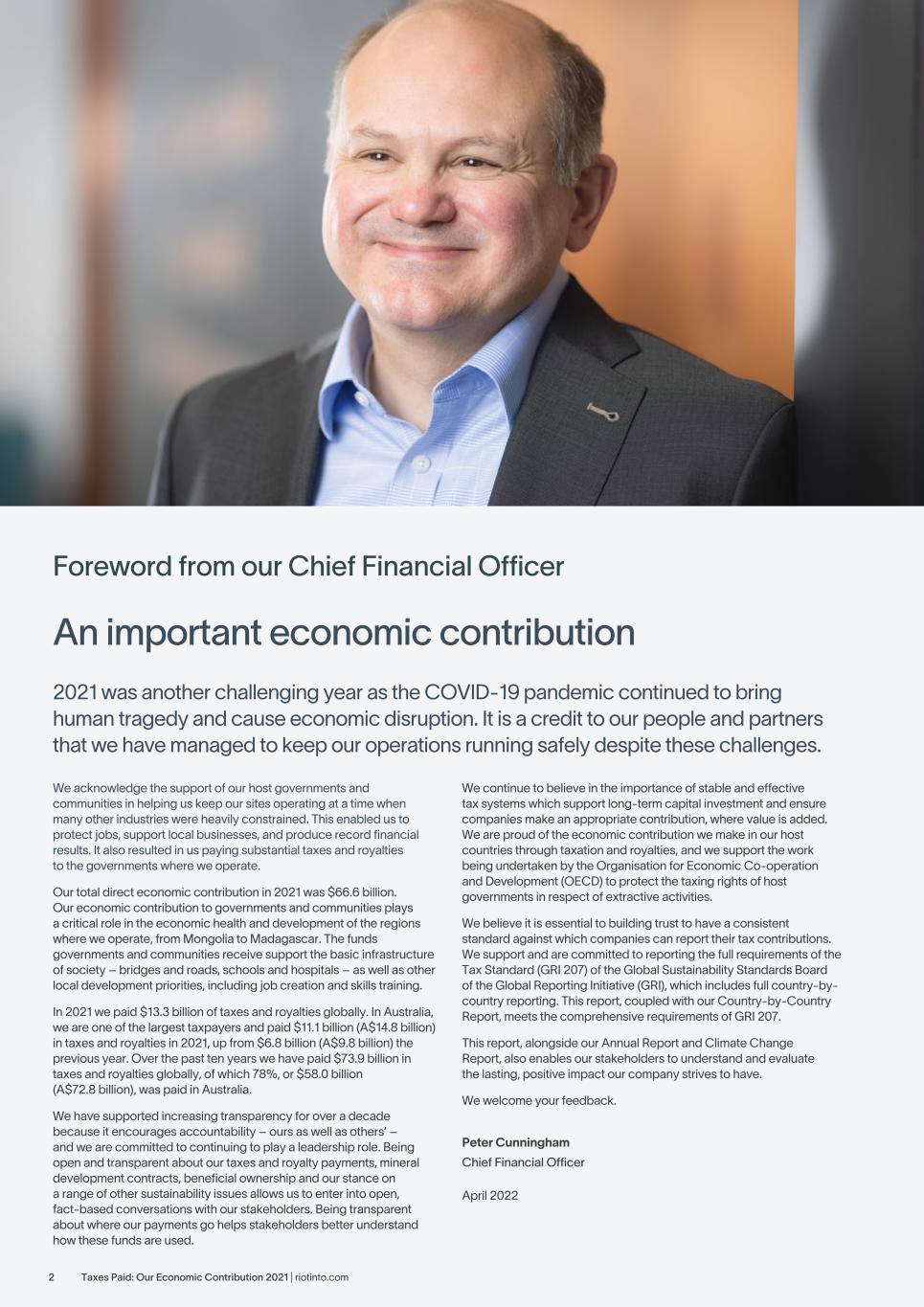
An important economic contribution 2021 was another challenging year as the COVID-19 pandemic continued to bring human tragedy and cause economic disruption. It is a credit to our people and partners that we have managed to keep our operations running safely despite these challenges. We acknowledge the support of our host governments and communities in helping us keep our sites operating at a time when many other industries were heavily constrained. This enabled us to protect jobs, support local businesses, and produce record financial results. It also resulted in us paying substantial taxes and royalties to the governments where we operate. Our total direct economic contribution in 2021 was $66.6 billion. Our economic contribution to governments and communities plays a critical role in the economic health and development of the regions where we operate, from Mongolia to Madagascar. The funds governments and communities receive support the basic infrastructure of society – bridges and roads, schools and hospitals – as well as other local development priorities, including job creation and skills training. In 2021 we paid $13.3 billion of taxes and royalties globally. In Australia, we are one of the largest taxpayers and paid $11.1 billion (A$14.8 billion) in taxes and royalties in 2021, up from $6.8 billion (A$9.8 billion) the previous year. Over the past ten years we have paid $73.9 billion in taxes and royalties globally, of which 78%, or $58.0 billion (A$72.8 billion), was paid in Australia. We have supported increasing transparency for over a decade because it encourages accountability – ours as well as others’ – and we are committed to continuing to play a leadership role. Being open and transparent about our taxes and royalty payments, mineral development contracts, beneficial ownership and our stance on a range of other sustainability issues allows us to enter into open, fact-based conversations with our stakeholders. Being transparent about where our payments go helps stakeholders better understand how these funds are used. We continue to believe in the importance of stable and effective tax systems which support long-term capital investment and ensure companies make an appropriate contribution, where value is added. We are proud of the economic contribution we make in our host countries through taxation and royalties, and we support the work being undertaken by the Organisation for Economic Co-operation and Development (OECD) to protect the taxing rights of host governments in respect of extractive activities. We believe it is essential to building trust to have a consistent standard against which companies can report their tax contributions. We support and are committed to reporting the full requirements of the Tax Standard (GRI 207) of the Global Sustainability Standards Board of the Global Reporting Initiative (GRI), which includes full country-by- country reporting. This report, coupled with our Country-by-Country Report, meets the comprehensive requirements of GRI 207. This report, alongside our Annual Report and Climate Change Report, also enables our stakeholders to understand and evaluate the lasting, positive impact our company strives to have. We welcome your feedback. Peter Cunningham Chief Financial Officer April 2022 Foreword from our Chief Financial Officer Taxes Paid: Our Economic Contribution 2021 | riotinto.com2

The funds governments and communities receive support the basic infrastructure of society – bridges and roads, schools and hospitals – as well as other local development priorities, including job creation and skills training. Peter Cunningham Chief Financial Officer 3Taxes Paid: Our Economic Contribution 2021 | riotinto.com
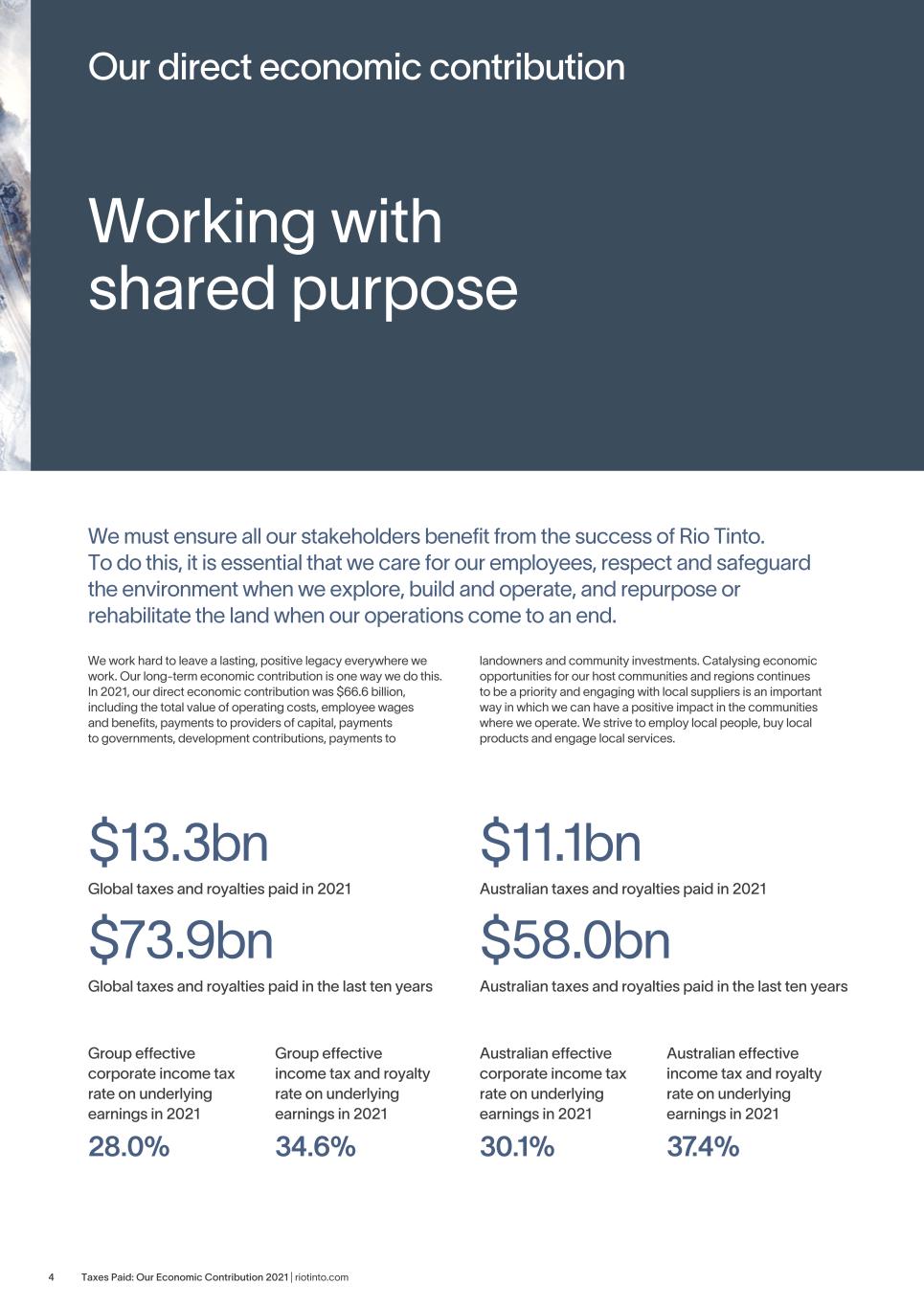
Working with shared purpose Our direct economic contribution We must ensure all our stakeholders benefit from the success of Rio Tinto. To do this, it is essential that we care for our employees, respect and safeguard the environment when we explore, build and operate, and repurpose or rehabilitate the land when our operations come to an end. We work hard to leave a lasting, positive legacy everywhere we work. Our long-term economic contribution is one way we do this. In 2021, our direct economic contribution was $66.6 billion, including the total value of operating costs, employee wages and benefits, payments to providers of capital, payments to governments, development contributions, payments to landowners and community investments. Catalysing economic opportunities for our host communities and regions continues to be a priority and engaging with local suppliers is an important way in which we can have a positive impact in the communities where we operate. We strive to employ local people, buy local products and engage local services. $13.3bn Global taxes and royalties paid in 2021 $73.9bn Global taxes and royalties paid in the last ten years $11.1bn Australian taxes and royalties paid in 2021 $58.0bn Australian taxes and royalties paid in the last ten years Group effective corporate income tax rate on underlying earnings in 2021 28.0% Group effective income tax and royalty rate on underlying earnings in 2021 34.6% Australian effective corporate income tax rate on underlying earnings in 2021 30.1% Australian effective income tax and royalty rate on underlying earnings in 2021 37.4% Taxes Paid: Our Economic Contribution 2021 | riotinto.com4
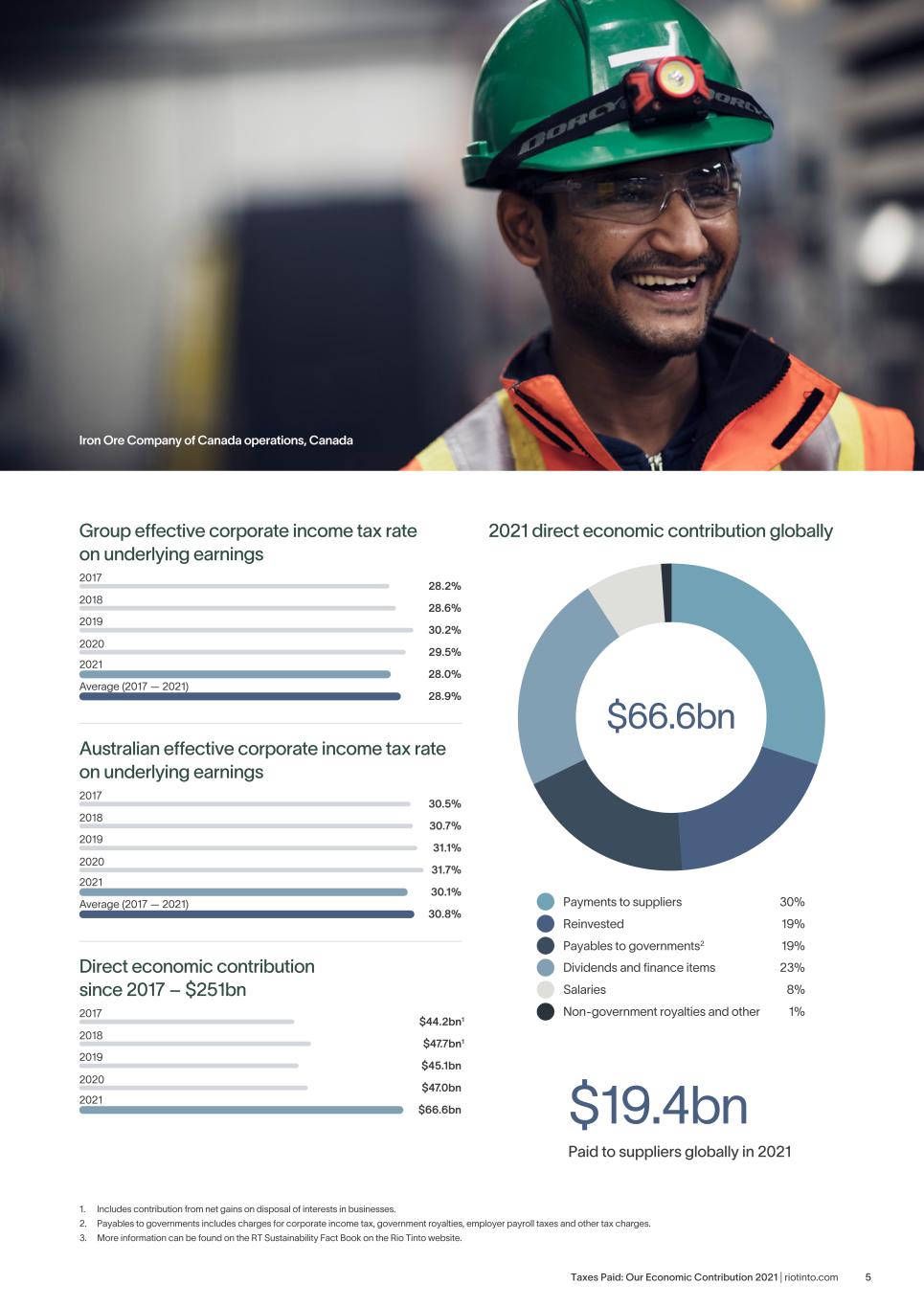
Iron Ore Company of Canada operations, Canada 2021 direct economic contribution globallyGroup effective corporate income tax rate on underlying earnings 2017 2018 2019 2020 2021 Average (2017 — 2021) 28.2% 28.6% 30.2% 29.5% 28.0% 28.9% Australian effective corporate income tax rate on underlying earnings 2017 2018 2019 2020 2021 Average (2017 — 2021) 30.5% 30.7% 31.1% 31.7% 30.1% 30.8% Direct economic contribution since 2017 – $251bn 2017 2018 2019 2020 2021 $44.2bn1 $47.7bn1 $45.1bn $47.0bn $66.6bn Payments to suppliers 30% Reinvested 19% Payables to governments2 19% Dividends and finance items 23% Salaries 8% Non-government royalties and other 1% 1. Includes contribution from net gains on disposal of interests in businesses. 2. Payables to governments includes charges for corporate income tax, government royalties, employer payroll taxes and other tax charges. 3. More information can be found on the RT Sustainability Fact Book on the Rio Tinto website. $66.6bn $19.4bn Paid to suppliers globally in 2021 5Taxes Paid: Our Economic Contribution 2021 | riotinto.com
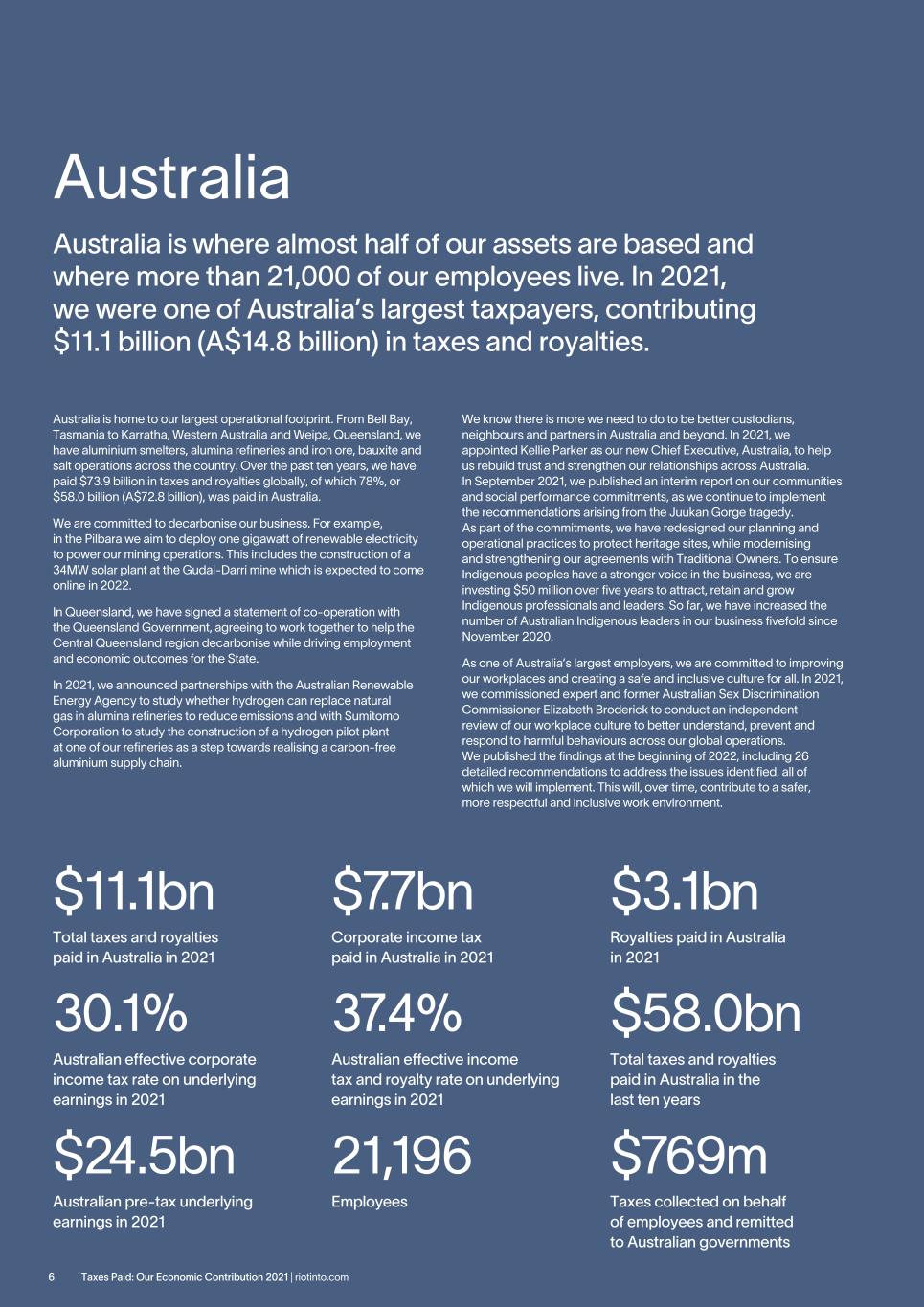
Australia Australia is where almost half of our assets are based and where more than 21,000 of our employees live. In 2021, we were one of Australia’s largest taxpayers, contributing $11.1 billion (A$14.8 billion) in taxes and royalties. We know there is more we need to do to be better custodians, neighbours and partners in Australia and beyond. In 2021, we appointed Kellie Parker as our new Chief Executive, Australia, to help us rebuild trust and strengthen our relationships across Australia. In September 2021, we published an interim report on our communities and social performance commitments, as we continue to implement the recommendations arising from the Juukan Gorge tragedy. As part of the commitments, we have redesigned our planning and operational practices to protect heritage sites, while modernising and strengthening our agreements with Traditional Owners. To ensure Indigenous peoples have a stronger voice in the business, we are investing $50 million over five years to attract, retain and grow Indigenous professionals and leaders. So far, we have increased the number of Australian Indigenous leaders in our business fivefold since November 2020. As one of Australia’s largest employers, we are committed to improving our workplaces and creating a safe and inclusive culture for all. In 2021, we commissioned expert and former Australian Sex Discrimination Commissioner Elizabeth Broderick to conduct an independent review of our workplace culture to better understand, prevent and respond to harmful behaviours across our global operations. We published the findings at the beginning of 2022, including 26 detailed recommendations to address the issues identified, all of which we will implement. This will, over time, contribute to a safer, more respectful and inclusive work environment. Australia is home to our largest operational footprint. From Bell Bay, Tasmania to Karratha, Western Australia and Weipa, Queensland, we have aluminium smelters, alumina refineries and iron ore, bauxite and salt operations across the country. Over the past ten years, we have paid $73.9 billion in taxes and royalties globally, of which 78%, or $58.0 billion (A$72.8 billion), was paid in Australia. We are committed to decarbonise our business. For example, in the Pilbara we aim to deploy one gigawatt of renewable electricity to power our mining operations. This includes the construction of a 34MW solar plant at the Gudai-Darri mine which is expected to come online in 2022. In Queensland, we have signed a statement of co-operation with the Queensland Government, agreeing to work together to help the Central Queensland region decarbonise while driving employment and economic outcomes for the State. In 2021, we announced partnerships with the Australian Renewable Energy Agency to study whether hydrogen can replace natural gas in alumina refineries to reduce emissions and with Sumitomo Corporation to study the construction of a hydrogen pilot plant at one of our refineries as a step towards realising a carbon-free aluminium supply chain. $769m Taxes collected on behalf of employees and remitted to Australian governments 21,196 Employees $24.5bn Australian pre-tax underlying earnings in 2021 $58.0bn Total taxes and royalties paid in Australia in the last ten years 37.4% Australian effective income tax and royalty rate on underlying earnings in 2021 30.1% Australian effective corporate income tax rate on underlying earnings in 2021 $3.1bn Royalties paid in Australia in 2021 $7.7bn Corporate income tax paid in Australia in 2021 $11.1bn Total taxes and royalties paid in Australia in 2021 Taxes Paid: Our Economic Contribution 2021 | riotinto.com6
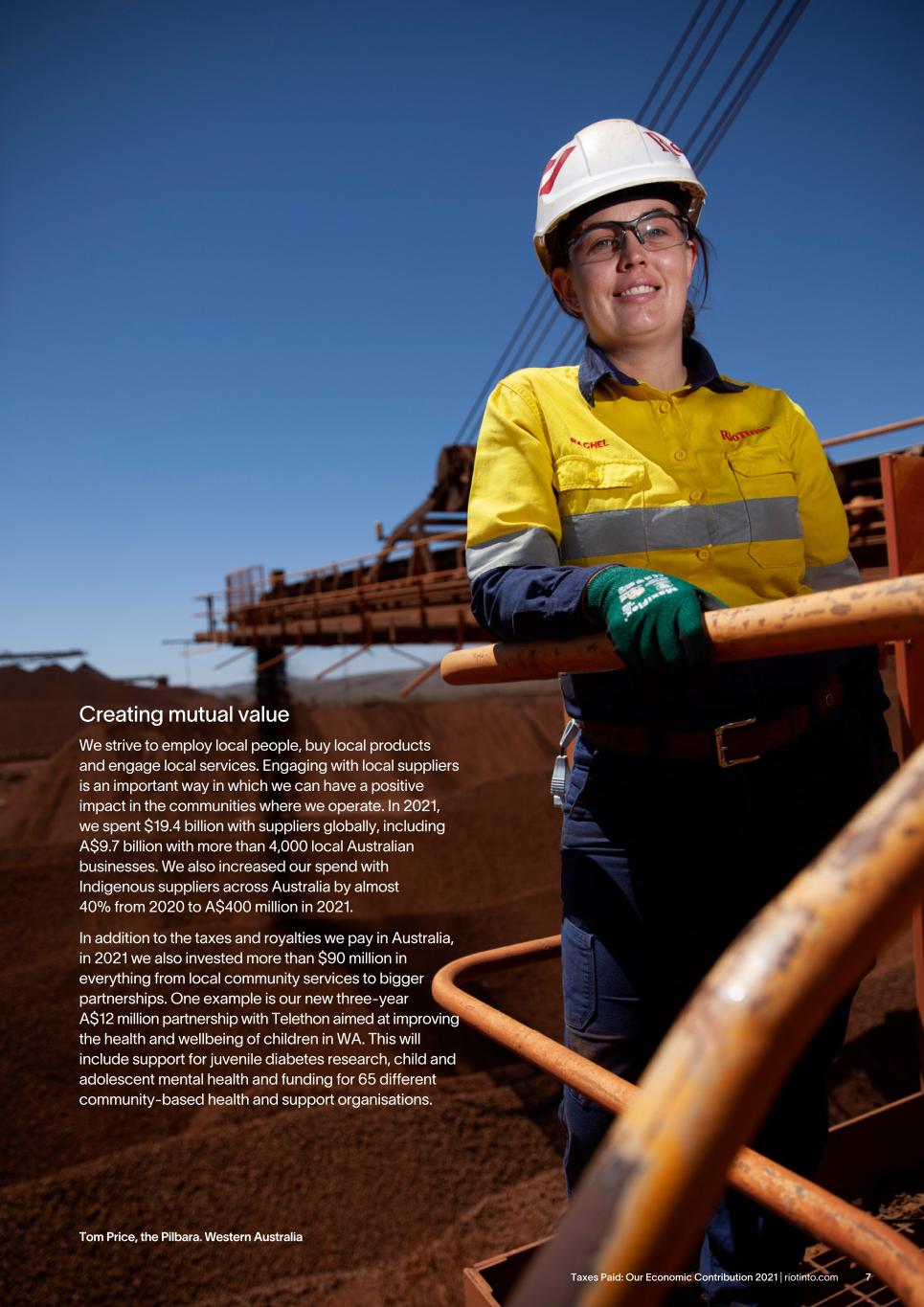
Creating mutual value We strive to employ local people, buy local products and engage local services. Engaging with local suppliers is an important way in which we can have a positive impact in the communities where we operate. In 2021, we spent $19.4 billion with suppliers globally, including A$9.7 billion with more than 4,000 local Australian businesses. We also increased our spend with Indigenous suppliers across Australia by almost 40% from 2020 to A$400 million in 2021. In addition to the taxes and royalties we pay in Australia, in 2021 we also invested more than $90 million in everything from local community services to bigger partnerships. One example is our new three-year A$12 million partnership with Telethon aimed at improving the health and wellbeing of children in WA. This will include support for juvenile diabetes research, child and adolescent mental health and funding for 65 different community-based health and support organisations. Tom Price, the Pilbara. Western Australia 7Taxes Paid: Our Economic Contribution 2021 | riotinto.com
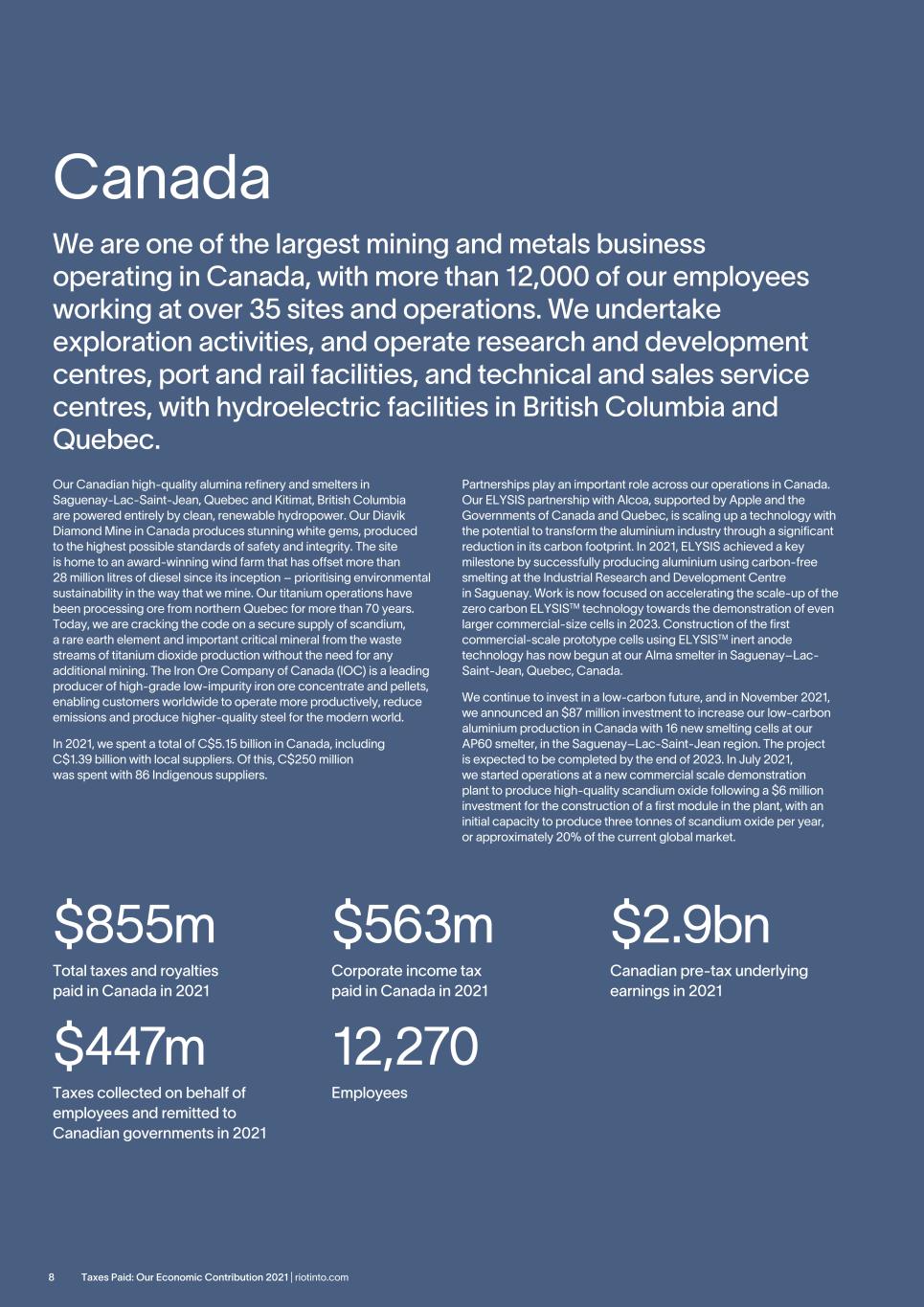
Canada We are one of the largest mining and metals business operating in Canada, with more than 12,000 of our employees working at over 35 sites and operations. We undertake exploration activities, and operate research and development centres, port and rail facilities, and technical and sales service centres, with hydroelectric facilities in British Columbia and Quebec. Partnerships play an important role across our operations in Canada. Our ELYSIS partnership with Alcoa, supported by Apple and the Governments of Canada and Quebec, is scaling up a technology with the potential to transform the aluminium industry through a significant reduction in its carbon footprint. In 2021, ELYSIS achieved a key milestone by successfully producing aluminium using carbon-free smelting at the Industrial Research and Development Centre in Saguenay. Work is now focused on accelerating the scale-up of the zero carbon ELYSISTM technology towards the demonstration of even larger commercial-size cells in 2023. Construction of the first commercial-scale prototype cells using ELYSISTM inert anode technology has now begun at our Alma smelter in Saguenay–Lac- Saint-Jean, Quebec, Canada. We continue to invest in a low-carbon future, and in November 2021, we announced an $87 million investment to increase our low-carbon aluminium production in Canada with 16 new smelting cells at our AP60 smelter, in the Saguenay–Lac-Saint-Jean region. The project is expected to be completed by the end of 2023. In July 2021, we started operations at a new commercial scale demonstration plant to produce high-quality scandium oxide following a $6 million investment for the construction of a first module in the plant, with an initial capacity to produce three tonnes of scandium oxide per year, or approximately 20% of the current global market. Our Canadian high-quality alumina refinery and smelters in Saguenay-Lac-Saint-Jean, Quebec and Kitimat, British Columbia are powered entirely by clean, renewable hydropower. Our Diavik Diamond Mine in Canada produces stunning white gems, produced to the highest possible standards of safety and integrity. The site is home to an award-winning wind farm that has offset more than 28 million litres of diesel since its inception – prioritising environmental sustainability in the way that we mine. Our titanium operations have been processing ore from northern Quebec for more than 70 years. Today, we are cracking the code on a secure supply of scandium, a rare earth element and important critical mineral from the waste streams of titanium dioxide production without the need for any additional mining. The Iron Ore Company of Canada (IOC) is a leading producer of high-grade low-impurity iron ore concentrate and pellets, enabling customers worldwide to operate more productively, reduce emissions and produce higher-quality steel for the modern world. In 2021, we spent a total of C$5.15 billion in Canada, including C$1.39 billion with local suppliers. Of this, C$250 million was spent with 86 Indigenous suppliers. $447m Taxes collected on behalf of employees and remitted to Canadian governments in 2021 12,270 Employees $2.9bn Canadian pre-tax underlying earnings in 2021 $563m Corporate income tax paid in Canada in 2021 $855m Total taxes and royalties paid in Canada in 2021 Taxes Paid: Our Economic Contribution 2021 | riotinto.com8
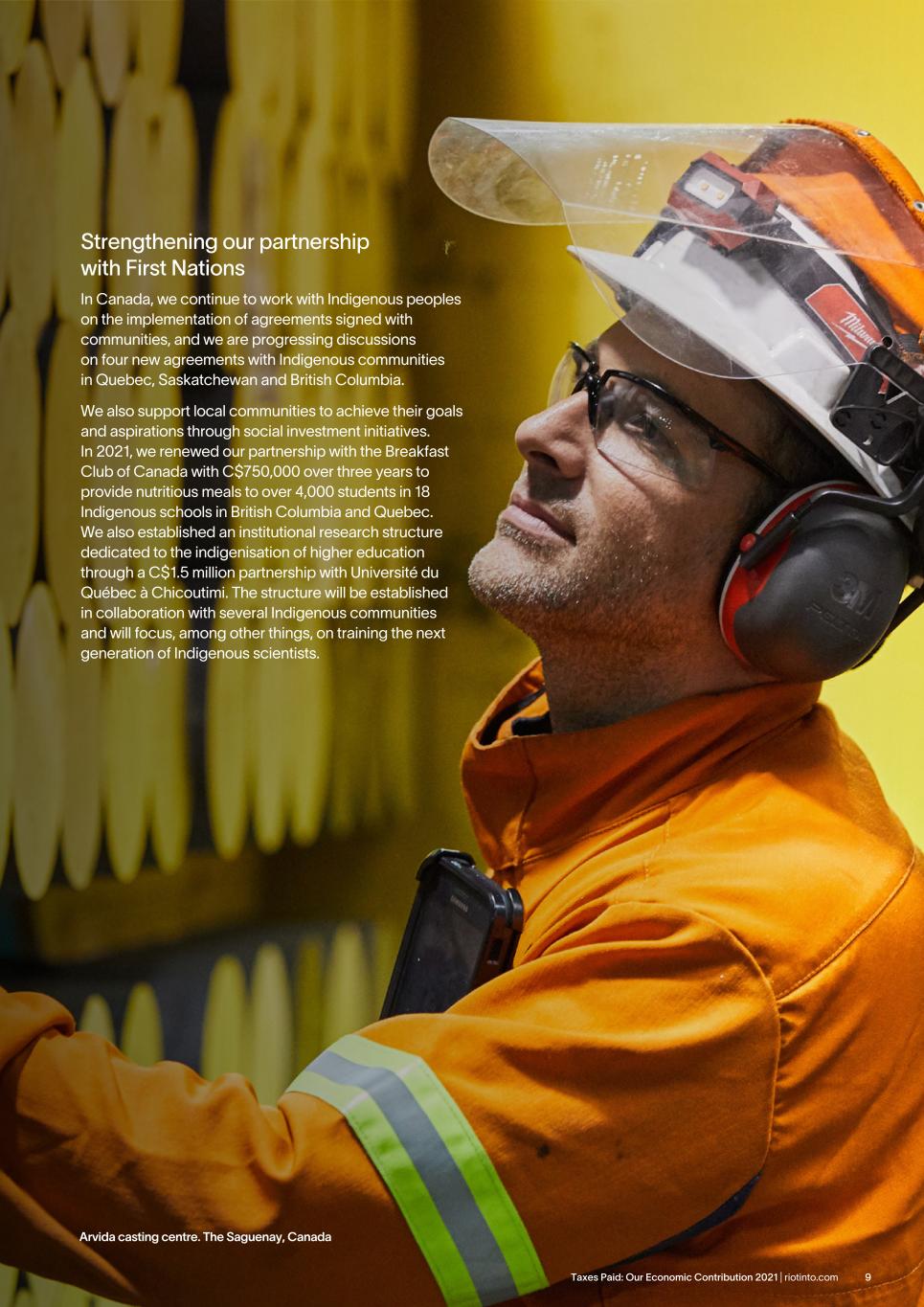
Strengthening our partnership with First Nations In Canada, we continue to work with Indigenous peoples on the implementation of agreements signed with communities, and we are progressing discussions on four new agreements with Indigenous communities in Quebec, Saskatchewan and British Columbia. We also support local communities to achieve their goals and aspirations through social investment initiatives. In 2021, we renewed our partnership with the Breakfast Club of Canada with C$750,000 over three years to provide nutritious meals to over 4,000 students in 18 Indigenous schools in British Columbia and Quebec. We also established an institutional research structure dedicated to the indigenisation of higher education through a C$1.5 million partnership with Université du Québec à Chicoutimi. The structure will be established in collaboration with several Indigenous communities and will focus, among other things, on training the next generation of Indigenous scientists. Arvida casting centre. The Saguenay, Canada 9Taxes Paid: Our Economic Contribution 2021 | riotinto.com
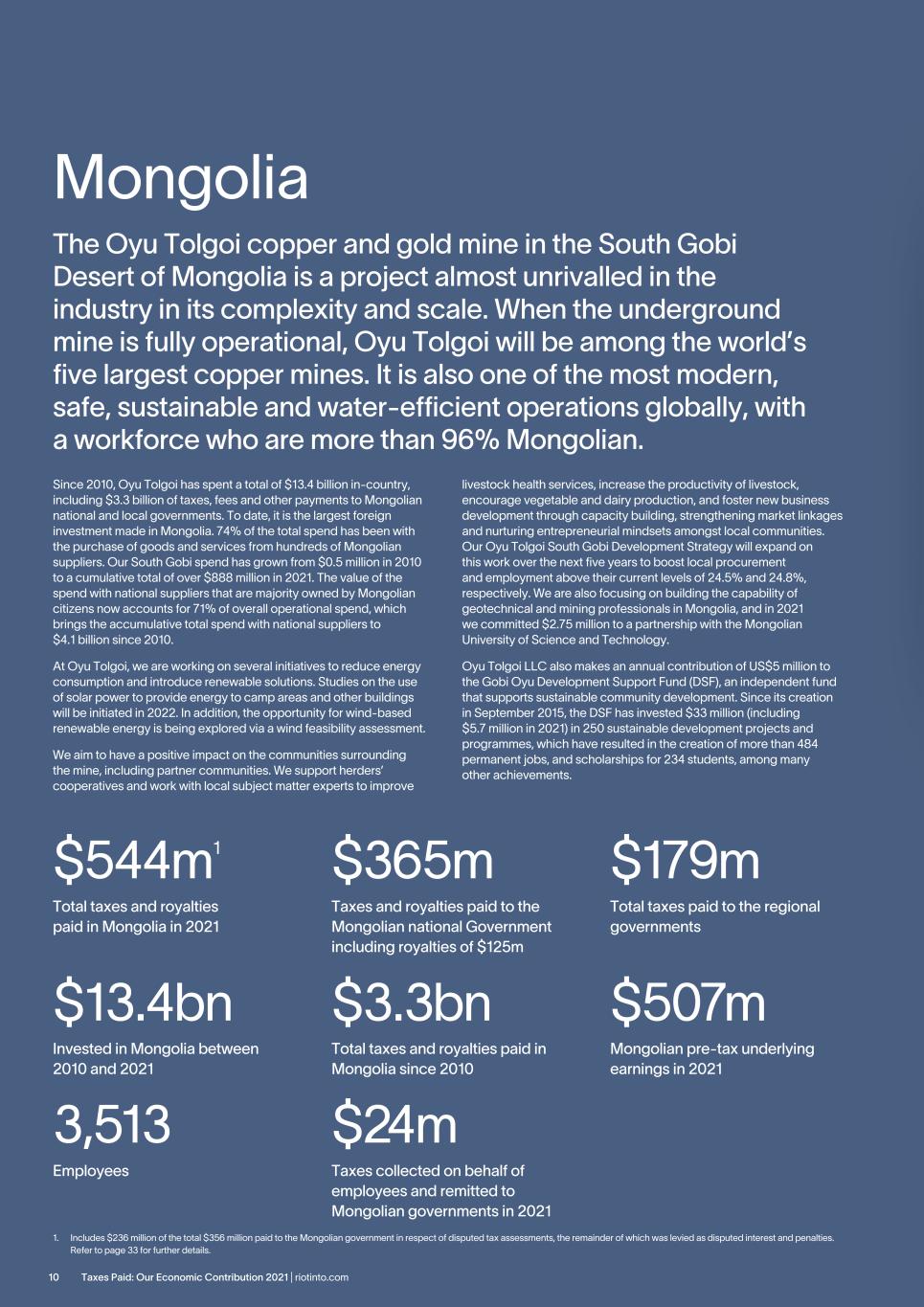
Mongolia The Oyu Tolgoi copper and gold mine in the South Gobi Desert of Mongolia is a project almost unrivalled in the industry in its complexity and scale. When the underground mine is fully operational, Oyu Tolgoi will be among the world’s five largest copper mines. It is also one of the most modern, safe, sustainable and water-efficient operations globally, with a workforce who are more than 96% Mongolian. livestock health services, increase the productivity of livestock, encourage vegetable and dairy production, and foster new business development through capacity building, strengthening market linkages and nurturing entrepreneurial mindsets amongst local communities. Our Oyu Tolgoi South Gobi Development Strategy will expand on this work over the next five years to boost local procurement and employment above their current levels of 24.5% and 24.8%, respectively. We are also focusing on building the capability of geotechnical and mining professionals in Mongolia, and in 2021 we committed $2.75 million to a partnership with the Mongolian University of Science and Technology. Oyu Tolgoi LLC also makes an annual contribution of US$5 million to the Gobi Oyu Development Support Fund (DSF), an independent fund that supports sustainable community development. Since its creation in September 2015, the DSF has invested $33 million (including $5.7 million in 2021) in 250 sustainable development projects and programmes, which have resulted in the creation of more than 484 permanent jobs, and scholarships for 234 students, among many other achievements. Since 2010, Oyu Tolgoi has spent a total of $13.4 billion in-country, including $3.3 billion of taxes, fees and other payments to Mongolian national and local governments. To date, it is the largest foreign investment made in Mongolia. 74% of the total spend has been with the purchase of goods and services from hundreds of Mongolian suppliers. Our South Gobi spend has grown from $0.5 million in 2010 to a cumulative total of over $888 million in 2021. The value of the spend with national suppliers that are majority owned by Mongolian citizens now accounts for 71% of overall operational spend, which brings the accumulative total spend with national suppliers to $4.1 billion since 2010. At Oyu Tolgoi, we are working on several initiatives to reduce energy consumption and introduce renewable solutions. Studies on the use of solar power to provide energy to camp areas and other buildings will be initiated in 2022. In addition, the opportunity for wind-based renewable energy is being explored via a wind feasibility assessment. We aim to have a positive impact on the communities surrounding the mine, including partner communities. We support herders’ cooperatives and work with local subject matter experts to improve $507m Mongolian pre-tax underlying earnings in 2021 $3.3bn Total taxes and royalties paid in Mongolia since 2010 3,513 Employees 1. Includes $236 million of the total $356 million paid to the Mongolian government in respect of disputed tax assessments, the remainder of which was levied as disputed interest and penalties. Refer to page 33 for further details. $13.4bn Invested in Mongolia between 2010 and 2021 $24m Taxes collected on behalf of employees and remitted to Mongolian governments in 2021 $179m Total taxes paid to the regional governments $365m Taxes and royalties paid to the Mongolian national Government including royalties of $125m $544m1 Total taxes and royalties paid in Mongolia in 2021 Taxes Paid: Our Economic Contribution 2021 | riotinto.com10
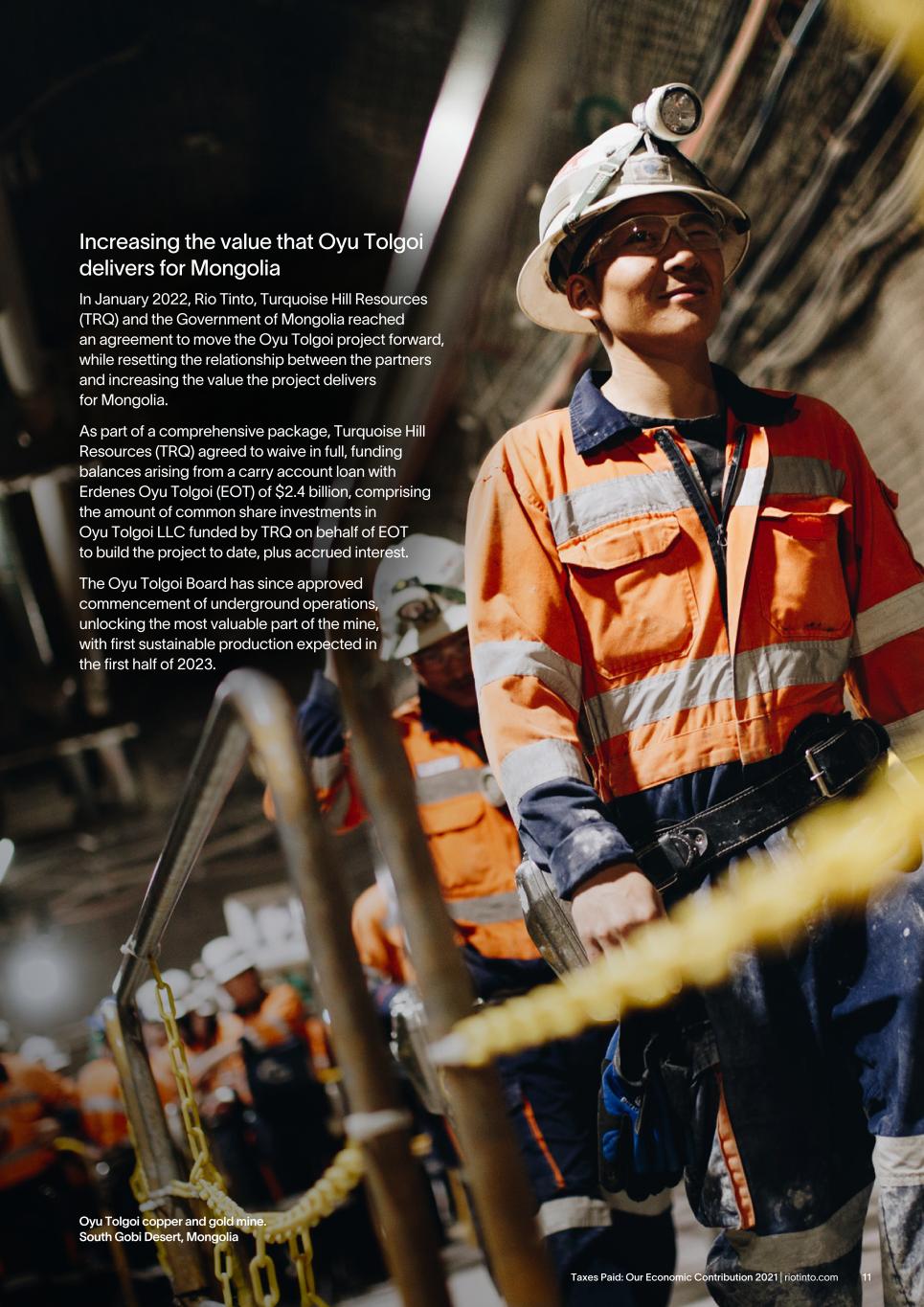
Increasing the value that Oyu Tolgoi delivers for Mongolia In January 2022, Rio Tinto, Turquoise Hill Resources (TRQ) and the Government of Mongolia reached an agreement to move the Oyu Tolgoi project forward, while resetting the relationship between the partners and increasing the value the project delivers for Mongolia. As part of a comprehensive package, Turquoise Hill Resources (TRQ) agreed to waive in full, funding balances arising from a carry account loan with Erdenes Oyu Tolgoi (EOT) of $2.4 billion, comprising the amount of common share investments in Oyu Tolgoi LLC funded by TRQ on behalf of EOT to build the project to date, plus accrued interest. The Oyu Tolgoi Board has since approved commencement of underground operations, unlocking the most valuable part of the mine, with first sustainable production expected in the first half of 2023. Oyu Tolgoi copper and gold mine. South Gobi Desert, Mongolia 11Taxes Paid: Our Economic Contribution 2021 | riotinto.com
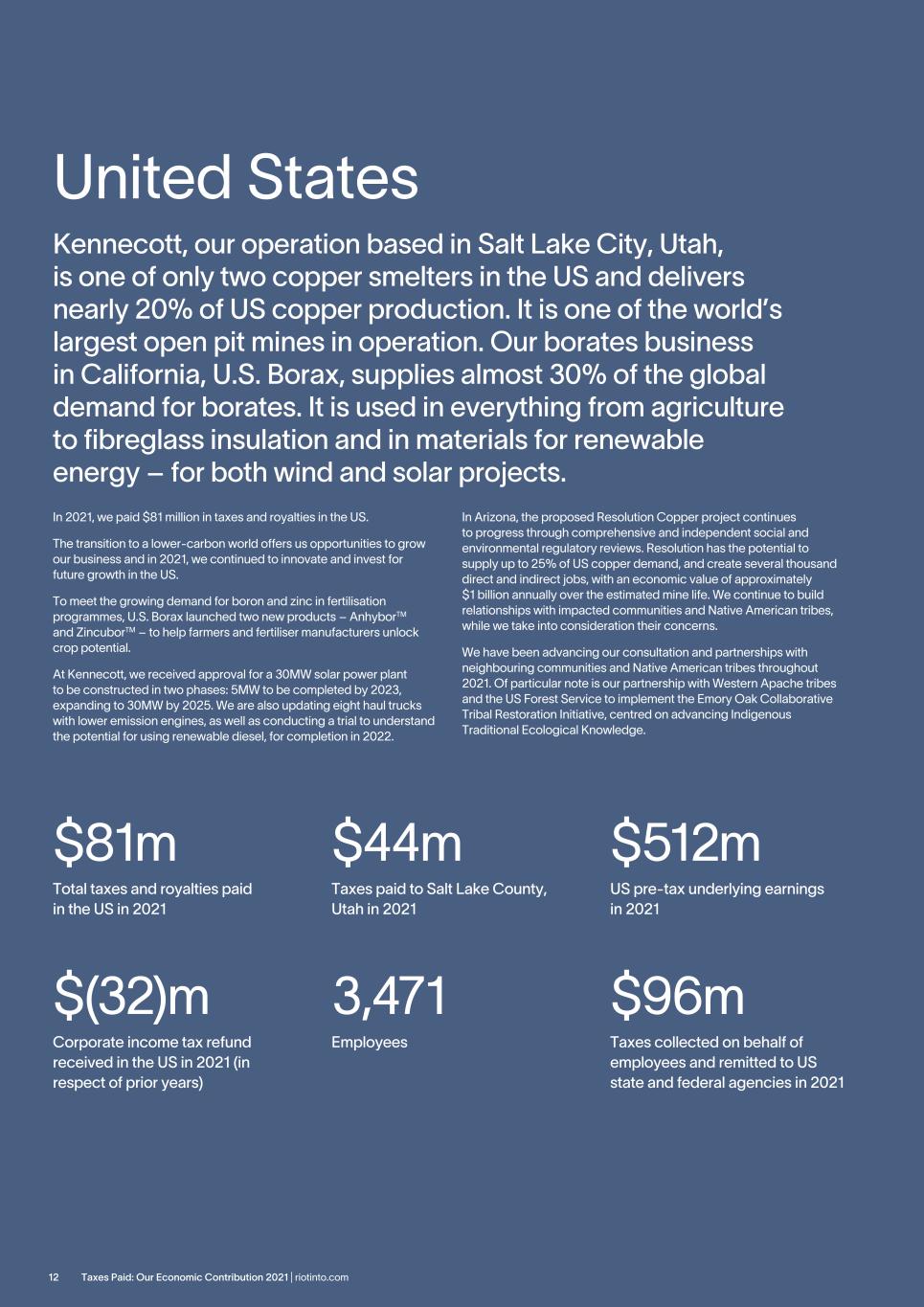
United States Kennecott, our operation based in Salt Lake City, Utah, is one of only two copper smelters in the US and delivers nearly 20% of US copper production. It is one of the world’s largest open pit mines in operation. Our borates business in California, U.S. Borax, supplies almost 30% of the global demand for borates. It is used in everything from agriculture to fibreglass insulation and in materials for renewable energy – for both wind and solar projects. In Arizona, the proposed Resolution Copper project continues to progress through comprehensive and independent social and environmental regulatory reviews. Resolution has the potential to supply up to 25% of US copper demand, and create several thousand direct and indirect jobs, with an economic value of approximately $1 billion annually over the estimated mine life. We continue to build relationships with impacted communities and Native American tribes, while we take into consideration their concerns. We have been advancing our consultation and partnerships with neighbouring communities and Native American tribes throughout 2021. Of particular note is our partnership with Western Apache tribes and the US Forest Service to implement the Emory Oak Collaborative Tribal Restoration Initiative, centred on advancing Indigenous Traditional Ecological Knowledge. In 2021, we paid $81 million in taxes and royalties in the US. The transition to a lower-carbon world offers us opportunities to grow our business and in 2021, we continued to innovate and invest for future growth in the US. To meet the growing demand for boron and zinc in fertilisation programmes, U.S. Borax launched two new products – AnhyborTM and ZincuborTM – to help farmers and fertiliser manufacturers unlock crop potential. At Kennecott, we received approval for a 30MW solar power plant to be constructed in two phases: 5MW to be completed by 2023, expanding to 30MW by 2025. We are also updating eight haul trucks with lower emission engines, as well as conducting a trial to understand the potential for using renewable diesel, for completion in 2022. 3,471 Employees $(32)m Corporate income tax refund received in the US in 2021 (in respect of prior years) $81m Total taxes and royalties paid in the US in 2021 $512m US pre-tax underlying earnings in 2021 $96m Taxes collected on behalf of employees and remitted to US state and federal agencies in 2021 $44m Taxes paid to Salt Lake County, Utah in 2021 Taxes Paid: Our Economic Contribution 2021 | riotinto.com12
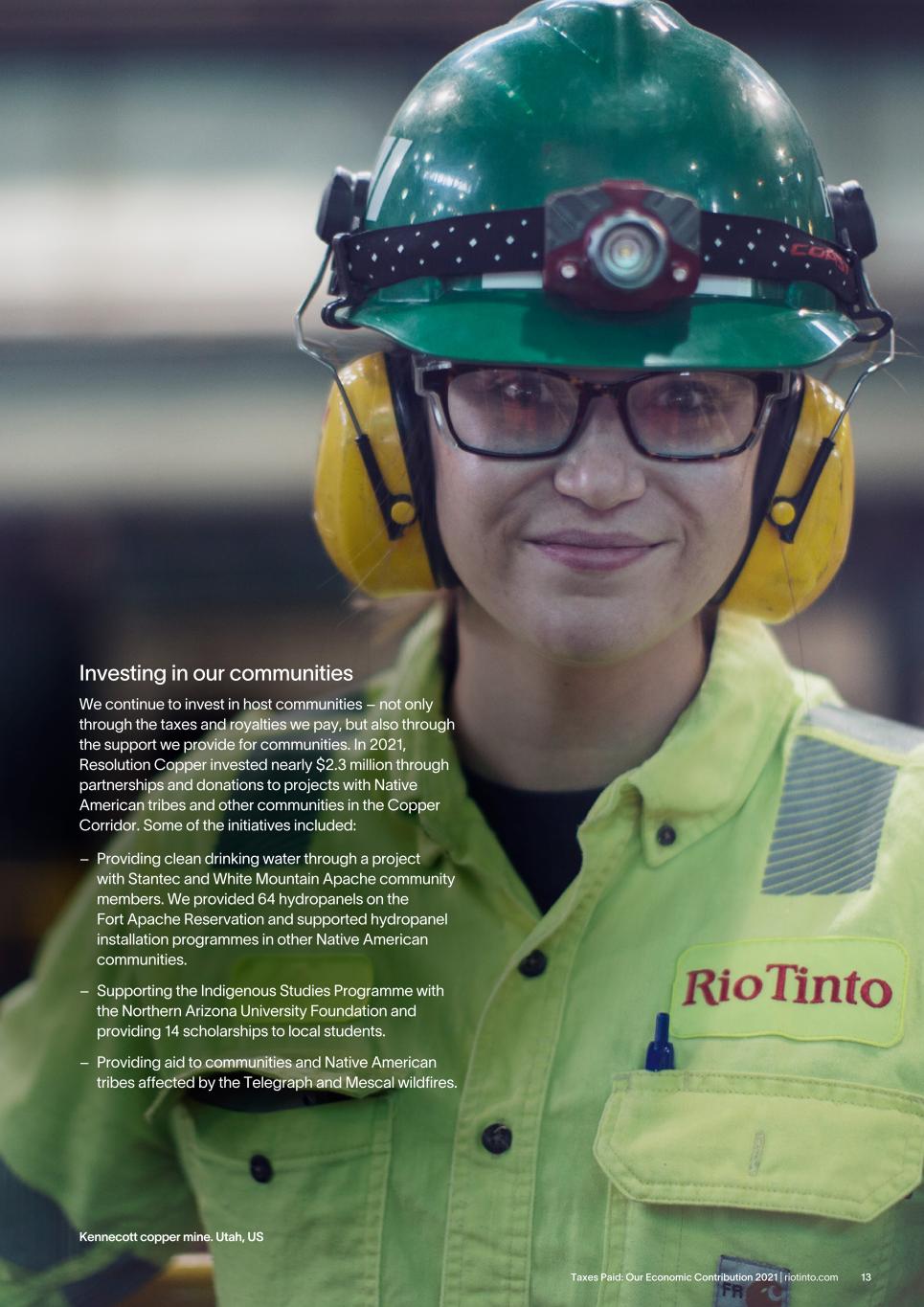
Investing in our communities We continue to invest in host communities – not only through the taxes and royalties we pay, but also through the support we provide for communities. In 2021, Resolution Copper invested nearly $2.3 million through partnerships and donations to projects with Native American tribes and other communities in the Copper Corridor. Some of the initiatives included: – Providing clean drinking water through a project with Stantec and White Mountain Apache community members. We provided 64 hydropanels on the Fort Apache Reservation and supported hydropanel installation programmes in other Native American communities. – Supporting the Indigenous Studies Programme with the Northern Arizona University Foundation and providing 14 scholarships to local students. – Providing aid to communities and Native American tribes affected by the Telegraph and Mescal wildfires. Kennecott copper mine. Utah, US 13Taxes Paid: Our Economic Contribution 2021 | riotinto.com
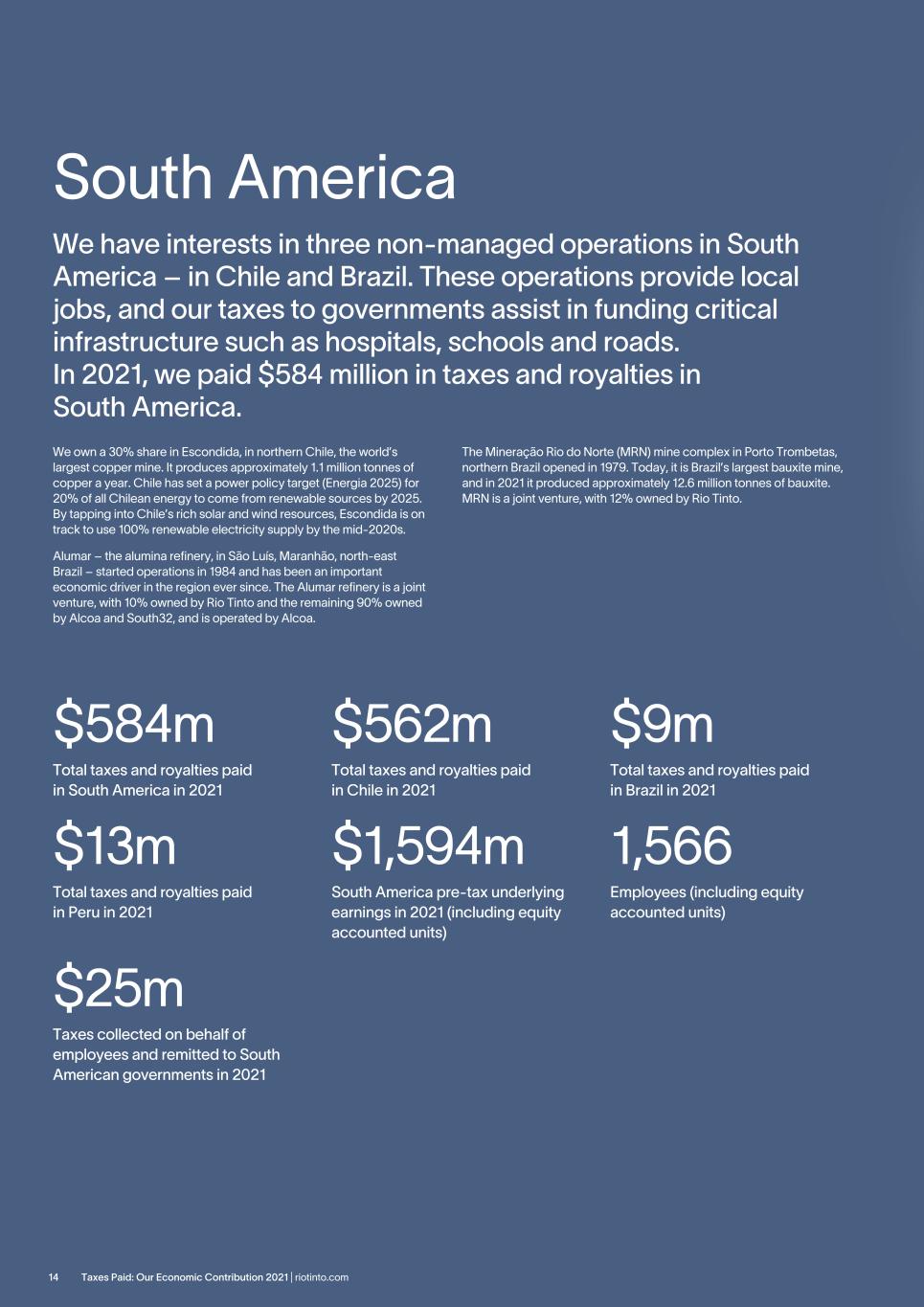
South America We have interests in three non-managed operations in South America – in Chile and Brazil. These operations provide local jobs, and our taxes to governments assist in funding critical infrastructure such as hospitals, schools and roads. In 2021, we paid $584 million in taxes and royalties in South America. The Mineração Rio do Norte (MRN) mine complex in Porto Trombetas, northern Brazil opened in 1979. Today, it is Brazil’s largest bauxite mine, and in 2021 it produced approximately 12.6 million tonnes of bauxite. MRN is a joint venture, with 12% owned by Rio Tinto. We own a 30% share in Escondida, in northern Chile, the world’s largest copper mine. It produces approximately 1.1 million tonnes of copper a year. Chile has set a power policy target (Energia 2025) for 20% of all Chilean energy to come from renewable sources by 2025. By tapping into Chile’s rich solar and wind resources, Escondida is on track to use 100% renewable electricity supply by the mid-2020s. Alumar – the alumina refinery, in São Luís, Maranhão, north-east Brazil – started operations in 1984 and has been an important economic driver in the region ever since. The Alumar refinery is a joint venture, with 10% owned by Rio Tinto and the remaining 90% owned by Alcoa and South32, and is operated by Alcoa. $25m Taxes collected on behalf of employees and remitted to South American governments in 2021 1,566 Employees (including equity accounted units) $13m Total taxes and royalties paid in Peru in 2021 $1,594m South America pre-tax underlying earnings in 2021 (including equity accounted units) $9m Total taxes and royalties paid in Brazil in 2021 $562m Total taxes and royalties paid in Chile in 2021 $584m Total taxes and royalties paid in South America in 2021 Taxes Paid: Our Economic Contribution 2021 | riotinto.com14

Supporting our commitment to the battery materials sector In December 2021, we entered into a binding agreement to acquire the Rincon lithium project in Argentina, demonstrating our commitment to build our battery materials business and strengthen our portfolio for the global energy transition. Located in the heart of the lithium triangle in the Salta Province, Rincon is a long-life, scaleable resource capable of producing battery-grade lithium carbonate. It also has the potential to have one of the lowest carbon footprints in the industry that can help deliver on our commitment to decarbonise our portfolio. The transaction was completed in March 2022, following approval from Australia’s Foreign Investment Review Board. Photo provided by Escondida copper mine, Chile 15Taxes Paid: Our Economic Contribution 2021 | riotinto.com
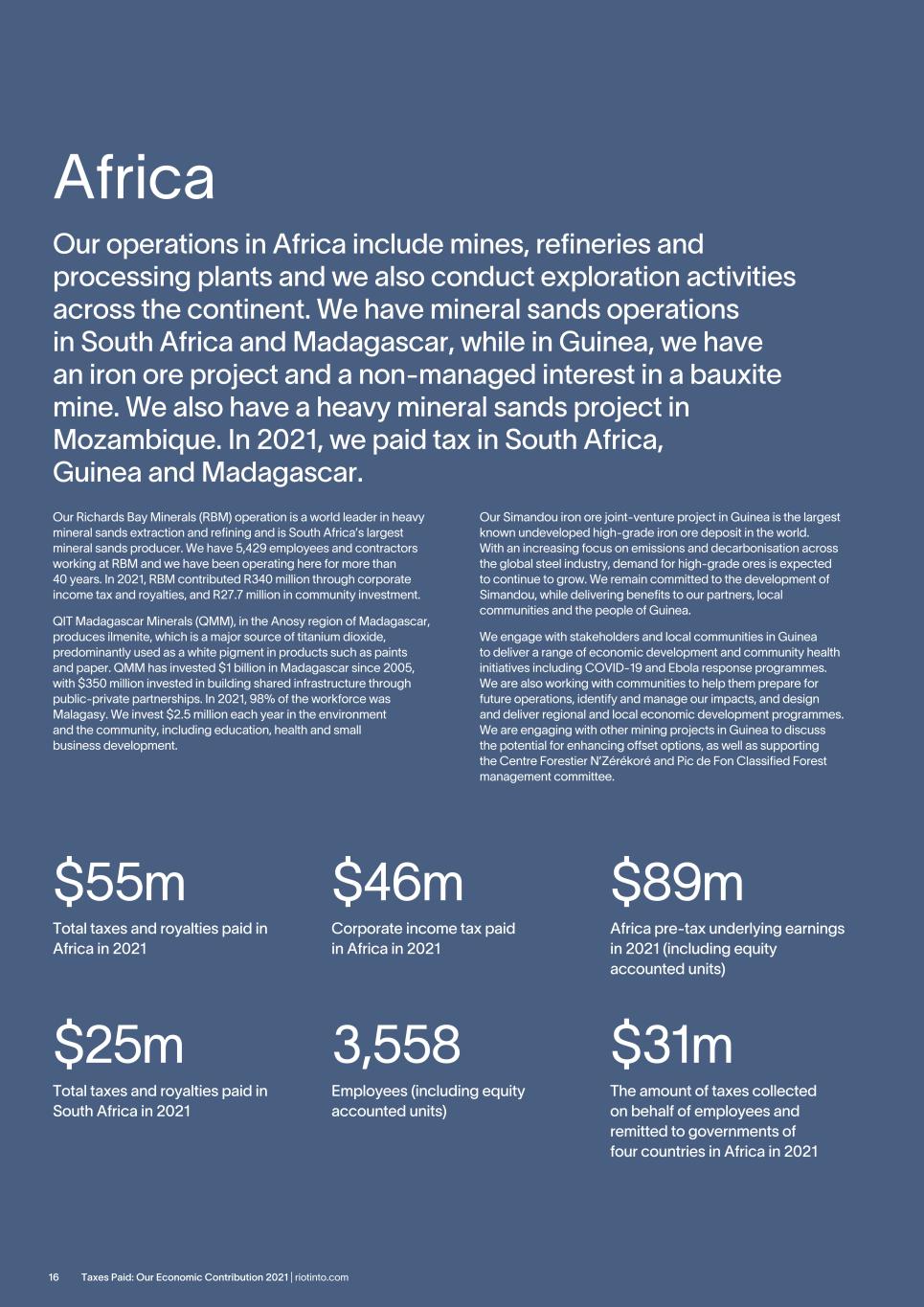
Africa Our operations in Africa include mines, refineries and processing plants and we also conduct exploration activities across the continent. We have mineral sands operations in South Africa and Madagascar, while in Guinea, we have an iron ore project and a non-managed interest in a bauxite mine. We also have a heavy mineral sands project in Mozambique. In 2021, we paid tax in South Africa, Guinea and Madagascar. Our Simandou iron ore joint-venture project in Guinea is the largest known undeveloped high-grade iron ore deposit in the world. With an increasing focus on emissions and decarbonisation across the global steel industry, demand for high-grade ores is expected to continue to grow. We remain committed to the development of Simandou, while delivering benefits to our partners, local communities and the people of Guinea. We engage with stakeholders and local communities in Guinea to deliver a range of economic development and community health initiatives including COVID-19 and Ebola response programmes. We are also working with communities to help them prepare for future operations, identify and manage our impacts, and design and deliver regional and local economic development programmes. We are engaging with other mining projects in Guinea to discuss the potential for enhancing offset options, as well as supporting the Centre Forestier N’Zérékoré and Pic de Fon Classified Forest management committee. Our Richards Bay Minerals (RBM) operation is a world leader in heavy mineral sands extraction and refining and is South Africa’s largest mineral sands producer. We have 5,429 employees and contractors working at RBM and we have been operating here for more than 40 years. In 2021, RBM contributed R340 million through corporate income tax and royalties, and R27.7 million in community investment. QIT Madagascar Minerals (QMM), in the Anosy region of Madagascar, produces ilmenite, which is a major source of titanium dioxide, predominantly used as a white pigment in products such as paints and paper. QMM has invested $1 billion in Madagascar since 2005, with $350 million invested in building shared infrastructure through public-private partnerships. In 2021, 98% of the workforce was Malagasy. We invest $2.5 million each year in the environment and the community, including education, health and small business development. 3,558 Employees (including equity accounted units) $25m Total taxes and royalties paid in South Africa in 2021 $55m Total taxes and royalties paid in Africa in 2021 $89m Africa pre-tax underlying earnings in 2021 (including equity accounted units) $31m The amount of taxes collected on behalf of employees and remitted to governments of four countries in Africa in 2021 $46m Corporate income tax paid in Africa in 2021 Taxes Paid: Our Economic Contribution 2021 | riotinto.com16
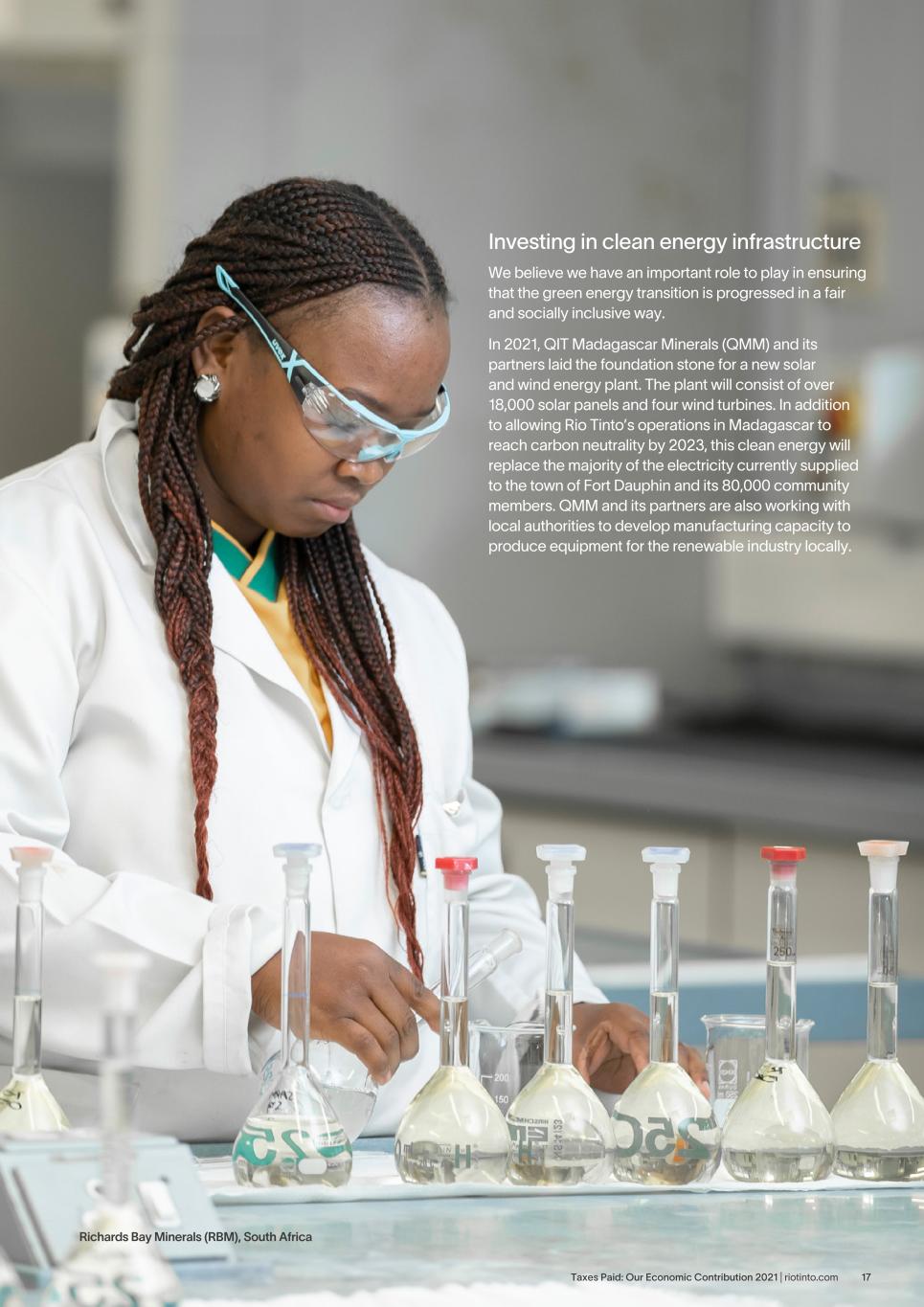
Investing in clean energy infrastructure We believe we have an important role to play in ensuring that the green energy transition is progressed in a fair and socially inclusive way. In 2021, QIT Madagascar Minerals (QMM) and its partners laid the foundation stone for a new solar and wind energy plant. The plant will consist of over 18,000 solar panels and four wind turbines. In addition to allowing Rio Tinto’s operations in Madagascar to reach carbon neutrality by 2023, this clean energy will replace the majority of the electricity currently supplied to the town of Fort Dauphin and its 80,000 community members. QMM and its partners are also working with local authorities to develop manufacturing capacity to produce equipment for the renewable industry locally. Richards Bay Minerals (RBM), South Africa 17Taxes Paid: Our Economic Contribution 2021 | riotinto.com
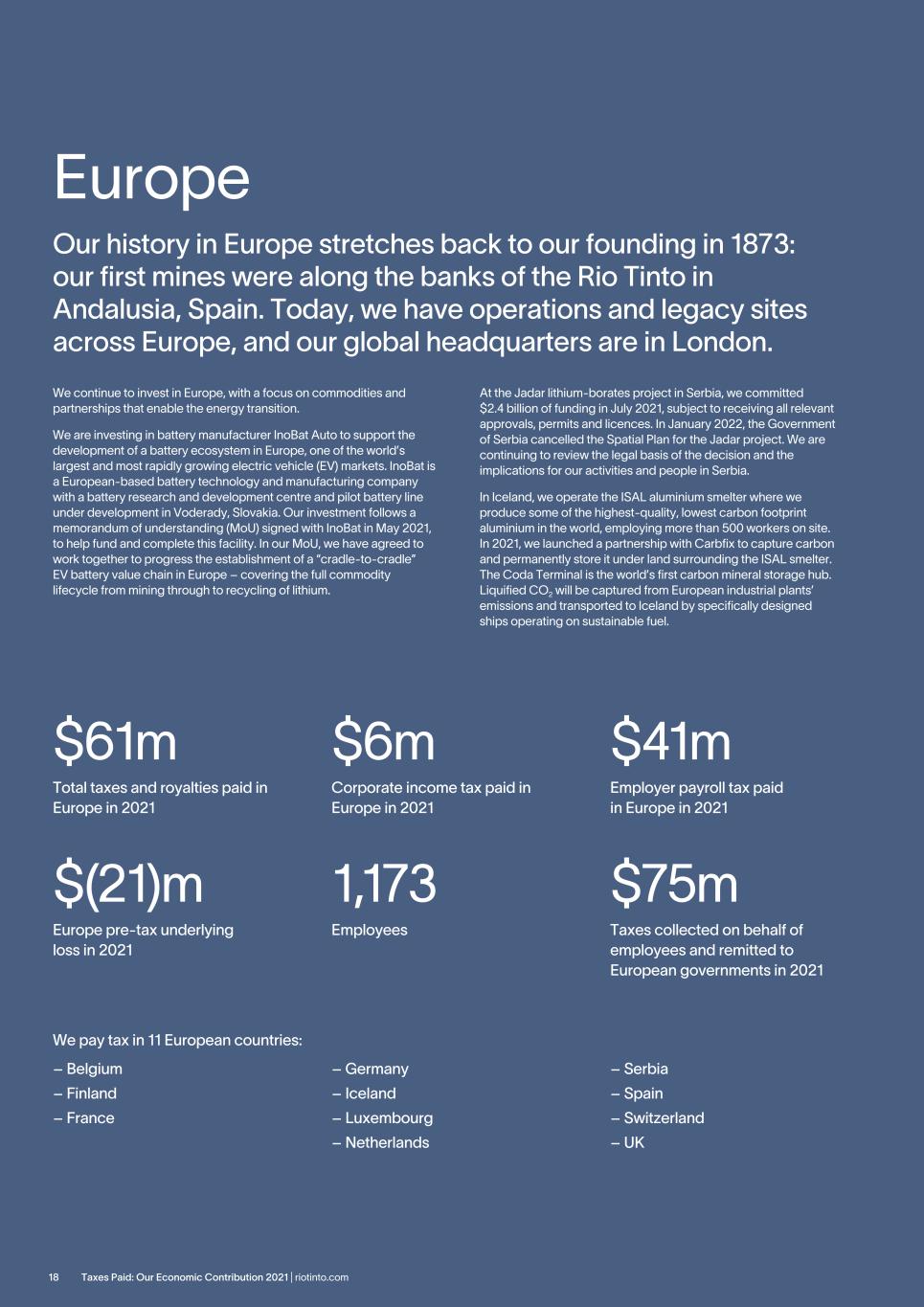
Europe Our history in Europe stretches back to our founding in 1873: our first mines were along the banks of the Rio Tinto in Andalusia, Spain. Today, we have operations and legacy sites across Europe, and our global headquarters are in London. At the Jadar lithium-borates project in Serbia, we committed $2.4 billion of funding in July 2021, subject to receiving all relevant approvals, permits and licences. In January 2022, the Government of Serbia cancelled the Spatial Plan for the Jadar project. We are continuing to review the legal basis of the decision and the implications for our activities and people in Serbia. In Iceland, we operate the ISAL aluminium smelter where we produce some of the highest-quality, lowest carbon footprint aluminium in the world, employing more than 500 workers on site. In 2021, we launched a partnership with Carbfix to capture carbon and permanently store it under land surrounding the ISAL smelter. The Coda Terminal is the world’s first carbon mineral storage hub. Liquified CO2 will be captured from European industrial plants’ emissions and transported to Iceland by specifically designed ships operating on sustainable fuel. We continue to invest in Europe, with a focus on commodities and partnerships that enable the energy transition. We are investing in battery manufacturer InoBat Auto to support the development of a battery ecosystem in Europe, one of the world’s largest and most rapidly growing electric vehicle (EV) markets. InoBat is a European-based battery technology and manufacturing company with a battery research and development centre and pilot battery line under development in Voderady, Slovakia. Our investment follows a memorandum of understanding (MoU) signed with InoBat in May 2021, to help fund and complete this facility. In our MoU, we have agreed to work together to progress the establishment of a “cradle-to-cradle” EV battery value chain in Europe – covering the full commodity lifecycle from mining through to recycling of lithium. 1,173 Employees $6m Corporate income tax paid in Europe in 2021 $61m Total taxes and royalties paid in Europe in 2021 $(21)m Europe pre-tax underlying loss in 2021 $75m Taxes collected on behalf of employees and remitted to European governments in 2021 – Belgium – Finland – France We pay tax in 11 European countries: – Germany – Iceland – Luxembourg – Netherlands – Serbia – Spain – Switzerland – UK $41m Employer payroll tax paid in Europe in 2021 Taxes Paid: Our Economic Contribution 2021 | riotinto.com18

ISAL aluminium smelter, Iceland 19Taxes Paid: Our Economic Contribution 2021 | riotinto.com
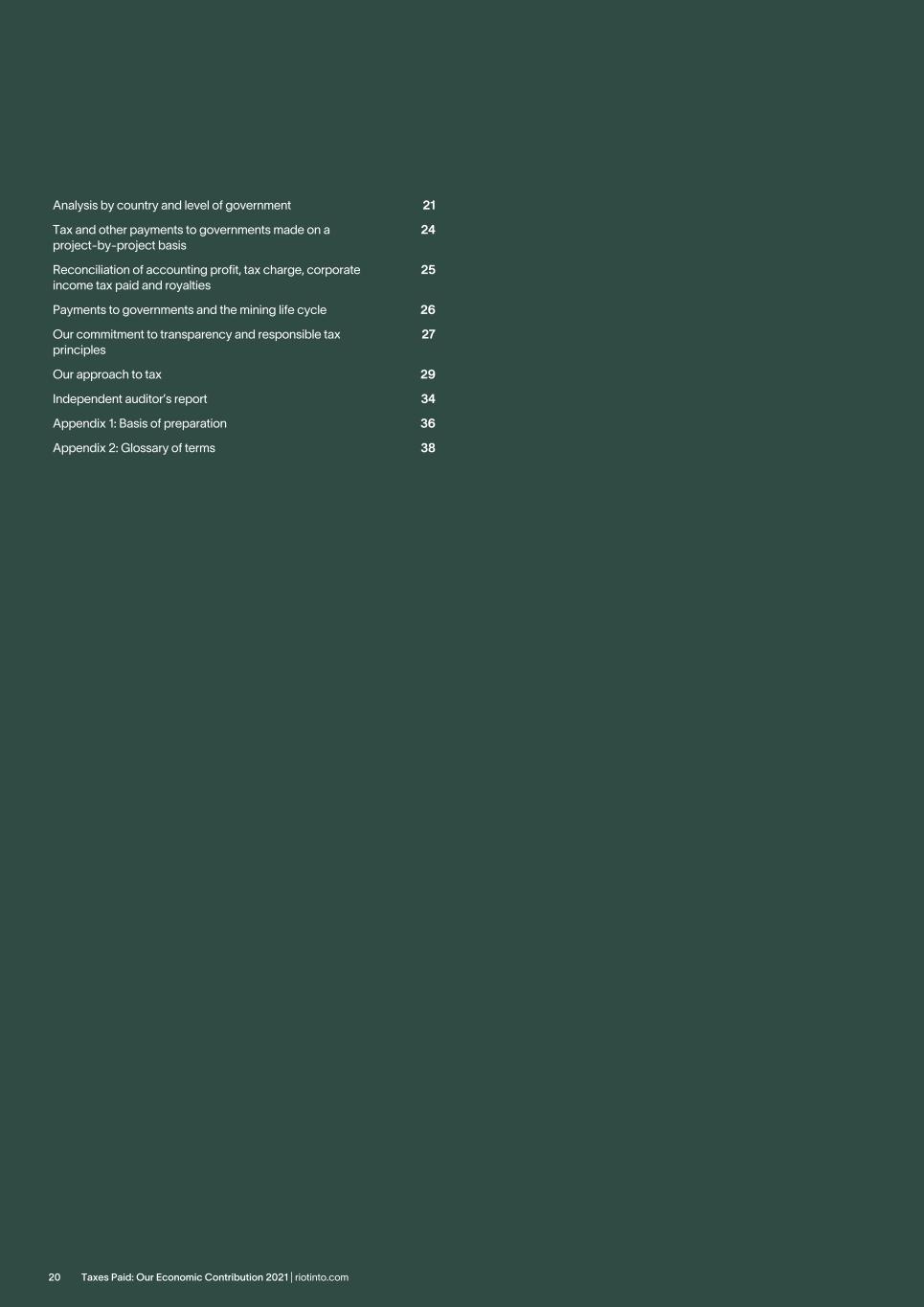
Analysis by country and level of government 21 Tax and other payments to governments made on a project-by-project basis 24 Reconciliation of accounting profit, tax charge, corporate income tax paid and royalties 25 Payments to governments and the mining life cycle 26 Our commitment to transparency and responsible tax principles 27 Our approach to tax 29 Independent auditor’s report 34 Appendix 1: Basis of preparation 36 Appendix 2: Glossary of terms 38 Taxes Paid: Our Economic Contribution 2021 | riotinto.com20

Analysis by country and level of government This table shows the total of all tax and other payments to governments for every country where the Rio Tinto Group paid at least $100,000 in 2021. We do not earn any significant profit in countries not listed in this table. Within each country, total tax payments (net of refunds) are reported by the national, regional, or local government to which they are paid. The analysis by country and level of government is prepared in accordance with the basis of preparation in Appendix 1. Country and level of government ($US millions) Corporate income tax Government royalties Fees, dividends and other extractive related payments Employer payroll taxes Other taxes and payments Total tax payments borne Employee payroll taxes Australia Total 7,716.0 3,069.3 11.7 218.4 77.3 11,092.7 768.8 Australian Taxation Office 7,716.0 3.3 – 50.7 9.4 7,779.4 768.8 State of Western Australia – 2,959.6 2.6 125.0 41.8 3,129.0 – State of Queensland – 68.8 1.6 31.3 5.1 106.8 – Northern Territory Revenue Office – 37.6 7.5 4.4 0.3 49.8 – State of Tasmania – – – 3.0 0.1 3.1 – State of New South Wales – – – 2.6 – 2.6 – State of Victoria – – – 1.4 0.3 1.7 – Shire of Ashburton (WA) – – – – 6.0 6.0 – Gladstone Regional Council (QLD) – – – – 5.0 5.0 – City of Karratha (WA) – – – – 4.4 4.4 – West Arnhem Shire Council (NT) – – – – 1.4 1.4 – Weipa Town Authority (QLD) – – – – 1.3 1.3 – Shire of East Pilbara (WA) – – – – 1.1 1.1 – Cook Shire Council (QLD) – – – – 0.5 0.5 – George Town Council (TAS) – – – – 0.2 0.2 – Town of Port Hedland (WA) – – – – 0.2 0.2 – Other Australian Governments – – – – 0.2 0.2 – Canada Total 562.7 64.9 14.4 104.8 107.7 854.5 446.7 Canada Revenue Agency 487.1 – – 19.8 1.2 508.1 264.8 Revenue Québec 12.7 – – 74.7 2.5 89.9 180.6 Government of Newfoundland and Labrador 58.4 – 0.5 6.1 6.1 71.1 – Ministre des Finances du Québec – 54.1 – – 0.9 55.0 – Ville de Saguenay (QC) – – 0.4 – 27.5 27.9 – Ministry of Finance of British Columbia – 10.8 – 3.3 7.6 21.7 – District of Kitimat (BC) – – – – 19.8 19.8 – Government of Northwest Territories 4.6 – 4.3 0.9 4.8 14.6 1.3 Ville d'Alma (QC) – – – – 9.7 9.7 – Town of Labrador City (NL) – – – – 7.3 7.3 – Commission Scolaire du Fer (QC) – – – – 4.2 4.2 – Les Innus de Uashat mak Mani-utenam and Les Innus de Matimekush-Lac John¹ – – 3.5 – – 3.5 – Ville de Sept-Îles (QC) – – – – 3.3 3.3 – Innu Nation (Labrador)¹ – – 2.8 – 0.4 3.2 – MRC Maria-Chapdelaine (QC) – – – – 2.3 2.3 – Ville de St-Joseph-de-Sorel (QC) – – – – 2.0 2.0 – MRC du Fjord-du-Saguenay (QC) – – – – 1.5 1.5 – Ville de Sorel-Tracy (QC) – – – – 1.1 1.1 – Conseil des Innus de Ekuanitshit¹ – – 1.0 – 0.1 1.1 – Ville de Bécancour (QC) – – – – 1.0 1.0 – Municipalité de Ste-Monique de Honfleur (QC) – – – – 1.0 1.0 – Tlicho Government¹ – – 0.9 – – 0.9 – Municipalité de Péribonka (QC) – – – – 0.6 0.6 – Yellowknives Dene First Nation¹ – – 0.5 – – 0.5 – Strathcona County (AB) – – 0.2 – 0.3 0.5 – Municipalité de Havre-St-Pierre (QC) – – – – 0.4 0.4 – Commission Scolaire de la Jonquiére (QC) – – – – 0.4 0.4 – Commission Scolaire du Lac-Saint-Jean (QC) – – – – 0.4 0.4 – Commission Scolaire des Rives-du-Saguenay (QC) – – – – 0.3 0.3 – Lutsel K'e Dene First Nation¹ – – 0.2 – – 0.2 – Government of Alberta (0.1) – – – 0.2 0.1 – Other Canadian Governments – – 0.1 – 0.8 0.9 – 21Taxes Paid: Our Economic Contribution 2021 | riotinto.com

Country and level of government ($US millions) Corporate income tax Government royalties Fees, dividends and other extractive related payments Employer payroll taxes Other taxes and payments Total tax payments borne Employee payroll taxes Chile Total 554.5 – 1.9 – 5.7 562.1 22.2 Servicio de Impuestos Internos 554.5 – 1.9 – 5.7 562.1 22.2 Mongolia Total2 0.2 124.8 14.2 24.4 380.5 544.1 23.9 General Department of Taxation 0.1 124.8 – – 240.3 365.2 – Ulaanbaatar City 0.1 – – 24.4 75.3 99.8 13.2 Umnugovi Province – – 4.7 – 28.2 32.9 10.7 General Department of Customs – – – – 36.7 36.7 – Gobi Oyu Development Support Fund¹ – – 5.7 – – 5.7 – Erdenes Oyu Tolgoi LLC1 – – 2.0 – – 2.0 – Other Mongolian Government Agencies – – 1.8 – – 1.8 – USA Total (31.9) 17.7 53.3 27.9 13.6 80.6 96.2 Internal Revenue Service (34.5) – – 27.3 0.2 (7.0) 77.1 Salt Lake County (UT) – – 44.0 – 0.2 44.2 – Utah State Tax Commission – 17.7 – 0.3 2.1 20.1 11.7 Kern County (CA) – – 9.3 – – 9.3 – California Franchise Tax Board 1.5 – – 0.3 2.9 4.7 5.5 Ohio Treasurer of State 0.3 – – – 3.4 3.7 – Pinal County (AZ) – – – – 1.1 1.1 – Texas Department of Revenue 0.3 – – – 0.6 0.9 – New Mexico Department of Revenue – – – – 0.7 0.7 – Arizona Department of Revenue – – – – 0.6 0.6 0.7 Minnesota Department of Revenue – – – – 0.5 0.5 – Los Angeles County (CA) – – – – 0.4 0.4 – Inyo County (CA) – – – – 0.2 0.2 – U.S. Customs and Border Protection – – – – 0.2 0.2 – Kentucky Department of Revenue 0.1 – – – – 0.1 – South Carolina Department of Revenue – – – – 0.1 0.1 – Wisconsin Department of Revenue – – – – 0.1 0.1 – Illinois Department of Revenue – – – – – – 0.7 Other US Governments 0.4 – – – 0.3 0.7 0.5 Singapore Total 28.4 – – – – 28.4 – Inland Revenue Authority of Singapore 28.4 – – – – 28.4 – China Total 23.1 – – 1.5 1.6 26.2 2.9 State Administration of Taxation 23.1 – – – 1.5 24.6 0.2 Shanghai Municipality – – – 1.0 – 1.0 2.2 Beijing Municipality – – – 0.5 0.1 0.6 0.5 South Africa Total 22.2 1.0 – 1.3 0.6 25.1 28.3 South African Revenue Service 22.2 1.0 – 1.3 0.6 25.1 28.3 UK Total 1.3 – – 13.7 9.1 24.1 48.2 Her Majesty's Revenue and Customs 1.3 – – 13.7 0.1 15.1 48.2 Westminster City Council – – – – 9.0 9.0 – Guinea Total 22.7 – – – 0.1 22.8 0.6 Presidency of the Republic of Guinea 22.7 – – – 0.1 22.8 0.6 France Total – – – 14.3 (0.3) 14.0 5.2 Directorate General of Public Finance – – – – (0.3) (0.3) – Direction Générale des Finances Publiques– Rhône-Alpes – – – 10.8 – 10.8 4.0 Union de Recouvrement des Cotisations de Sécurité Sociale et d’Allocations Familiales – – – 3.5 – 3.5 1.2 Peru Total 0.1 – 12.2 0.9 – 13.2 1.0 The National Superintendency of Customs and Tax Administration 0.1 – 12.2 0.9 – 13.2 1.0 Iceland Total – – 0.1 8.3 3.9 12.3 13.8 Directorate of Internal Revenue – – 0.1 8.3 3.9 12.3 13.8 Brazil Total 2.9 1.1 0.3 3.1 1.7 9.1 1.5 Federal Revenue of Brazil 2.9 1.1 0.3 3.1 1.7 9.1 1.5 Analysis by country and level of government continued Taxes Paid: Our Economic Contribution 2021 | riotinto.com22
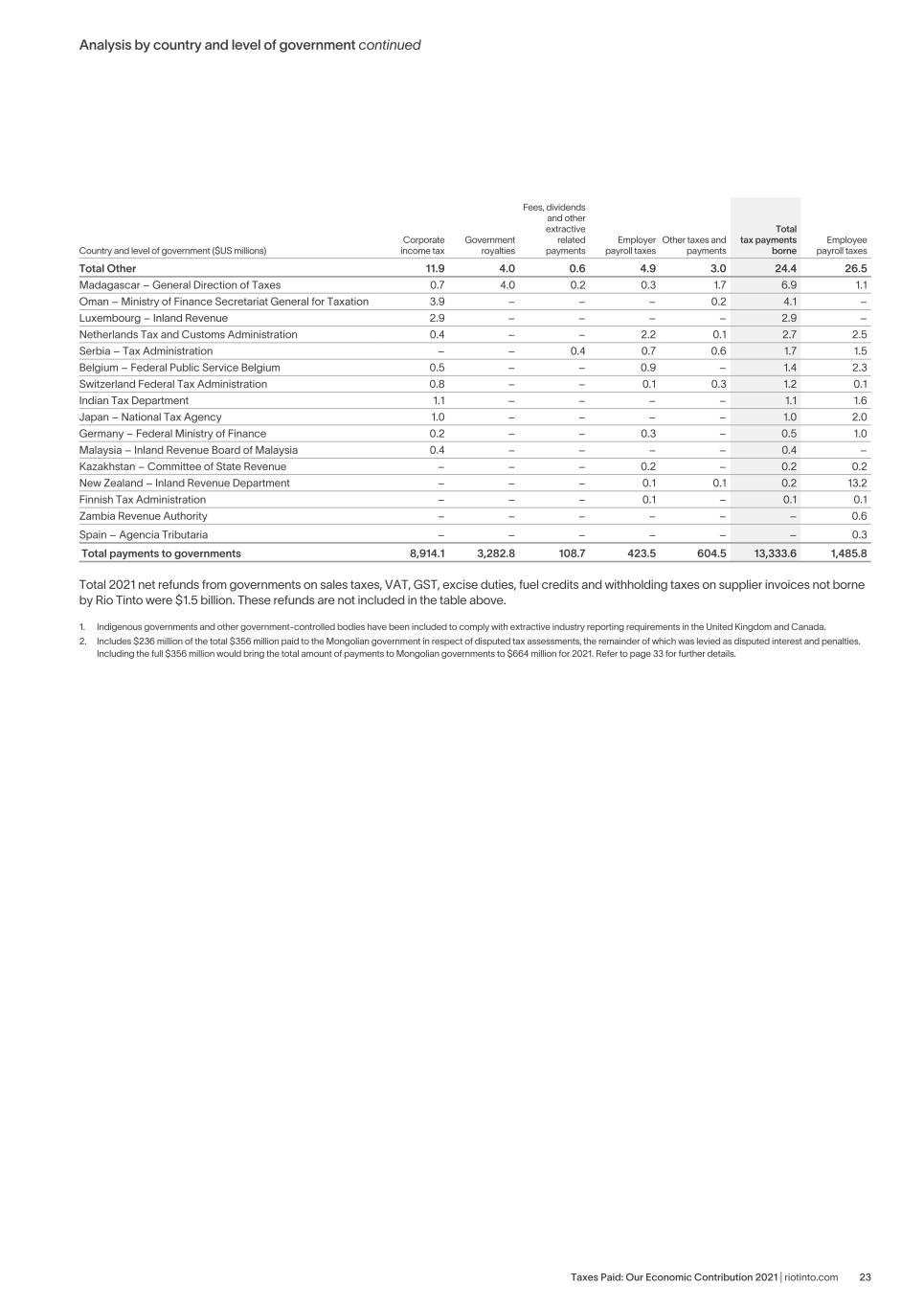
Country and level of government ($US millions) Corporate income tax Government royalties Fees, dividends and other extractive related payments Employer payroll taxes Other taxes and payments Total tax payments borne Employee payroll taxes Total Other 11.9 4.0 0.6 4.9 3.0 24.4 26.5 Madagascar – General Direction of Taxes 0.7 4.0 0.2 0.3 1.7 6.9 1.1 Oman – Ministry of Finance Secretariat General for Taxation 3.9 – – – 0.2 4.1 – Luxembourg – Inland Revenue 2.9 – – – – 2.9 – Netherlands Tax and Customs Administration 0.4 – – 2.2 0.1 2.7 2.5 Serbia – Tax Administration – – 0.4 0.7 0.6 1.7 1.5 Belgium – Federal Public Service Belgium 0.5 – – 0.9 – 1.4 2.3 Switzerland Federal Tax Administration 0.8 – – 0.1 0.3 1.2 0.1 Indian Tax Department 1.1 – – – – 1.1 1.6 Japan – National Tax Agency 1.0 – – – – 1.0 2.0 Germany – Federal Ministry of Finance 0.2 – – 0.3 – 0.5 1.0 Malaysia – Inland Revenue Board of Malaysia 0.4 – – – – 0.4 – Kazakhstan – Committee of State Revenue – – – 0.2 – 0.2 0.2 New Zealand – Inland Revenue Department – – – 0.1 0.1 0.2 13.2 Finnish Tax Administration – – – 0.1 – 0.1 0.1 Zambia Revenue Authority – – – – – – 0.6 Spain – Agencia Tributaria – – – – – – 0.3 Total payments to governments 8,914.1 3,282.8 108.7 423.5 604.5 13,333.6 1,485.8 Total 2021 net refunds from governments on sales taxes, VAT, GST, excise duties, fuel credits and withholding taxes on supplier invoices not borne by Rio Tinto were $1.5 billion. These refunds are not included in the table above. 1. Indigenous governments and other government-controlled bodies have been included to comply with extractive industry reporting requirements in the United Kingdom and Canada. 2. Includes $236 million of the total $356 million paid to the Mongolian government in respect of disputed tax assessments, the remainder of which was levied as disputed interest and penalties. Including the full $356 million would bring the total amount of payments to Mongolian governments to $664 million for 2021. Refer to page 33 for further details. Analysis by country and level of government continued 23Taxes Paid: Our Economic Contribution 2021 | riotinto.com
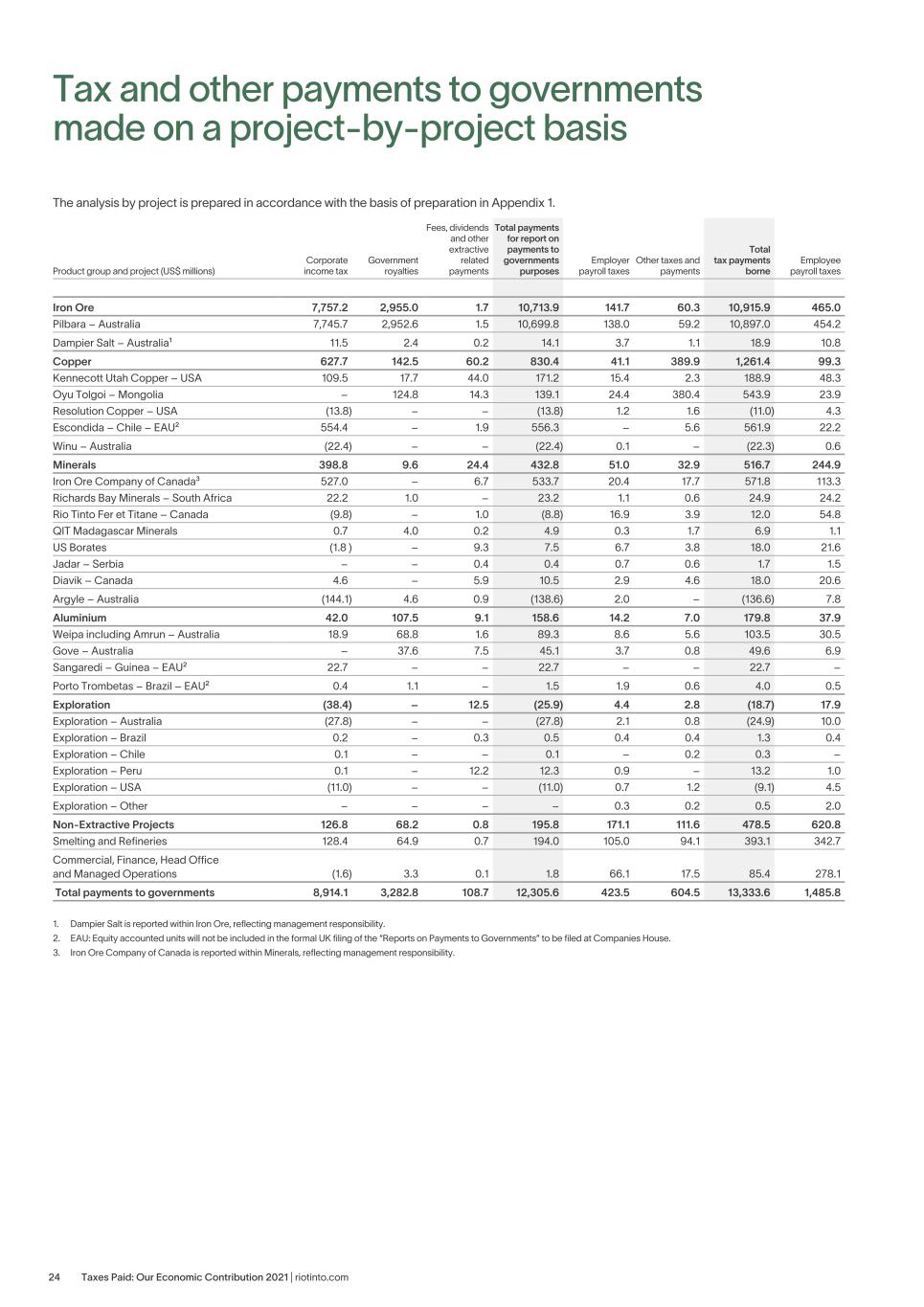
Tax and other payments to governments made on a project-by-project basis The analysis by project is prepared in accordance with the basis of preparation in Appendix 1. Product group and project (US$ millions) Corporate income tax Government royalties Fees, dividends and other extractive related payments Total payments for report on payments to governments purposes Employer payroll taxes Other taxes and payments Total tax payments borne Employee payroll taxes Iron Ore 7,757.2 2,955.0 1.7 10,713.9 141.7 60.3 10,915.9 465.0 Pilbara – Australia 7,745.7 2,952.6 1.5 10,699.8 138.0 59.2 10,897.0 454.2 Dampier Salt – Australia¹ 11.5 2.4 0.2 14.1 3.7 1.1 18.9 10.8 Copper 627.7 142.5 60.2 830.4 41.1 389.9 1,261.4 99.3 Kennecott Utah Copper – USA 109.5 17.7 44.0 171.2 15.4 2.3 188.9 48.3 Oyu Tolgoi – Mongolia – 124.8 14.3 139.1 24.4 380.4 543.9 23.9 Resolution Copper – USA (13.8) – – (13.8) 1.2 1.6 (11.0) 4.3 Escondida – Chile – EAU² 554.4 – 1.9 556.3 – 5.6 561.9 22.2 Winu – Australia (22.4) – – (22.4) 0.1 – (22.3) 0.6 Minerals 398.8 9.6 24.4 432.8 51.0 32.9 516.7 244.9 Iron Ore Company of Canada³ 527.0 – 6.7 533.7 20.4 17.7 571.8 113.3 Richards Bay Minerals – South Africa 22.2 1.0 – 23.2 1.1 0.6 24.9 24.2 Rio Tinto Fer et Titane – Canada (9.8) – 1.0 (8.8) 16.9 3.9 12.0 54.8 QIT Madagascar Minerals 0.7 4.0 0.2 4.9 0.3 1.7 6.9 1.1 US Borates (1.8 ) – 9.3 7.5 6.7 3.8 18.0 21.6 Jadar – Serbia – – 0.4 0.4 0.7 0.6 1.7 1.5 Diavik – Canada 4.6 – 5.9 10.5 2.9 4.6 18.0 20.6 Argyle – Australia (144.1) 4.6 0.9 (138.6) 2.0 – (136.6) 7.8 Aluminium 42.0 107.5 9.1 158.6 14.2 7.0 179.8 37.9 Weipa including Amrun – Australia 18.9 68.8 1.6 89.3 8.6 5.6 103.5 30.5 Gove – Australia – 37.6 7.5 45.1 3.7 0.8 49.6 6.9 Sangaredi – Guinea – EAU² 22.7 – – 22.7 – – 22.7 – Porto Trombetas – Brazil – EAU² 0.4 1.1 – 1.5 1.9 0.6 4.0 0.5 Exploration (38.4) – 12.5 (25.9) 4.4 2.8 (18.7) 17.9 Exploration – Australia (27.8) – – (27.8) 2.1 0.8 (24.9) 10.0 Exploration – Brazil 0.2 – 0.3 0.5 0.4 0.4 1.3 0.4 Exploration – Chile 0.1 – – 0.1 – 0.2 0.3 – Exploration – Peru 0.1 – 12.2 12.3 0.9 – 13.2 1.0 Exploration – USA (11.0) – – (11.0) 0.7 1.2 (9.1) 4.5 Exploration – Other – – – – 0.3 0.2 0.5 2.0 Non-Extractive Projects 126.8 68.2 0.8 195.8 171.1 111.6 478.5 620.8 Smelting and Refineries 128.4 64.9 0.7 194.0 105.0 94.1 393.1 342.7 Commercial, Finance, Head Office and Managed Operations (1.6) 3.3 0.1 1.8 66.1 17.5 85.4 278.1 Total payments to governments 8,914.1 3,282.8 108.7 12,305.6 423.5 604.5 13,333.6 1,485.8 1. Dampier Salt is reported within Iron Ore, reflecting management responsibility. 2. EAU: Equity accounted units will not be included in the formal UK filing of the “Reports on Payments to Governments” to be filed at Companies House. 3. Iron Ore Company of Canada is reported within Minerals, reflecting management responsibility. Taxes Paid: Our Economic Contribution 2021 | riotinto.com24

Reconciliation of accounting profit, tax charge, corporate income tax paid and royalties Reconciliation of 2021 accounting profit and total tax charge US$ millions Profit before tax 30,833 Less: share of profit after tax of equity accounted units (1,042) 29,791 Expected tax charge at UK rate of 19% 5,660 Higher rate of tax on Australian underlying earnings at 30% 2,693 Other tax rates applicable outside the UK and Australia 110 Impact of items excluded from underlying earnings (a) (127) Recognition of previously unrecognised deferred tax assets (212) Other items 134 Total tax charge 8,258 (a) Impact of items excluded from underlying earnings US$ millions Impairment charges (21) Exchange derivatives gains/(losses) (126) Losses from increases to closure estimates (non-operating and fully impaired sites) 84 Utilisation of capital losses on the gain from the recognition of the wharf at Kitimat, Canada (64) Total impact of exclusions (127) Reconciliation of government royalties expense to government royalties paid US$ millions Government royalties included in accounting profit 3,048 Difference between royalties paid and royalties accrued 235 Total government royalties paid 3,283 Effective corporate income tax rates on total earnings US$ millions Profit before tax Total tax charge Effective corporate income tax rate (%) Underlying earnings 30,298 (8,482) 28.0% Exclusions from underlying earnings (507) 224 44.2% 29,791 (8,258) 27.7% Add share of profit after tax of EAU 1,042 Total profit before tax 30,833 Reconciliation of 2021 total tax charge and current tax charge US$ millions Total tax charge 8,258 Temporary differences Unrealised exchange losses 0 Tax losses (375) Provisions 216 Capital allowances (42) Tax on unremitted earnings (1) Post-retirement benefits 21 Other temporary differences 67 Current tax charge 8,144 Reconciliation of 2021 current tax charge and corporate income tax paid US$ millions 2021 Current tax charge 8,144 Add current tax charge of equity accounted units 673 8,817 Final instalment in Australia on 2020 profits paid in H1 2021 862 Final instalment in Australia on 2021 profits due in H1 2022 (1,055) Tax payments greater than tax charges (timing) 290 Corporate income tax paid 8,914 25Taxes Paid: Our Economic Contribution 2021 | riotinto.com
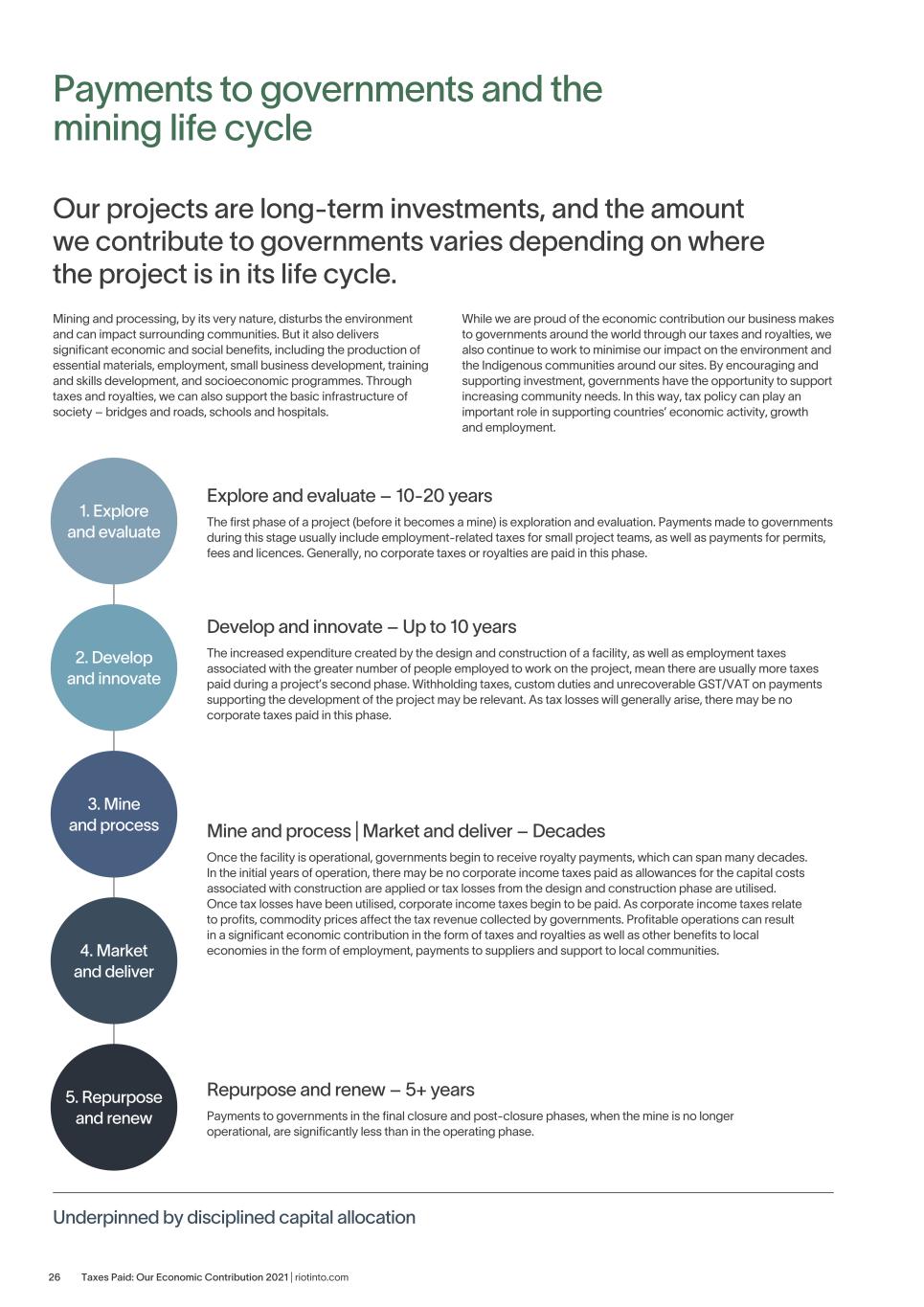
Our projects are long-term investments, and the amount we contribute to governments varies depending on where the project is in its life cycle. While we are proud of the economic contribution our business makes to governments around the world through our taxes and royalties, we also continue to work to minimise our impact on the environment and the Indigenous communities around our sites. By encouraging and supporting investment, governments have the opportunity to support increasing community needs. In this way, tax policy can play an important role in supporting countries’ economic activity, growth and employment. Mining and processing, by its very nature, disturbs the environment and can impact surrounding communities. But it also delivers significant economic and social benefits, including the production of essential materials, employment, small business development, training and skills development, and socioeconomic programmes. Through taxes and royalties, we can also support the basic infrastructure of society – bridges and roads, schools and hospitals. Underpinned by disciplined capital allocation Payments to governments and the mining life cycle Explore and evaluate – 10-20 years The first phase of a project (before it becomes a mine) is exploration and evaluation. Payments made to governments during this stage usually include employment-related taxes for small project teams, as well as payments for permits, fees and licences. Generally, no corporate taxes or royalties are paid in this phase. Develop and innovate – Up to 10 years The increased expenditure created by the design and construction of a facility, as well as employment taxes associated with the greater number of people employed to work on the project, mean there are usually more taxes paid during a project’s second phase. Withholding taxes, custom duties and unrecoverable GST/VAT on payments supporting the development of the project may be relevant. As tax losses will generally arise, there may be no corporate taxes paid in this phase. Mine and process | Market and deliver – Decades Once the facility is operational, governments begin to receive royalty payments, which can span many decades. In the initial years of operation, there may be no corporate income taxes paid as allowances for the capital costs associated with construction are applied or tax losses from the design and construction phase are utilised. Once tax losses have been utilised, corporate income taxes begin to be paid. As corporate income taxes relate to profits, commodity prices affect the tax revenue collected by governments. Profitable operations can result in a significant economic contribution in the form of taxes and royalties as well as other benefits to local economies in the form of employment, payments to suppliers and support to local communities. Repurpose and renew – 5+ years Payments to governments in the final closure and post-closure phases, when the mine is no longer operational, are significantly less than in the operating phase. 1. Explore and evaluate 2. Develop and innovate 3. Mine and process 4. Market and deliver 5. Repurpose and renew Taxes Paid: Our Economic Contribution 2021 | riotinto.com26
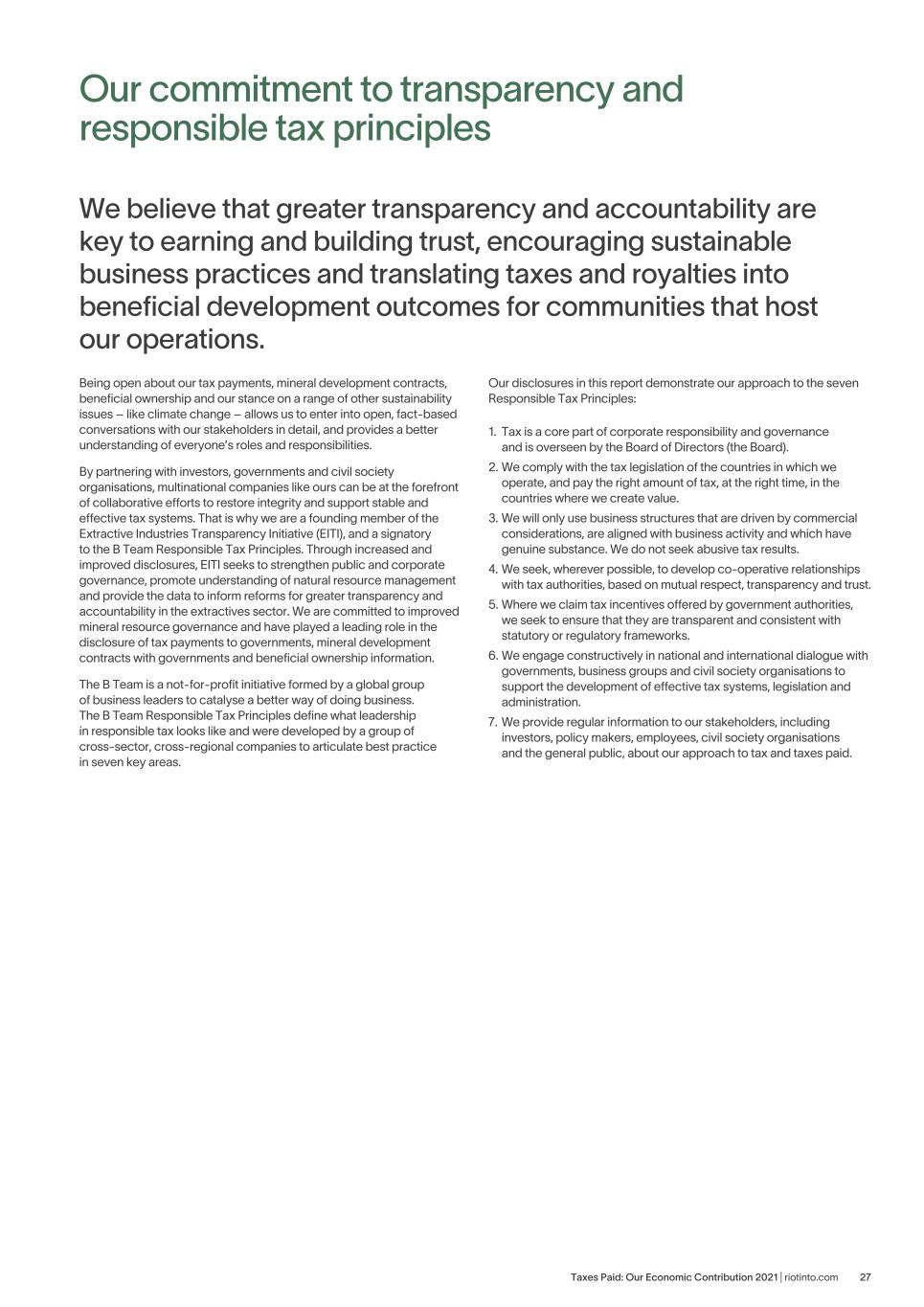
We believe that greater transparency and accountability are key to earning and building trust, encouraging sustainable business practices and translating taxes and royalties into beneficial development outcomes for communities that host our operations. Being open about our tax payments, mineral development contracts, beneficial ownership and our stance on a range of other sustainability issues – like climate change – allows us to enter into open, fact-based conversations with our stakeholders in detail, and provides a better understanding of everyone’s roles and responsibilities. By partnering with investors, governments and civil society organisations, multinational companies like ours can be at the forefront of collaborative efforts to restore integrity and support stable and effective tax systems. That is why we are a founding member of the Extractive Industries Transparency Initiative (EITI), and a signatory to the B Team Responsible Tax Principles. Through increased and improved disclosures, EITI seeks to strengthen public and corporate governance, promote understanding of natural resource management and provide the data to inform reforms for greater transparency and accountability in the extractives sector. We are committed to improved mineral resource governance and have played a leading role in the disclosure of tax payments to governments, mineral development contracts with governments and beneficial ownership information. The B Team is a not-for-profit initiative formed by a global group of business leaders to catalyse a better way of doing business. The B Team Responsible Tax Principles define what leadership in responsible tax looks like and were developed by a group of cross-sector, cross-regional companies to articulate best practice in seven key areas. Our disclosures in this report demonstrate our approach to the seven Responsible Tax Principles: 1. Tax is a core part of corporate responsibility and governance and is overseen by the Board of Directors (the Board). 2. We comply with the tax legislation of the countries in which we operate, and pay the right amount of tax, at the right time, in the countries where we create value. 3. We will only use business structures that are driven by commercial considerations, are aligned with business activity and which have genuine substance. We do not seek abusive tax results. 4. We seek, wherever possible, to develop co-operative relationships with tax authorities, based on mutual respect, transparency and trust. 5. Where we claim tax incentives offered by government authorities, we seek to ensure that they are transparent and consistent with statutory or regulatory frameworks. 6. We engage constructively in national and international dialogue with governments, business groups and civil society organisations to support the development of effective tax systems, legislation and administration. 7. We provide regular information to our stakeholders, including investors, policy makers, employees, civil society organisations and the general public, about our approach to tax and taxes paid. Our commitment to transparency and responsible tax principles 27Taxes Paid: Our Economic Contribution 2021 | riotinto.com
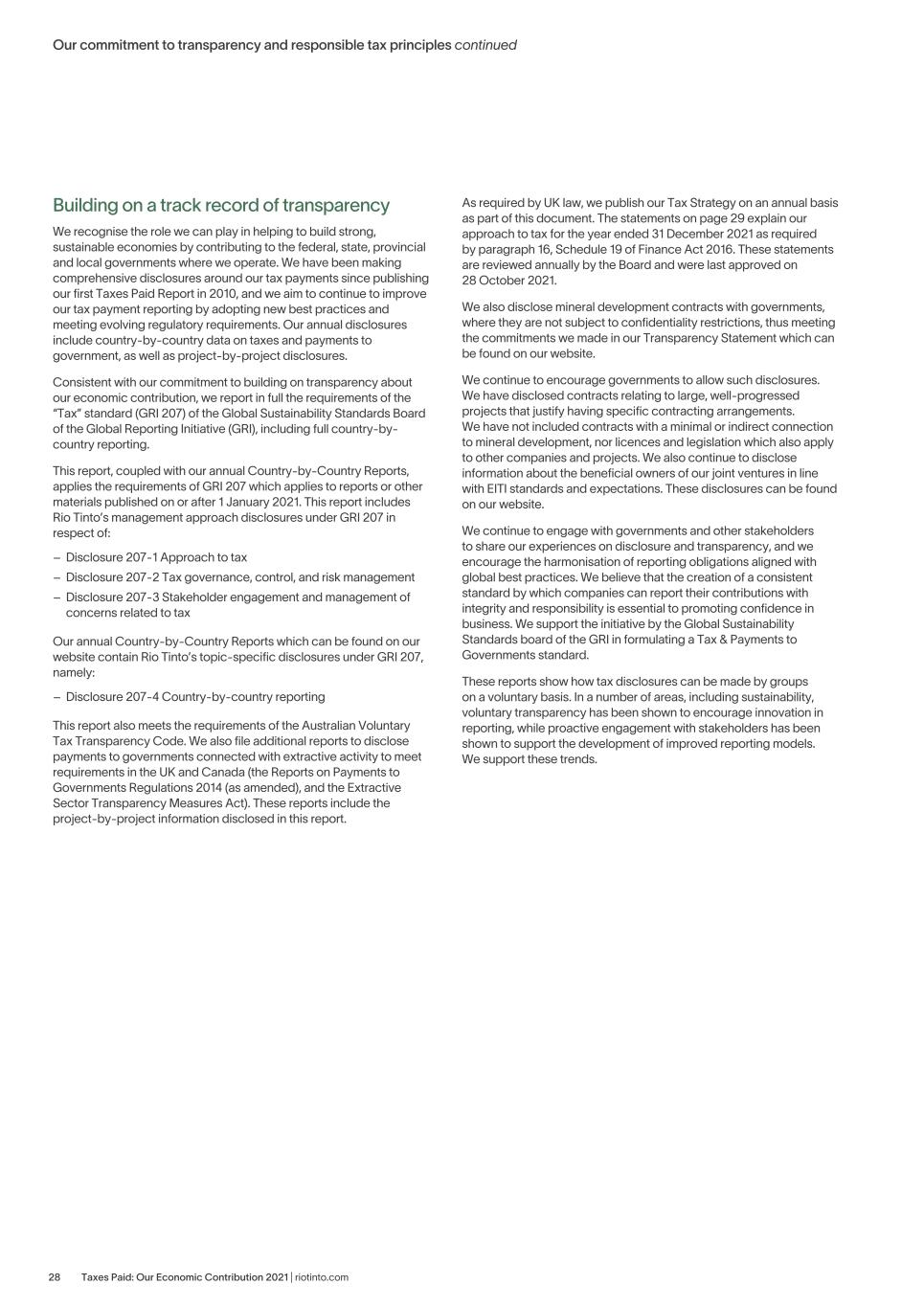
Building on a track record of transparency We recognise the role we can play in helping to build strong, sustainable economies by contributing to the federal, state, provincial and local governments where we operate. We have been making comprehensive disclosures around our tax payments since publishing our first Taxes Paid Report in 2010, and we aim to continue to improve our tax payment reporting by adopting new best practices and meeting evolving regulatory requirements. Our annual disclosures include country-by-country data on taxes and payments to government, as well as project-by-project disclosures. Consistent with our commitment to building on transparency about our economic contribution, we report in full the requirements of the “Tax” standard (GRI 207) of the Global Sustainability Standards Board of the Global Reporting Initiative (GRI), including full country-by- country reporting. This report, coupled with our annual Country-by-Country Reports, applies the requirements of GRI 207 which applies to reports or other materials published on or after 1 January 2021. This report includes Rio Tinto’s management approach disclosures under GRI 207 in respect of: – Disclosure 207-1 Approach to tax – Disclosure 207-2 Tax governance, control, and risk management – Disclosure 207-3 Stakeholder engagement and management of concerns related to tax Our annual Country-by-Country Reports which can be found on our website contain Rio Tinto’s topic-specific disclosures under GRI 207, namely: – Disclosure 207-4 Country-by-country reporting This report also meets the requirements of the Australian Voluntary Tax Transparency Code. We also file additional reports to disclose payments to governments connected with extractive activity to meet requirements in the UK and Canada (the Reports on Payments to Governments Regulations 2014 (as amended), and the Extractive Sector Transparency Measures Act). These reports include the project-by-project information disclosed in this report. As required by UK law, we publish our Tax Strategy on an annual basis as part of this document. The statements on page 29 explain our approach to tax for the year ended 31 December 2021 as required by paragraph 16, Schedule 19 of Finance Act 2016. These statements are reviewed annually by the Board and were last approved on 28 October 2021. We also disclose mineral development contracts with governments, where they are not subject to confidentiality restrictions, thus meeting the commitments we made in our Transparency Statement which can be found on our website. We continue to encourage governments to allow such disclosures. We have disclosed contracts relating to large, well-progressed projects that justify having specific contracting arrangements. We have not included contracts with a minimal or indirect connection to mineral development, nor licences and legislation which also apply to other companies and projects. We also continue to disclose information about the beneficial owners of our joint ventures in line with EITI standards and expectations. These disclosures can be found on our website. We continue to engage with governments and other stakeholders to share our experiences on disclosure and transparency, and we encourage the harmonisation of reporting obligations aligned with global best practices. We believe that the creation of a consistent standard by which companies can report their contributions with integrity and responsibility is essential to promoting confidence in business. We support the initiative by the Global Sustainability Standards board of the GRI in formulating a Tax & Payments to Governments standard. These reports show how tax disclosures can be made by groups on a voluntary basis. In a number of areas, including sustainability, voluntary transparency has been shown to encourage innovation in reporting, while proactive engagement with stakeholders has been shown to support the development of improved reporting models. We support these trends. Our commitment to transparency and responsible tax principles continued Taxes Paid: Our Economic Contribution 2021 | riotinto.com28
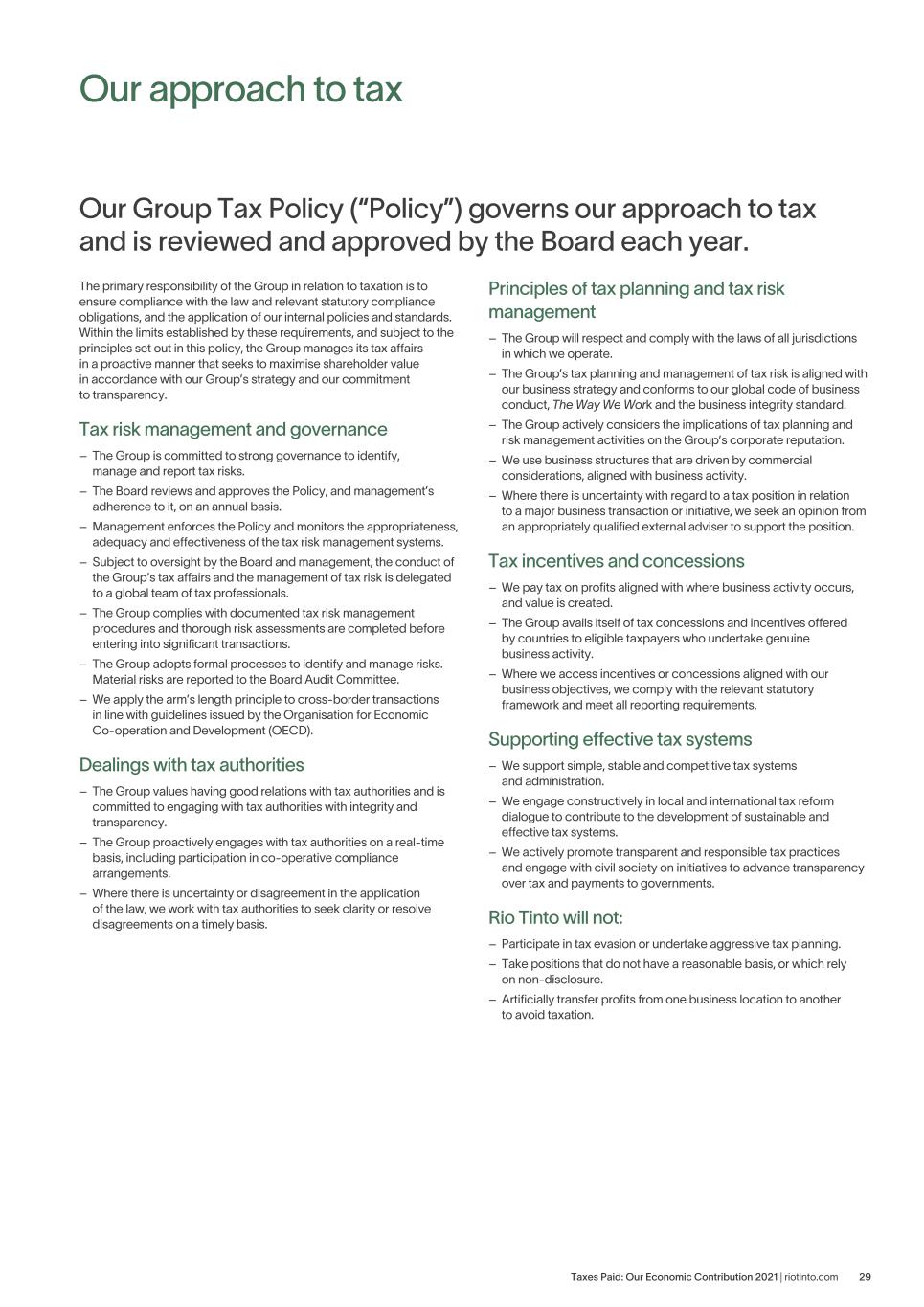
Our Group Tax Policy (“Policy”) governs our approach to tax and is reviewed and approved by the Board each year. The primary responsibility of the Group in relation to taxation is to ensure compliance with the law and relevant statutory compliance obligations, and the application of our internal policies and standards. Within the limits established by these requirements, and subject to the principles set out in this policy, the Group manages its tax affairs in a proactive manner that seeks to maximise shareholder value in accordance with our Group’s strategy and our commitment to transparency. Tax risk management and governance – The Group is committed to strong governance to identify, manage and report tax risks. – The Board reviews and approves the Policy, and management’s adherence to it, on an annual basis. – Management enforces the Policy and monitors the appropriateness, adequacy and effectiveness of the tax risk management systems. – Subject to oversight by the Board and management, the conduct of the Group’s tax affairs and the management of tax risk is delegated to a global team of tax professionals. – The Group complies with documented tax risk management procedures and thorough risk assessments are completed before entering into significant transactions. – The Group adopts formal processes to identify and manage risks. Material risks are reported to the Board Audit Committee. – We apply the arm’s length principle to cross-border transactions in line with guidelines issued by the Organisation for Economic Co-operation and Development (OECD). Dealings with tax authorities – The Group values having good relations with tax authorities and is committed to engaging with tax authorities with integrity and transparency. – The Group proactively engages with tax authorities on a real-time basis, including participation in co-operative compliance arrangements. – Where there is uncertainty or disagreement in the application of the law, we work with tax authorities to seek clarity or resolve disagreements on a timely basis. Principles of tax planning and tax risk management – The Group will respect and comply with the laws of all jurisdictions in which we operate. – The Group’s tax planning and management of tax risk is aligned with our business strategy and conforms to our global code of business conduct, The Way We Work and the business integrity standard. – The Group actively considers the implications of tax planning and risk management activities on the Group’s corporate reputation. – We use business structures that are driven by commercial considerations, aligned with business activity. – Where there is uncertainty with regard to a tax position in relation to a major business transaction or initiative, we seek an opinion from an appropriately qualified external adviser to support the position. Tax incentives and concessions – We pay tax on profits aligned with where business activity occurs, and value is created. – The Group avails itself of tax concessions and incentives offered by countries to eligible taxpayers who undertake genuine business activity. – Where we access incentives or concessions aligned with our business objectives, we comply with the relevant statutory framework and meet all reporting requirements. Supporting effective tax systems – We support simple, stable and competitive tax systems and administration. – We engage constructively in local and international tax reform dialogue to contribute to the development of sustainable and effective tax systems. – We actively promote transparent and responsible tax practices and engage with civil society on initiatives to advance transparency over tax and payments to governments. Rio Tinto will not: – Participate in tax evasion or undertake aggressive tax planning. – Take positions that do not have a reasonable basis, or which rely on non-disclosure. – Artificially transfer profits from one business location to another to avoid taxation. Our approach to tax 29Taxes Paid: Our Economic Contribution 2021 | riotinto.com
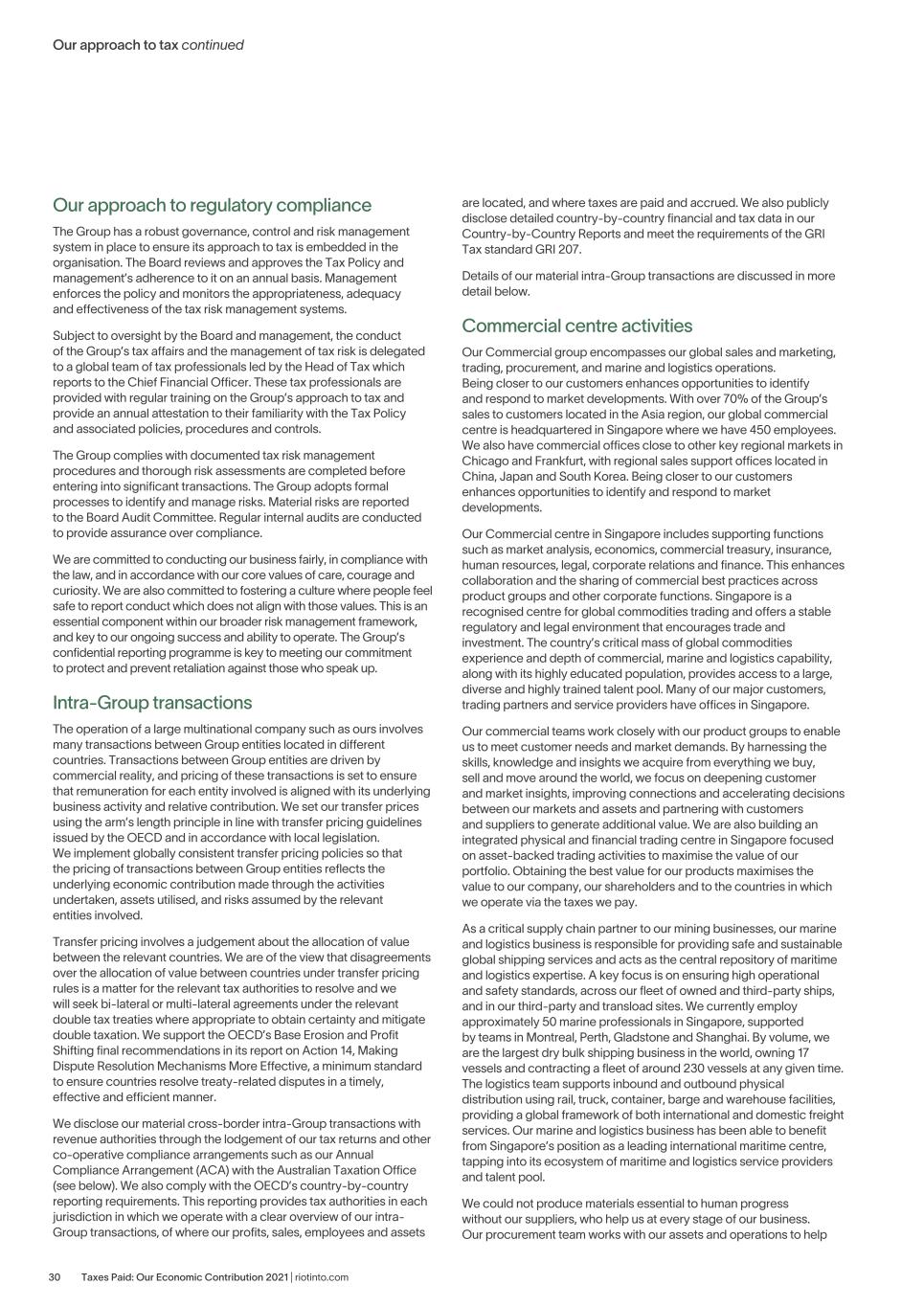
Our approach to regulatory compliance The Group has a robust governance, control and risk management system in place to ensure its approach to tax is embedded in the organisation. The Board reviews and approves the Tax Policy and management’s adherence to it on an annual basis. Management enforces the policy and monitors the appropriateness, adequacy and effectiveness of the tax risk management systems. Subject to oversight by the Board and management, the conduct of the Group’s tax affairs and the management of tax risk is delegated to a global team of tax professionals led by the Head of Tax which reports to the Chief Financial Officer. These tax professionals are provided with regular training on the Group’s approach to tax and provide an annual attestation to their familiarity with the Tax Policy and associated policies, procedures and controls. The Group complies with documented tax risk management procedures and thorough risk assessments are completed before entering into significant transactions. The Group adopts formal processes to identify and manage risks. Material risks are reported to the Board Audit Committee. Regular internal audits are conducted to provide assurance over compliance. We are committed to conducting our business fairly, in compliance with the law, and in accordance with our core values of care, courage and curiosity. We are also committed to fostering a culture where people feel safe to report conduct which does not align with those values. This is an essential component within our broader risk management framework, and key to our ongoing success and ability to operate. The Group’s confidential reporting programme is key to meeting our commitment to protect and prevent retaliation against those who speak up. Intra-Group transactions The operation of a large multinational company such as ours involves many transactions between Group entities located in different countries. Transactions between Group entities are driven by commercial reality, and pricing of these transactions is set to ensure that remuneration for each entity involved is aligned with its underlying business activity and relative contribution. We set our transfer prices using the arm’s length principle in line with transfer pricing guidelines issued by the OECD and in accordance with local legislation. We implement globally consistent transfer pricing policies so that the pricing of transactions between Group entities reflects the underlying economic contribution made through the activities undertaken, assets utilised, and risks assumed by the relevant entities involved. Transfer pricing involves a judgement about the allocation of value between the relevant countries. We are of the view that disagreements over the allocation of value between countries under transfer pricing rules is a matter for the relevant tax authorities to resolve and we will seek bi-lateral or multi-lateral agreements under the relevant double tax treaties where appropriate to obtain certainty and mitigate double taxation. We support the OECD’s Base Erosion and Profit Shifting final recommendations in its report on Action 14, Making Dispute Resolution Mechanisms More Effective, a minimum standard to ensure countries resolve treaty-related disputes in a timely, effective and efficient manner. We disclose our material cross-border intra-Group transactions with revenue authorities through the lodgement of our tax returns and other co-operative compliance arrangements such as our Annual Compliance Arrangement (ACA) with the Australian Taxation Office (see below). We also comply with the OECD’s country-by-country reporting requirements. This reporting provides tax authorities in each jurisdiction in which we operate with a clear overview of our intra- Group transactions, of where our profits, sales, employees and assets are located, and where taxes are paid and accrued. We also publicly disclose detailed country-by-country financial and tax data in our Country-by-Country Reports and meet the requirements of the GRI Tax standard GRI 207. Details of our material intra-Group transactions are discussed in more detail below. Commercial centre activities Our Commercial group encompasses our global sales and marketing, trading, procurement, and marine and logistics operations. Being closer to our customers enhances opportunities to identify and respond to market developments. With over 70% of the Group’s sales to customers located in the Asia region, our global commercial centre is headquartered in Singapore where we have 450 employees. We also have commercial offices close to other key regional markets in Chicago and Frankfurt, with regional sales support offices located in China, Japan and South Korea. Being closer to our customers enhances opportunities to identify and respond to market developments. Our Commercial centre in Singapore includes supporting functions such as market analysis, economics, commercial treasury, insurance, human resources, legal, corporate relations and finance. This enhances collaboration and the sharing of commercial best practices across product groups and other corporate functions. Singapore is a recognised centre for global commodities trading and offers a stable regulatory and legal environment that encourages trade and investment. The country’s critical mass of global commodities experience and depth of commercial, marine and logistics capability, along with its highly educated population, provides access to a large, diverse and highly trained talent pool. Many of our major customers, trading partners and service providers have offices in Singapore. Our commercial teams work closely with our product groups to enable us to meet customer needs and market demands. By harnessing the skills, knowledge and insights we acquire from everything we buy, sell and move around the world, we focus on deepening customer and market insights, improving connections and accelerating decisions between our markets and assets and partnering with customers and suppliers to generate additional value. We are also building an integrated physical and financial trading centre in Singapore focused on asset-backed trading activities to maximise the value of our portfolio. Obtaining the best value for our products maximises the value to our company, our shareholders and to the countries in which we operate via the taxes we pay. As a critical supply chain partner to our mining businesses, our marine and logistics business is responsible for providing safe and sustainable global shipping services and acts as the central repository of maritime and logistics expertise. A key focus is on ensuring high operational and safety standards, across our fleet of owned and third-party ships, and in our third-party and transload sites. We currently employ approximately 50 marine professionals in Singapore, supported by teams in Montreal, Perth, Gladstone and Shanghai. By volume, we are the largest dry bulk shipping business in the world, owning 17 vessels and contracting a fleet of around 230 vessels at any given time. The logistics team supports inbound and outbound physical distribution using rail, truck, container, barge and warehouse facilities, providing a global framework of both international and domestic freight services. Our marine and logistics business has been able to benefit from Singapore’s position as a leading international maritime centre, tapping into its ecosystem of maritime and logistics service providers and talent pool. We could not produce materials essential to human progress without our suppliers, who help us at every stage of our business. Our procurement team works with our assets and operations to help Our approach to tax continued Taxes Paid: Our Economic Contribution 2021 | riotinto.com30
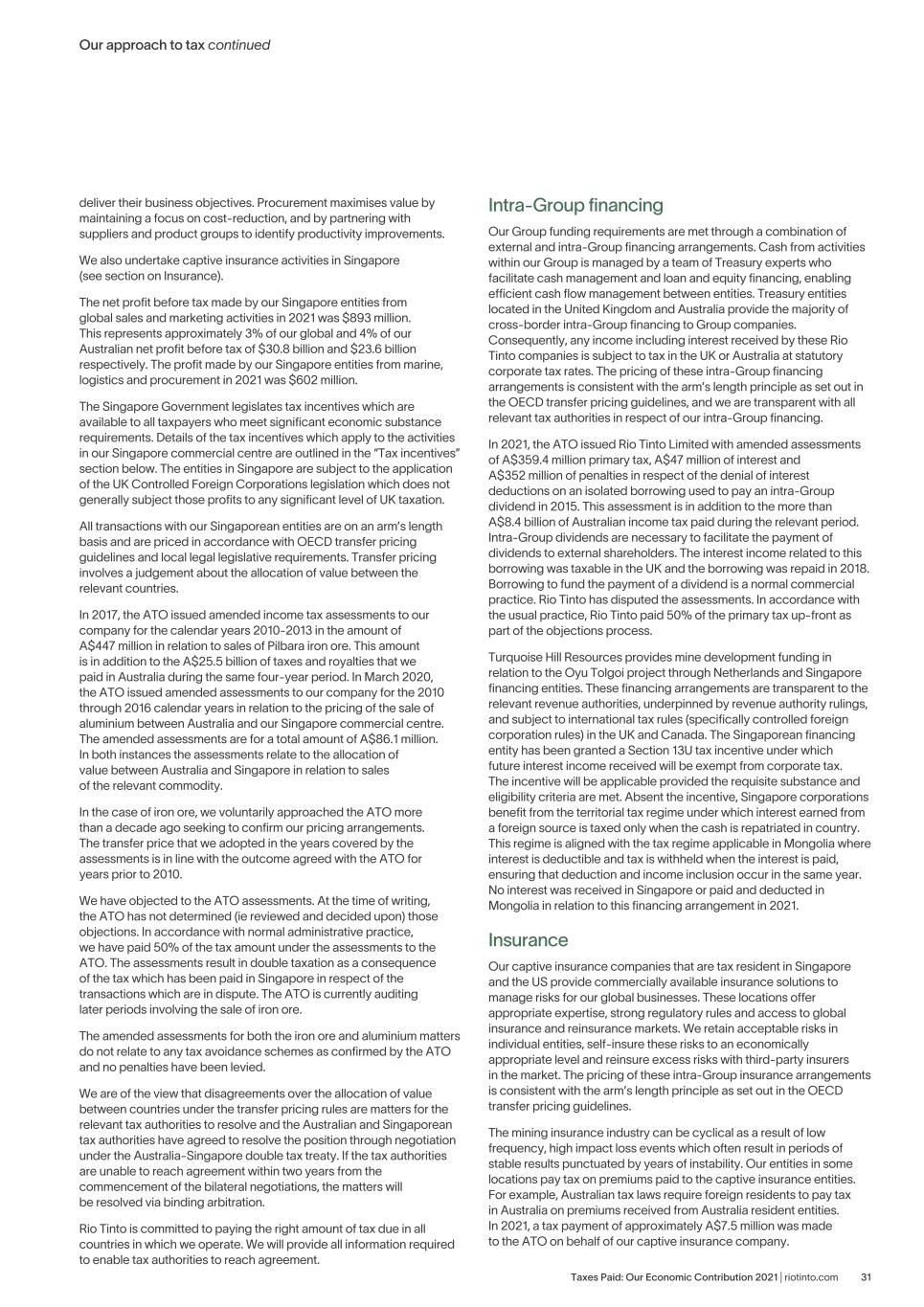
Our approach to tax continued deliver their business objectives. Procurement maximises value by maintaining a focus on cost-reduction, and by partnering with suppliers and product groups to identify productivity improvements. We also undertake captive insurance activities in Singapore (see section on Insurance). The net profit before tax made by our Singapore entities from global sales and marketing activities in 2021 was $893 million. This represents approximately 3% of our global and 4% of our Australian net profit before tax of $30.8 billion and $23.6 billion respectively. The profit made by our Singapore entities from marine, logistics and procurement in 2021 was $602 million. The Singapore Government legislates tax incentives which are available to all taxpayers who meet significant economic substance requirements. Details of the tax incentives which apply to the activities in our Singapore commercial centre are outlined in the “Tax incentives” section below. The entities in Singapore are subject to the application of the UK Controlled Foreign Corporations legislation which does not generally subject those profits to any significant level of UK taxation. All transactions with our Singaporean entities are on an arm’s length basis and are priced in accordance with OECD transfer pricing guidelines and local legal legislative requirements. Transfer pricing involves a judgement about the allocation of value between the relevant countries. In 2017, the ATO issued amended income tax assessments to our company for the calendar years 2010-2013 in the amount of A$447 million in relation to sales of Pilbara iron ore. This amount is in addition to the A$25.5 billion of taxes and royalties that we paid in Australia during the same four-year period. In March 2020, the ATO issued amended assessments to our company for the 2010 through 2016 calendar years in relation to the pricing of the sale of aluminium between Australia and our Singapore commercial centre. The amended assessments are for a total amount of A$86.1 million. In both instances the assessments relate to the allocation of value between Australia and Singapore in relation to sales of the relevant commodity. In the case of iron ore, we voluntarily approached the ATO more than a decade ago seeking to confirm our pricing arrangements. The transfer price that we adopted in the years covered by the assessments is in line with the outcome agreed with the ATO for years prior to 2010. We have objected to the ATO assessments. At the time of writing, the ATO has not determined (ie reviewed and decided upon) those objections. In accordance with normal administrative practice, we have paid 50% of the tax amount under the assessments to the ATO. The assessments result in double taxation as a consequence of the tax which has been paid in Singapore in respect of the transactions which are in dispute. The ATO is currently auditing later periods involving the sale of iron ore. The amended assessments for both the iron ore and aluminium matters do not relate to any tax avoidance schemes as confirmed by the ATO and no penalties have been levied. We are of the view that disagreements over the allocation of value between countries under the transfer pricing rules are matters for the relevant tax authorities to resolve and the Australian and Singaporean tax authorities have agreed to resolve the position through negotiation under the Australia-Singapore double tax treaty. If the tax authorities are unable to reach agreement within two years from the commencement of the bilateral negotiations, the matters will be resolved via binding arbitration. Rio Tinto is committed to paying the right amount of tax due in all countries in which we operate. We will provide all information required to enable tax authorities to reach agreement. Intra-Group financing Our Group funding requirements are met through a combination of external and intra-Group financing arrangements. Cash from activities within our Group is managed by a team of Treasury experts who facilitate cash management and loan and equity financing, enabling efficient cash flow management between entities. Treasury entities located in the United Kingdom and Australia provide the majority of cross-border intra-Group financing to Group companies. Consequently, any income including interest received by these Rio Tinto companies is subject to tax in the UK or Australia at statutory corporate tax rates. The pricing of these intra-Group financing arrangements is consistent with the arm’s length principle as set out in the OECD transfer pricing guidelines, and we are transparent with all relevant tax authorities in respect of our intra-Group financing. In 2021, the ATO issued Rio Tinto Limited with amended assessments of A$359.4 million primary tax, A$47 million of interest and A$352 million of penalties in respect of the denial of interest deductions on an isolated borrowing used to pay an intra-Group dividend in 2015. This assessment is in addition to the more than A$8.4 billion of Australian income tax paid during the relevant period. Intra-Group dividends are necessary to facilitate the payment of dividends to external shareholders. The interest income related to this borrowing was taxable in the UK and the borrowing was repaid in 2018. Borrowing to fund the payment of a dividend is a normal commercial practice. Rio Tinto has disputed the assessments. In accordance with the usual practice, Rio Tinto paid 50% of the primary tax up-front as part of the objections process. Turquoise Hill Resources provides mine development funding in relation to the Oyu Tolgoi project through Netherlands and Singapore financing entities. These financing arrangements are transparent to the relevant revenue authorities, underpinned by revenue authority rulings, and subject to international tax rules (specifically controlled foreign corporation rules) in the UK and Canada. The Singaporean financing entity has been granted a Section 13U tax incentive under which future interest income received will be exempt from corporate tax. The incentive will be applicable provided the requisite substance and eligibility criteria are met. Absent the incentive, Singapore corporations benefit from the territorial tax regime under which interest earned from a foreign source is taxed only when the cash is repatriated in country. This regime is aligned with the tax regime applicable in Mongolia where interest is deductible and tax is withheld when the interest is paid, ensuring that deduction and income inclusion occur in the same year. No interest was received in Singapore or paid and deducted in Mongolia in relation to this financing arrangement in 2021. Insurance Our captive insurance companies that are tax resident in Singapore and the US provide commercially available insurance solutions to manage risks for our global businesses. These locations offer appropriate expertise, strong regulatory rules and access to global insurance and reinsurance markets. We retain acceptable risks in individual entities, self-insure these risks to an economically appropriate level and reinsure excess risks with third-party insurers in the market. The pricing of these intra-Group insurance arrangements is consistent with the arm’s length principle as set out in the OECD transfer pricing guidelines. The mining insurance industry can be cyclical as a result of low frequency, high impact loss events which often result in periods of stable results punctuated by years of instability. Our entities in some locations pay tax on premiums paid to the captive insurance entities. For example, Australian tax laws require foreign residents to pay tax in Australia on premiums received from Australia resident entities. In 2021, a tax payment of approximately A$7.5 million was made to the ATO on behalf of our captive insurance company. 31Taxes Paid: Our Economic Contribution 2021 | riotinto.com
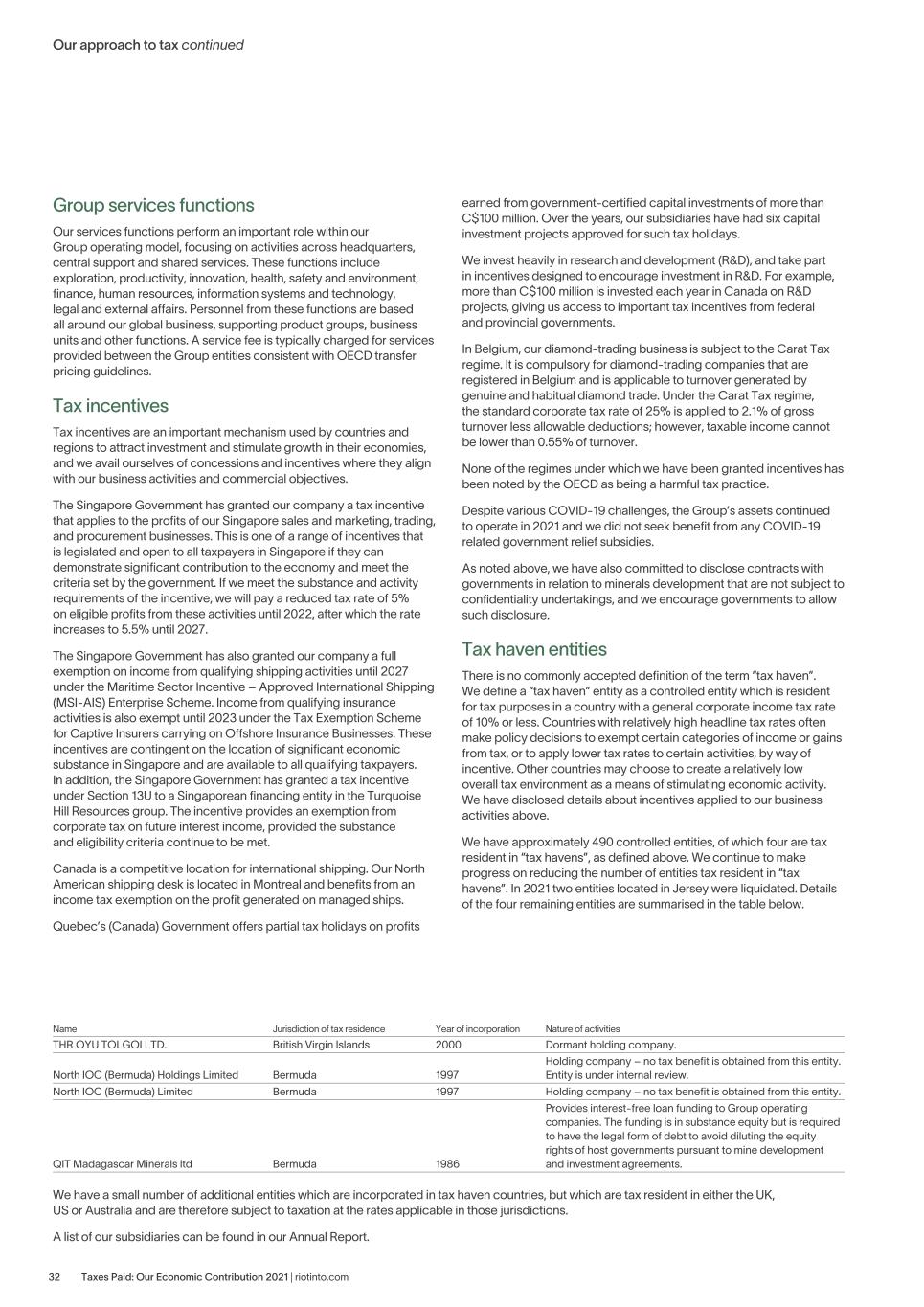
Group services functions Our services functions perform an important role within our Group operating model, focusing on activities across headquarters, central support and shared services. These functions include exploration, productivity, innovation, health, safety and environment, finance, human resources, information systems and technology, legal and external affairs. Personnel from these functions are based all around our global business, supporting product groups, business units and other functions. A service fee is typically charged for services provided between the Group entities consistent with OECD transfer pricing guidelines. Tax incentives Tax incentives are an important mechanism used by countries and regions to attract investment and stimulate growth in their economies, and we avail ourselves of concessions and incentives where they align with our business activities and commercial objectives. The Singapore Government has granted our company a tax incentive that applies to the profits of our Singapore sales and marketing, trading, and procurement businesses. This is one of a range of incentives that is legislated and open to all taxpayers in Singapore if they can demonstrate significant contribution to the economy and meet the criteria set by the government. If we meet the substance and activity requirements of the incentive, we will pay a reduced tax rate of 5% on eligible profits from these activities until 2022, after which the rate increases to 5.5% until 2027. The Singapore Government has also granted our company a full exemption on income from qualifying shipping activities until 2027 under the Maritime Sector Incentive – Approved International Shipping (MSI-AIS) Enterprise Scheme. Income from qualifying insurance activities is also exempt until 2023 under the Tax Exemption Scheme for Captive Insurers carrying on Offshore Insurance Businesses. These incentives are contingent on the location of significant economic substance in Singapore and are available to all qualifying taxpayers. In addition, the Singapore Government has granted a tax incentive under Section 13U to a Singaporean financing entity in the Turquoise Hill Resources group. The incentive provides an exemption from corporate tax on future interest income, provided the substance and eligibility criteria continue to be met. Canada is a competitive location for international shipping. Our North American shipping desk is located in Montreal and benefits from an income tax exemption on the profit generated on managed ships. Quebec’s (Canada) Government offers partial tax holidays on profits earned from government-certified capital investments of more than C$100 million. Over the years, our subsidiaries have had six capital investment projects approved for such tax holidays. We invest heavily in research and development (R&D), and take part in incentives designed to encourage investment in R&D. For example, more than C$100 million is invested each year in Canada on R&D projects, giving us access to important tax incentives from federal and provincial governments. In Belgium, our diamond-trading business is subject to the Carat Tax regime. It is compulsory for diamond-trading companies that are registered in Belgium and is applicable to turnover generated by genuine and habitual diamond trade. Under the Carat Tax regime, the standard corporate tax rate of 25% is applied to 2.1% of gross turnover less allowable deductions; however, taxable income cannot be lower than 0.55% of turnover. None of the regimes under which we have been granted incentives has been noted by the OECD as being a harmful tax practice. Despite various COVID-19 challenges, the Group’s assets continued to operate in 2021 and we did not seek benefit from any COVID-19 related government relief subsidies. As noted above, we have also committed to disclose contracts with governments in relation to minerals development that are not subject to confidentiality undertakings, and we encourage governments to allow such disclosure. Tax haven entities There is no commonly accepted definition of the term “tax haven”. We define a “tax haven” entity as a controlled entity which is resident for tax purposes in a country with a general corporate income tax rate of 10% or less. Countries with relatively high headline tax rates often make policy decisions to exempt certain categories of income or gains from tax, or to apply lower tax rates to certain activities, by way of incentive. Other countries may choose to create a relatively low overall tax environment as a means of stimulating economic activity. We have disclosed details about incentives applied to our business activities above. We have approximately 490 controlled entities, of which four are tax resident in “tax havens”, as defined above. We continue to make progress on reducing the number of entities tax resident in “tax havens”. In 2021 two entities located in Jersey were liquidated. Details of the four remaining entities are summarised in the table below. Name Jurisdiction of tax residence Year of incorporation Nature of activities THR OYU TOLGOI LTD. British Virgin Islands 2000 Dormant holding company. North IOC (Bermuda) Holdings Limited Bermuda 1997 Holding company – no tax benefit is obtained from this entity. Entity is under internal review. North IOC (Bermuda) Limited Bermuda 1997 Holding company – no tax benefit is obtained from this entity. QIT Madagascar Minerals ltd Bermuda 1986 Provides interest-free loan funding to Group operating companies. The funding is in substance equity but is required to have the legal form of debt to avoid diluting the equity rights of host governments pursuant to mine development and investment agreements. We have a small number of additional entities which are incorporated in tax haven countries, but which are tax resident in either the UK, US or Australia and are therefore subject to taxation at the rates applicable in those jurisdictions. A list of our subsidiaries can be found in our Annual Report. Our approach to tax continued Taxes Paid: Our Economic Contribution 2021 | riotinto.com32
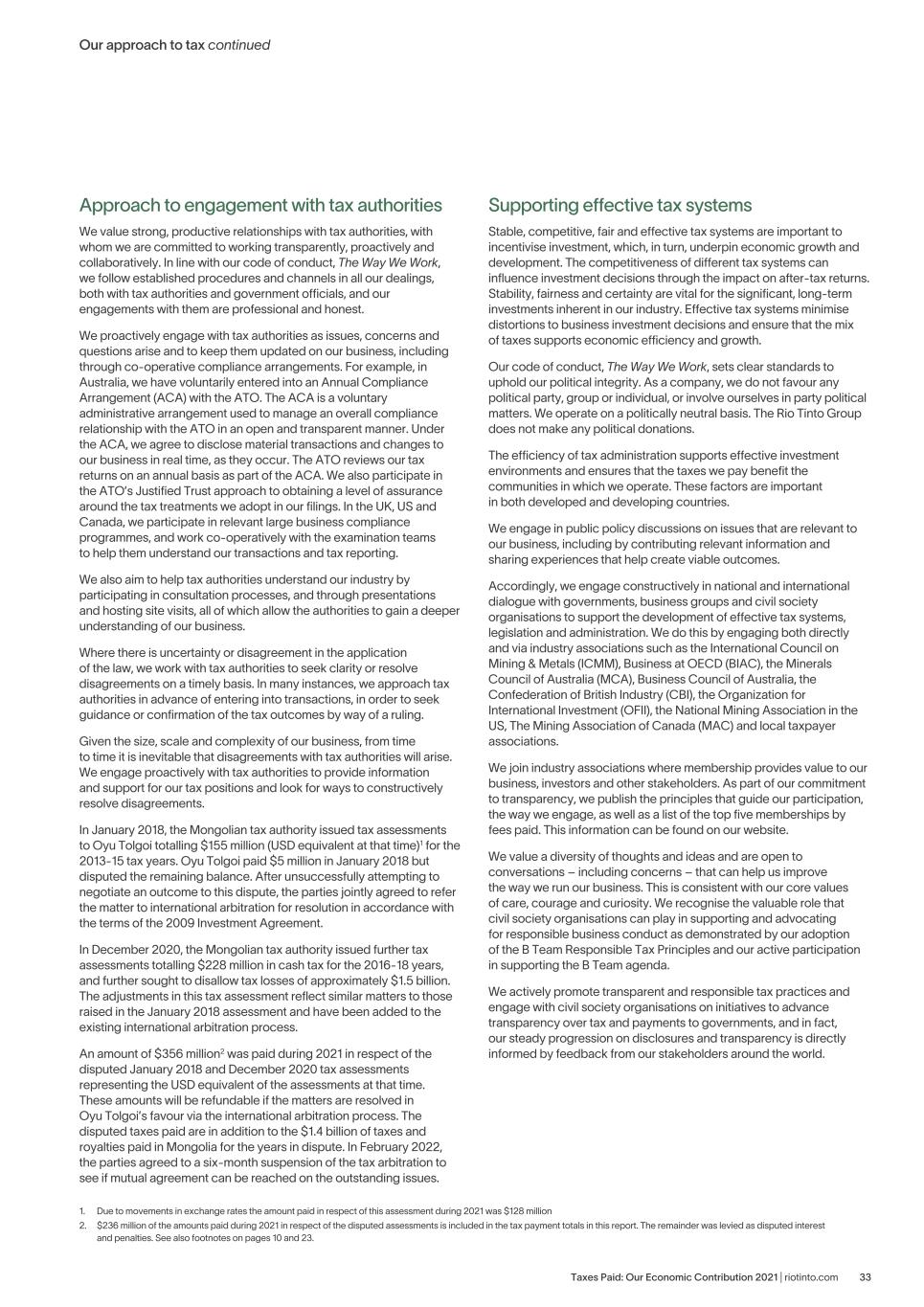
Approach to engagement with tax authorities We value strong, productive relationships with tax authorities, with whom we are committed to working transparently, proactively and collaboratively. In line with our code of conduct, The Way We Work, we follow established procedures and channels in all our dealings, both with tax authorities and government officials, and our engagements with them are professional and honest. We proactively engage with tax authorities as issues, concerns and questions arise and to keep them updated on our business, including through co-operative compliance arrangements. For example, in Australia, we have voluntarily entered into an Annual Compliance Arrangement (ACA) with the ATO. The ACA is a voluntary administrative arrangement used to manage an overall compliance relationship with the ATO in an open and transparent manner. Under the ACA, we agree to disclose material transactions and changes to our business in real time, as they occur. The ATO reviews our tax returns on an annual basis as part of the ACA. We also participate in the ATO’s Justified Trust approach to obtaining a level of assurance around the tax treatments we adopt in our filings. In the UK, US and Canada, we participate in relevant large business compliance programmes, and work co-operatively with the examination teams to help them understand our transactions and tax reporting. We also aim to help tax authorities understand our industry by participating in consultation processes, and through presentations and hosting site visits, all of which allow the authorities to gain a deeper understanding of our business. Where there is uncertainty or disagreement in the application of the law, we work with tax authorities to seek clarity or resolve disagreements on a timely basis. In many instances, we approach tax authorities in advance of entering into transactions, in order to seek guidance or confirmation of the tax outcomes by way of a ruling. Given the size, scale and complexity of our business, from time to time it is inevitable that disagreements with tax authorities will arise. We engage proactively with tax authorities to provide information and support for our tax positions and look for ways to constructively resolve disagreements. In January 2018, the Mongolian tax authority issued tax assessments to Oyu Tolgoi totalling $155 million (USD equivalent at that time)1 for the 2013-15 tax years. Oyu Tolgoi paid $5 million in January 2018 but disputed the remaining balance. After unsuccessfully attempting to negotiate an outcome to this dispute, the parties jointly agreed to refer the matter to international arbitration for resolution in accordance with the terms of the 2009 Investment Agreement. In December 2020, the Mongolian tax authority issued further tax assessments totalling $228 million in cash tax for the 2016-18 years, and further sought to disallow tax losses of approximately $1.5 billion. The adjustments in this tax assessment reflect similar matters to those raised in the January 2018 assessment and have been added to the existing international arbitration process. An amount of $356 million2 was paid during 2021 in respect of the disputed January 2018 and December 2020 tax assessments representing the USD equivalent of the assessments at that time. These amounts will be refundable if the matters are resolved in Oyu Tolgoi’s favour via the international arbitration process. The disputed taxes paid are in addition to the $1.4 billion of taxes and royalties paid in Mongolia for the years in dispute. In February 2022, the parties agreed to a six-month suspension of the tax arbitration to see if mutual agreement can be reached on the outstanding issues. Supporting effective tax systems Stable, competitive, fair and effective tax systems are important to incentivise investment, which, in turn, underpin economic growth and development. The competitiveness of different tax systems can influence investment decisions through the impact on after-tax returns. Stability, fairness and certainty are vital for the significant, long-term investments inherent in our industry. Effective tax systems minimise distortions to business investment decisions and ensure that the mix of taxes supports economic efficiency and growth. Our code of conduct, The Way We Work, sets clear standards to uphold our political integrity. As a company, we do not favour any political party, group or individual, or involve ourselves in party political matters. We operate on a politically neutral basis. The Rio Tinto Group does not make any political donations. The efficiency of tax administration supports effective investment environments and ensures that the taxes we pay benefit the communities in which we operate. These factors are important in both developed and developing countries. We engage in public policy discussions on issues that are relevant to our business, including by contributing relevant information and sharing experiences that help create viable outcomes. Accordingly, we engage constructively in national and international dialogue with governments, business groups and civil society organisations to support the development of effective tax systems, legislation and administration. We do this by engaging both directly and via industry associations such as the International Council on Mining & Metals (ICMM), Business at OECD (BIAC), the Minerals Council of Australia (MCA), Business Council of Australia, the Confederation of British Industry (CBI), the Organization for International Investment (OFII), the National Mining Association in the US, The Mining Association of Canada (MAC) and local taxpayer associations. We join industry associations where membership provides value to our business, investors and other stakeholders. As part of our commitment to transparency, we publish the principles that guide our participation, the way we engage, as well as a list of the top five memberships by fees paid. This information can be found on our website. We value a diversity of thoughts and ideas and are open to conversations – including concerns – that can help us improve the way we run our business. This is consistent with our core values of care, courage and curiosity. We recognise the valuable role that civil society organisations can play in supporting and advocating for responsible business conduct as demonstrated by our adoption of the B Team Responsible Tax Principles and our active participation in supporting the B Team agenda. We actively promote transparent and responsible tax practices and engage with civil society organisations on initiatives to advance transparency over tax and payments to governments, and in fact, our steady progression on disclosures and transparency is directly informed by feedback from our stakeholders around the world. Our approach to tax continued 1. Due to movements in exchange rates the amount paid in respect of this assessment during 2021 was $128 million 2. $236 million of the amounts paid during 2021 in respect of the disputed assessments is included in the tax payment totals in this report. The remainder was levied as disputed interest and penalties. See also footnotes on pages 10 and 23. 33Taxes Paid: Our Economic Contribution 2021 | riotinto.com
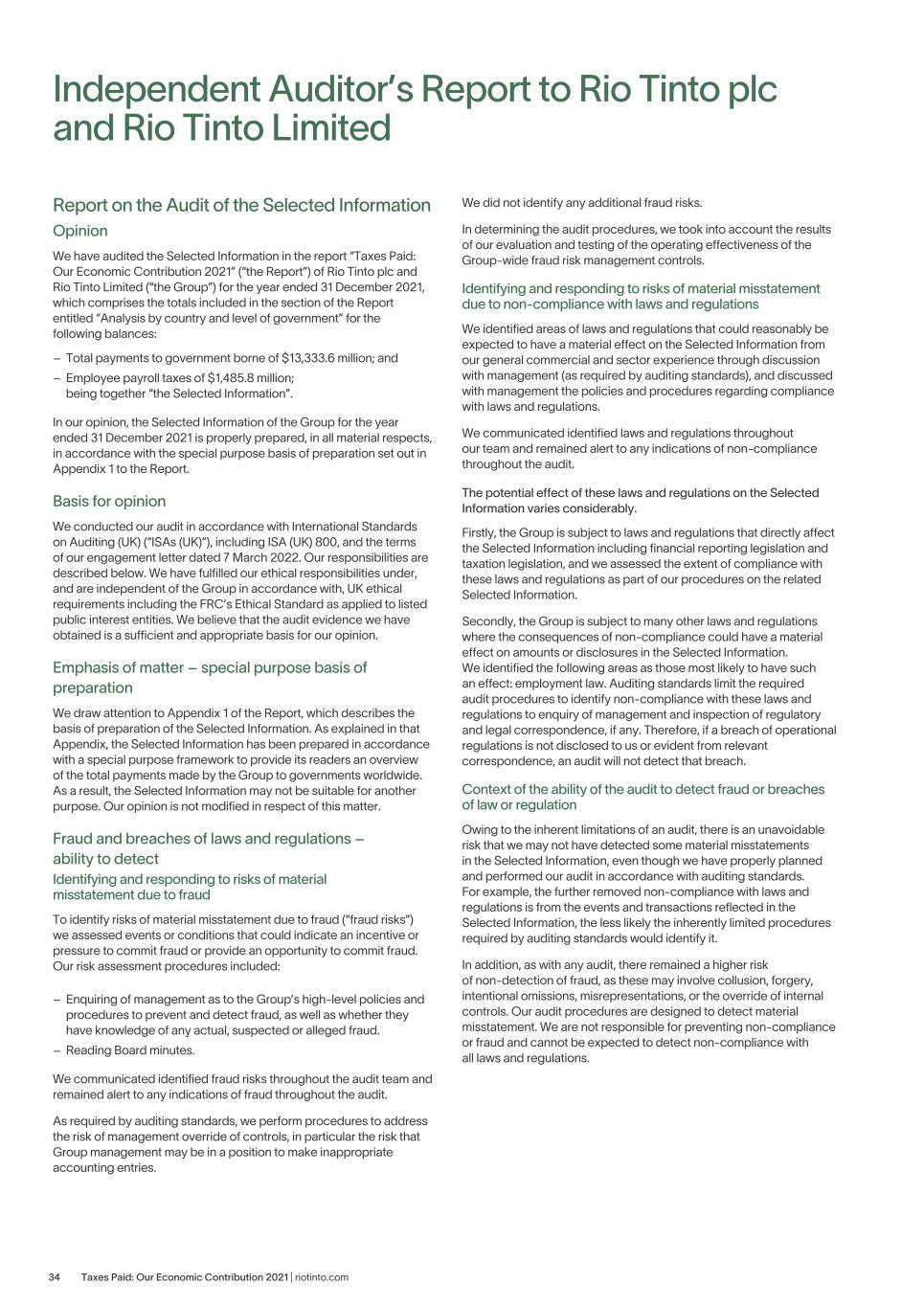
Independent Auditor’s Report to Rio Tinto plc and Rio Tinto Limited Report on the Audit of the Selected Information Opinion We have audited the Selected Information in the report “Taxes Paid: Our Economic Contribution 2021” (“the Report”) of Rio Tinto plc and Rio Tinto Limited (“the Group”) for the year ended 31 December 2021, which comprises the totals included in the section of the Report entitled “Analysis by country and level of government” for the following balances: – Total payments to government borne of $13,333.6 million; and – Employee payroll taxes of $1,485.8 million; being together “the Selected Information”. In our opinion, the Selected Information of the Group for the year ended 31 December 2021 is properly prepared, in all material respects, in accordance with the special purpose basis of preparation set out in Appendix 1 to the Report. Basis for opinion We conducted our audit in accordance with International Standards on Auditing (UK) (“ISAs (UK)”), including ISA (UK) 800, and the terms of our engagement letter dated 7 March 2022. Our responsibilities are described below. We have fulfilled our ethical responsibilities under, and are independent of the Group in accordance with, UK ethical requirements including the FRC’s Ethical Standard as applied to listed public interest entities. We believe that the audit evidence we have obtained is a sufficient and appropriate basis for our opinion. Emphasis of matter – special purpose basis of preparation We draw attention to Appendix 1 of the Report, which describes the basis of preparation of the Selected Information. As explained in that Appendix, the Selected Information has been prepared in accordance with a special purpose framework to provide its readers an overview of the total payments made by the Group to governments worldwide. As a result, the Selected Information may not be suitable for another purpose. Our opinion is not modified in respect of this matter. Fraud and breaches of laws and regulations – ability to detect Identifying and responding to risks of material misstatement due to fraud To identify risks of material misstatement due to fraud (“fraud risks”) we assessed events or conditions that could indicate an incentive or pressure to commit fraud or provide an opportunity to commit fraud. Our risk assessment procedures included: – Enquiring of management as to the Group’s high-level policies and procedures to prevent and detect fraud, as well as whether they have knowledge of any actual, suspected or alleged fraud. – Reading Board minutes. We communicated identified fraud risks throughout the audit team and remained alert to any indications of fraud throughout the audit. As required by auditing standards, we perform procedures to address the risk of management override of controls, in particular the risk that Group management may be in a position to make inappropriate accounting entries. We did not identify any additional fraud risks. In determining the audit procedures, we took into account the results of our evaluation and testing of the operating effectiveness of the Group-wide fraud risk management controls. Identifying and responding to risks of material misstatement due to non-compliance with laws and regulations We identified areas of laws and regulations that could reasonably be expected to have a material effect on the Selected Information from our general commercial and sector experience through discussion with management (as required by auditing standards), and discussed with management the policies and procedures regarding compliance with laws and regulations. We communicated identified laws and regulations throughout our team and remained alert to any indications of non-compliance throughout the audit. The potential effect of these laws and regulations on the Selected Information varies considerably. Firstly, the Group is subject to laws and regulations that directly affect the Selected Information including financial reporting legislation and taxation legislation, and we assessed the extent of compliance with these laws and regulations as part of our procedures on the related Selected Information. Secondly, the Group is subject to many other laws and regulations where the consequences of non-compliance could have a material effect on amounts or disclosures in the Selected Information. We identified the following areas as those most likely to have such an effect: employment law. Auditing standards limit the required audit procedures to identify non-compliance with these laws and regulations to enquiry of management and inspection of regulatory and legal correspondence, if any. Therefore, if a breach of operational regulations is not disclosed to us or evident from relevant correspondence, an audit will not detect that breach. Context of the ability of the audit to detect fraud or breaches of law or regulation Owing to the inherent limitations of an audit, there is an unavoidable risk that we may not have detected some material misstatements in the Selected Information, even though we have properly planned and performed our audit in accordance with auditing standards. For example, the further removed non-compliance with laws and regulations is from the events and transactions reflected in the Selected Information, the less likely the inherently limited procedures required by auditing standards would identify it. In addition, as with any audit, there remained a higher risk of non-detection of fraud, as these may involve collusion, forgery, intentional omissions, misrepresentations, or the override of internal controls. Our audit procedures are designed to detect material misstatement. We are not responsible for preventing non-compliance or fraud and cannot be expected to detect non-compliance with all laws and regulations. Taxes Paid: Our Economic Contribution 2021 | riotinto.com34

Other information Management are responsible for the other information presented in the Report together with the Selected Information. The other information comprises the whole of the Report on pages 1 to 33 except the Selected Information. Our opinion on the Selected Information does not cover the other information and, accordingly, we do not express an audit opinion or any form of assurance thereon. Our responsibility is to read the other information and, in doing so, consider whether, based on our Selected Information audit work the information therein is materially misstated or inconsistent with the Selected Information or our audit knowledge. Based solely on that work, we have not identified material misstatements in the other information. Management and directors’ responsibilities Management of the Group are responsible for the preparation of the Report, including the preparation of the Selected Information in accordance with the basis of preparation in Appendix 1 to the Report; determining that the basis of preparation is acceptable in the circumstances and such internal control as they determine is necessary to enable the preparation of Selected Information that is free from material misstatement, whether due to fraud or error. The directors of the Group are responsible for overseeing the Group’s financial reporting process. Auditor’s responsibilities Our objectives are to obtain reasonable assurance about whether the Selected Information is free from material misstatement, whether due to fraud or error, and to issue our opinion in an auditor’s report. Reasonable assurance is a high level of assurance, but does not a guarantee that an audit conducted in accordance with ISAs (UK) will always detect a material misstatement when it exists. Misstatements can arise from fraud or error and are considered material if, individually or in aggregate, they could reasonably be expected to influence the economic decisions of users taken on the basis of the Selected Information. A fuller description of our responsibilities is provided on the FRC’s website at www.frc.org.uk/auditorsresponsibilities. The purpose of our audit work and to whom we owe our responsibilities This report is made solely to the Group, in accordance with the agreed terms of our engagement. Our audit work has been undertaken so that we might state to the Group those matters we have agreed to state to it in this report, and for no other purpose. To the fullest extent permitted by law, we do not accept or assume responsibility to anyone other than the Group for our audit work, for this report, or for the opinions we have formed. Jonathan Downer for and on behalf of KPMG LLP Chartered Accountants 15 Canada Square, London, E14 5GL 6 April 2022 Independent auditor’s report to Rio Tinto plc and Rio Tinto Limited continued 35Taxes Paid: Our Economic Contribution 2021 | riotinto.com
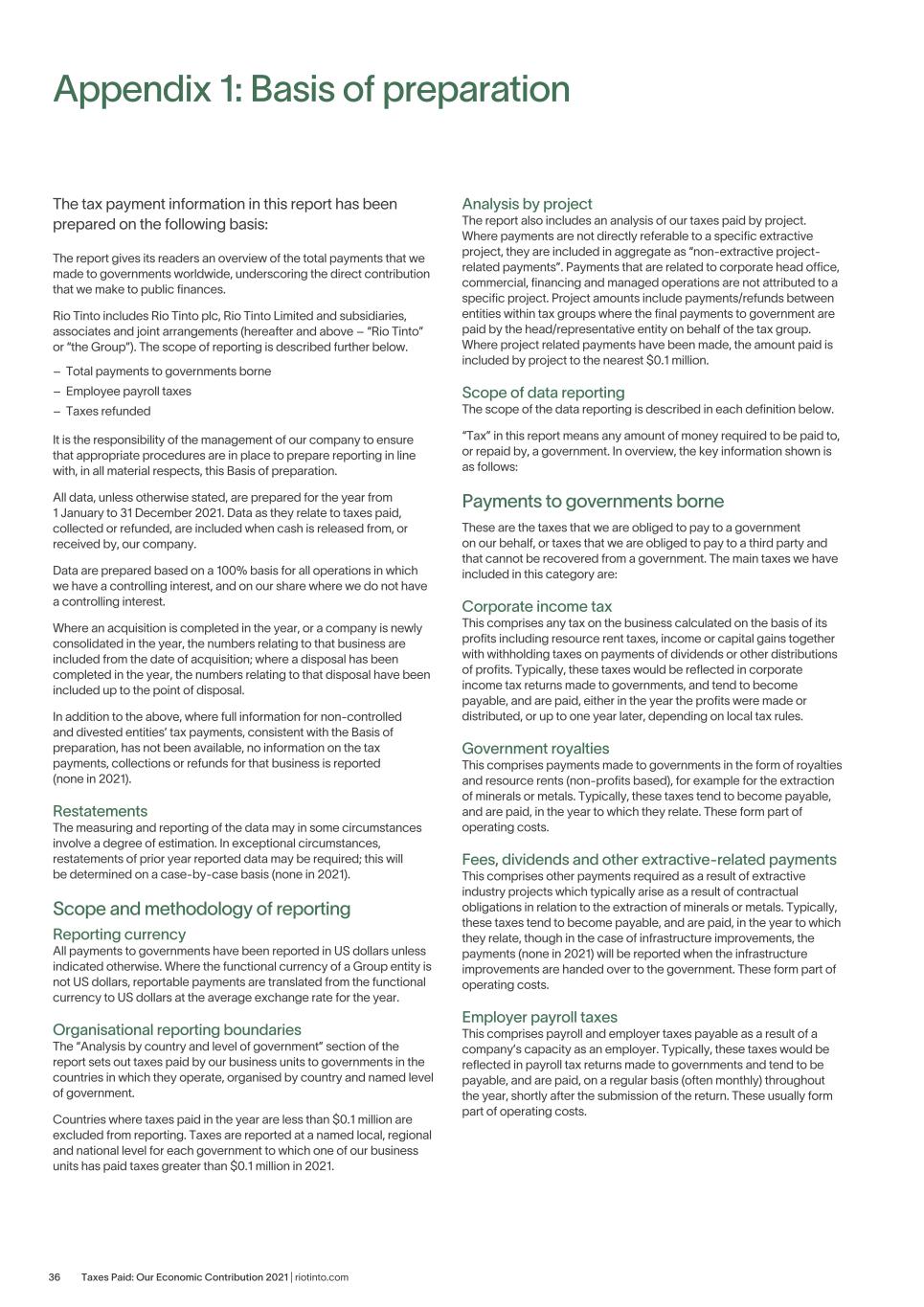
Analysis by project The report also includes an analysis of our taxes paid by project. Where payments are not directly referable to a specific extractive project, they are included in aggregate as “non-extractive project- related payments”. Payments that are related to corporate head office, commercial, financing and managed operations are not attributed to a specific project. Project amounts include payments/refunds between entities within tax groups where the final payments to government are paid by the head/representative entity on behalf of the tax group. Where project related payments have been made, the amount paid is included by project to the nearest $0.1 million. Scope of data reporting The scope of the data reporting is described in each definition below. “Tax” in this report means any amount of money required to be paid to, or repaid by, a government. In overview, the key information shown is as follows: Payments to governments borne These are the taxes that we are obliged to pay to a government on our behalf, or taxes that we are obliged to pay to a third party and that cannot be recovered from a government. The main taxes we have included in this category are: Corporate income tax This comprises any tax on the business calculated on the basis of its profits including resource rent taxes, income or capital gains together with withholding taxes on payments of dividends or other distributions of profits. Typically, these taxes would be reflected in corporate income tax returns made to governments, and tend to become payable, and are paid, either in the year the profits were made or distributed, or up to one year later, depending on local tax rules. Government royalties This comprises payments made to governments in the form of royalties and resource rents (non-profits based), for example for the extraction of minerals or metals. Typically, these taxes tend to become payable, and are paid, in the year to which they relate. These form part of operating costs. Fees, dividends and other extractive-related payments This comprises other payments required as a result of extractive industry projects which typically arise as a result of contractual obligations in relation to the extraction of minerals or metals. Typically, these taxes tend to become payable, and are paid, in the year to which they relate, though in the case of infrastructure improvements, the payments (none in 2021) will be reported when the infrastructure improvements are handed over to the government. These form part of operating costs. Employer payroll taxes This comprises payroll and employer taxes payable as a result of a company’s capacity as an employer. Typically, these taxes would be reflected in payroll tax returns made to governments and tend to be payable, and are paid, on a regular basis (often monthly) throughout the year, shortly after the submission of the return. These usually form part of operating costs. Appendix 1: Basis of preparation The tax payment information in this report has been prepared on the following basis: The report gives its readers an overview of the total payments that we made to governments worldwide, underscoring the direct contribution that we make to public finances. Rio Tinto includes Rio Tinto plc, Rio Tinto Limited and subsidiaries, associates and joint arrangements (hereafter and above – “Rio Tinto” or “the Group”). The scope of reporting is described further below. – Total payments to governments borne – Employee payroll taxes – Taxes refunded It is the responsibility of the management of our company to ensure that appropriate procedures are in place to prepare reporting in line with, in all material respects, this Basis of preparation. All data, unless otherwise stated, are prepared for the year from 1 January to 31 December 2021. Data as they relate to taxes paid, collected or refunded, are included when cash is released from, or received by, our company. Data are prepared based on a 100% basis for all operations in which we have a controlling interest, and on our share where we do not have a controlling interest. Where an acquisition is completed in the year, or a company is newly consolidated in the year, the numbers relating to that business are included from the date of acquisition; where a disposal has been completed in the year, the numbers relating to that disposal have been included up to the point of disposal. In addition to the above, where full information for non-controlled and divested entities’ tax payments, consistent with the Basis of preparation, has not been available, no information on the tax payments, collections or refunds for that business is reported (none in 2021). Restatements The measuring and reporting of the data may in some circumstances involve a degree of estimation. In exceptional circumstances, restatements of prior year reported data may be required; this will be determined on a case-by-case basis (none in 2021). Scope and methodology of reporting Reporting currency All payments to governments have been reported in US dollars unless indicated otherwise. Where the functional currency of a Group entity is not US dollars, reportable payments are translated from the functional currency to US dollars at the average exchange rate for the year. Organisational reporting boundaries The “Analysis by country and level of government” section of the report sets out taxes paid by our business units to governments in the countries in which they operate, organised by country and named level of government. Countries where taxes paid in the year are less than $0.1 million are excluded from reporting. Taxes are reported at a named local, regional and national level for each government to which one of our business units has paid taxes greater than $0.1 million in 2021. Taxes Paid: Our Economic Contribution 2021 | riotinto.com36
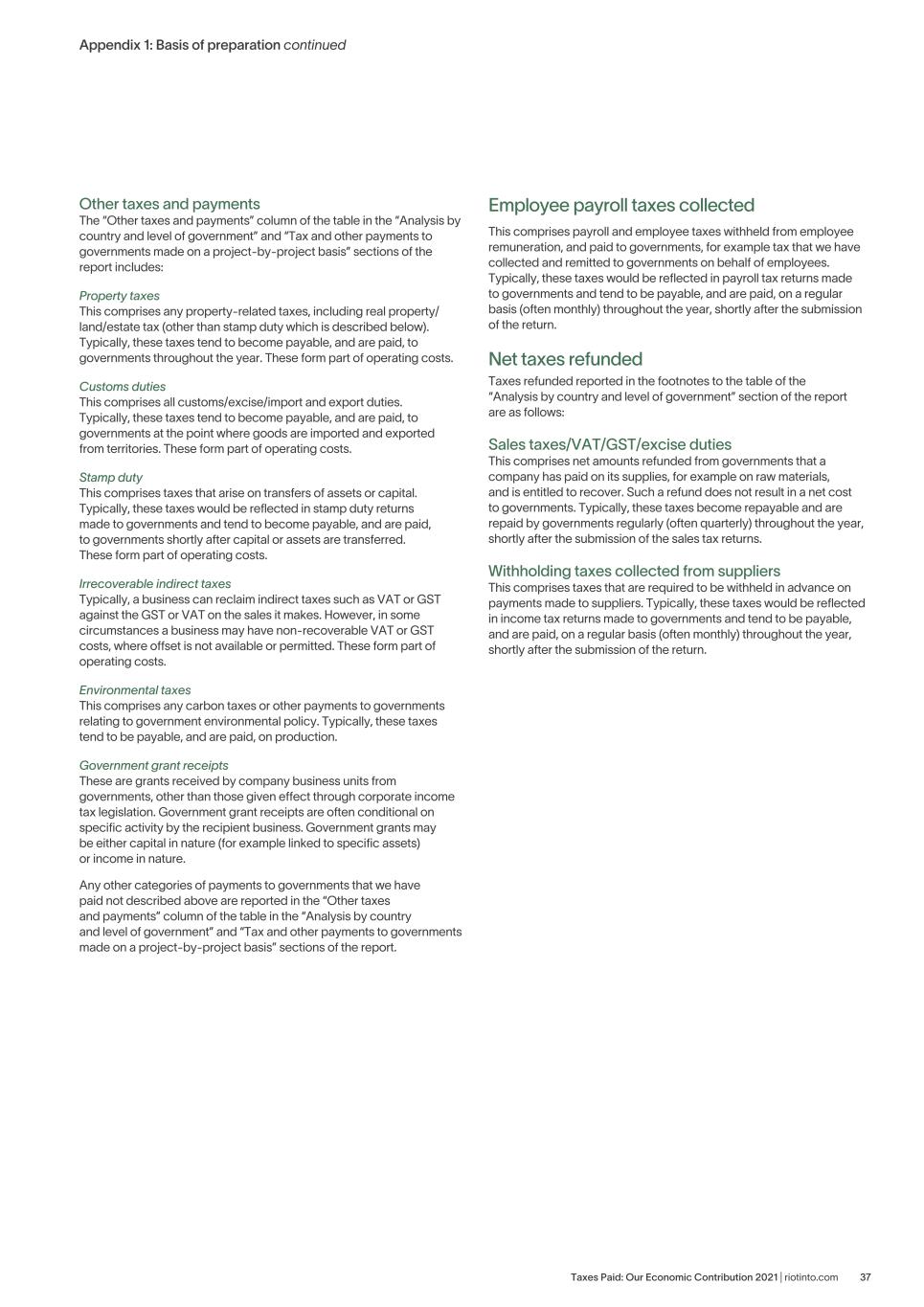
Other taxes and payments The “Other taxes and payments” column of the table in the “Analysis by country and level of government” and “Tax and other payments to governments made on a project-by-project basis” sections of the report includes: Property taxes This comprises any property-related taxes, including real property/ land/estate tax (other than stamp duty which is described below). Typically, these taxes tend to become payable, and are paid, to governments throughout the year. These form part of operating costs. Customs duties This comprises all customs/excise/import and export duties. Typically, these taxes tend to become payable, and are paid, to governments at the point where goods are imported and exported from territories. These form part of operating costs. Stamp duty This comprises taxes that arise on transfers of assets or capital. Typically, these taxes would be reflected in stamp duty returns made to governments and tend to become payable, and are paid, to governments shortly after capital or assets are transferred. These form part of operating costs. Irrecoverable indirect taxes Typically, a business can reclaim indirect taxes such as VAT or GST against the GST or VAT on the sales it makes. However, in some circumstances a business may have non-recoverable VAT or GST costs, where offset is not available or permitted. These form part of operating costs. Environmental taxes This comprises any carbon taxes or other payments to governments relating to government environmental policy. Typically, these taxes tend to be payable, and are paid, on production. Government grant receipts These are grants received by company business units from governments, other than those given effect through corporate income tax legislation. Government grant receipts are often conditional on specific activity by the recipient business. Government grants may be either capital in nature (for example linked to specific assets) or income in nature. Any other categories of payments to governments that we have paid not described above are reported in the “Other taxes and payments” column of the table in the “Analysis by country and level of government” and “Tax and other payments to governments made on a project-by-project basis” sections of the report. Employee payroll taxes collected This comprises payroll and employee taxes withheld from employee remuneration, and paid to governments, for example tax that we have collected and remitted to governments on behalf of employees. Typically, these taxes would be reflected in payroll tax returns made to governments and tend to be payable, and are paid, on a regular basis (often monthly) throughout the year, shortly after the submission of the return. Net taxes refunded Taxes refunded reported in the footnotes to the table of the “Analysis by country and level of government” section of the report are as follows: Sales taxes/VAT/GST/excise duties This comprises net amounts refunded from governments that a company has paid on its supplies, for example on raw materials, and is entitled to recover. Such a refund does not result in a net cost to governments. Typically, these taxes become repayable and are repaid by governments regularly (often quarterly) throughout the year, shortly after the submission of the sales tax returns. Withholding taxes collected from suppliers This comprises taxes that are required to be withheld in advance on payments made to suppliers. Typically, these taxes would be reflected in income tax returns made to governments and tend to be payable, and are paid, on a regular basis (often monthly) throughout the year, shortly after the submission of the return. Appendix 1: Basis of preparation continued 37Taxes Paid: Our Economic Contribution 2021 | riotinto.com
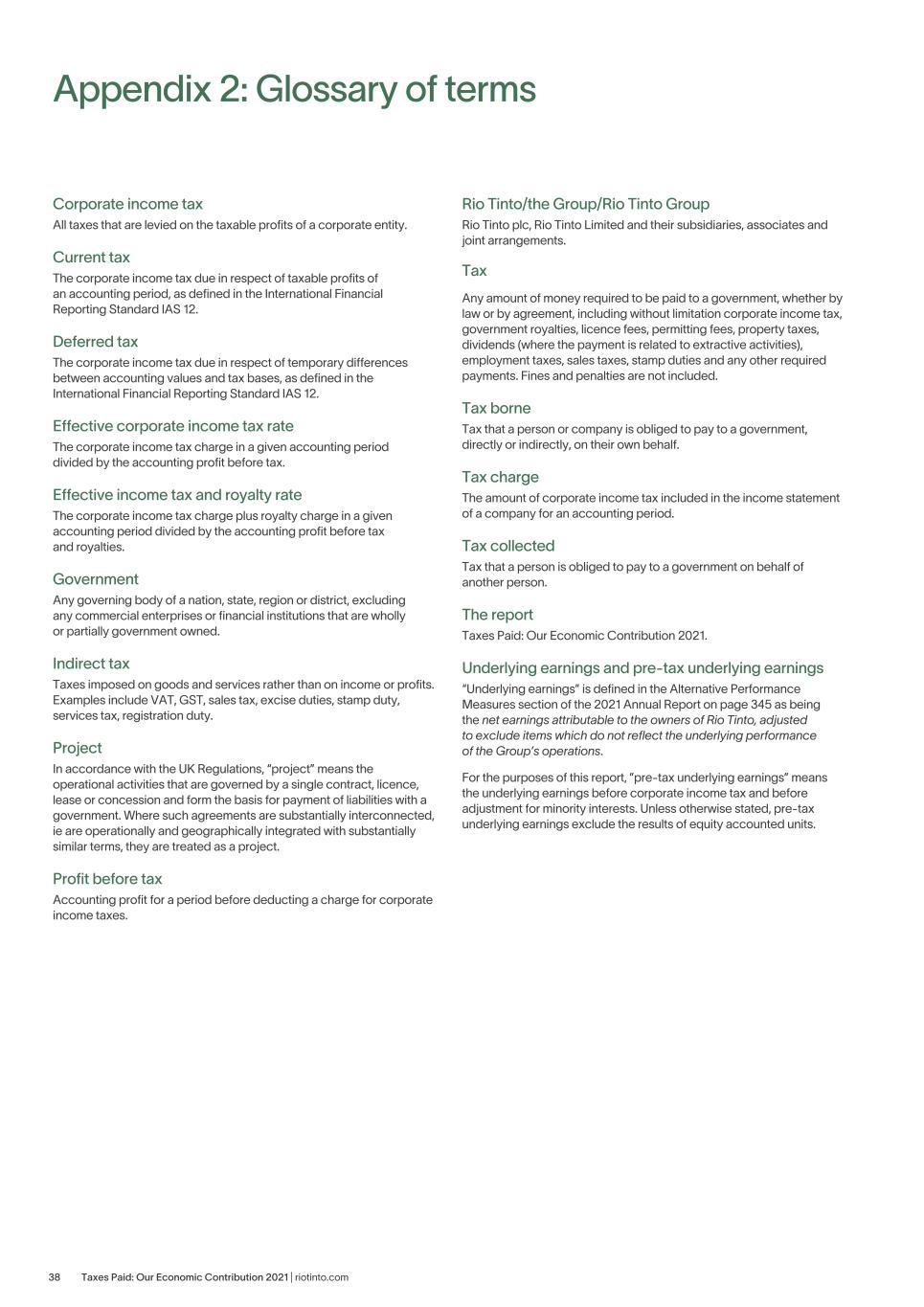
Rio Tinto/the Group/Rio Tinto Group Rio Tinto plc, Rio Tinto Limited and their subsidiaries, associates and joint arrangements. Tax Any amount of money required to be paid to a government, whether by law or by agreement, including without limitation corporate income tax, government royalties, licence fees, permitting fees, property taxes, dividends (where the payment is related to extractive activities), employment taxes, sales taxes, stamp duties and any other required payments. Fines and penalties are not included. Tax borne Tax that a person or company is obliged to pay to a government, directly or indirectly, on their own behalf. Tax charge The amount of corporate income tax included in the income statement of a company for an accounting period. Tax collected Tax that a person is obliged to pay to a government on behalf of another person. The report Taxes Paid: Our Economic Contribution 2021. Underlying earnings and pre-tax underlying earnings “Underlying earnings” is defined in the Alternative Performance Measures section of the 2021 Annual Report on page 345 as being the net earnings attributable to the owners of Rio Tinto, adjusted to exclude items which do not reflect the underlying performance of the Group’s operations. For the purposes of this report, ”pre-tax underlying earnings” means the underlying earnings before corporate income tax and before adjustment for minority interests. Unless otherwise stated, pre-tax underlying earnings exclude the results of equity accounted units. Appendix 2: Glossary of terms Corporate income tax All taxes that are levied on the taxable profits of a corporate entity. Current tax The corporate income tax due in respect of taxable profits of an accounting period, as defined in the International Financial Reporting Standard IAS 12. Deferred tax The corporate income tax due in respect of temporary differences between accounting values and tax bases, as defined in the International Financial Reporting Standard IAS 12. Effective corporate income tax rate The corporate income tax charge in a given accounting period divided by the accounting profit before tax. Effective income tax and royalty rate The corporate income tax charge plus royalty charge in a given accounting period divided by the accounting profit before tax and royalties. Government Any governing body of a nation, state, region or district, excluding any commercial enterprises or financial institutions that are wholly or partially government owned. Indirect tax Taxes imposed on goods and services rather than on income or profits. Examples include VAT, GST, sales tax, excise duties, stamp duty, services tax, registration duty. Project In accordance with the UK Regulations, “project” means the operational activities that are governed by a single contract, licence, lease or concession and form the basis for payment of liabilities with a government. Where such agreements are substantially interconnected, ie are operationally and geographically integrated with substantially similar terms, they are treated as a project. Profit before tax Accounting profit for a period before deducting a charge for corporate income taxes. Taxes Paid: Our Economic Contribution 2021 | riotinto.com38
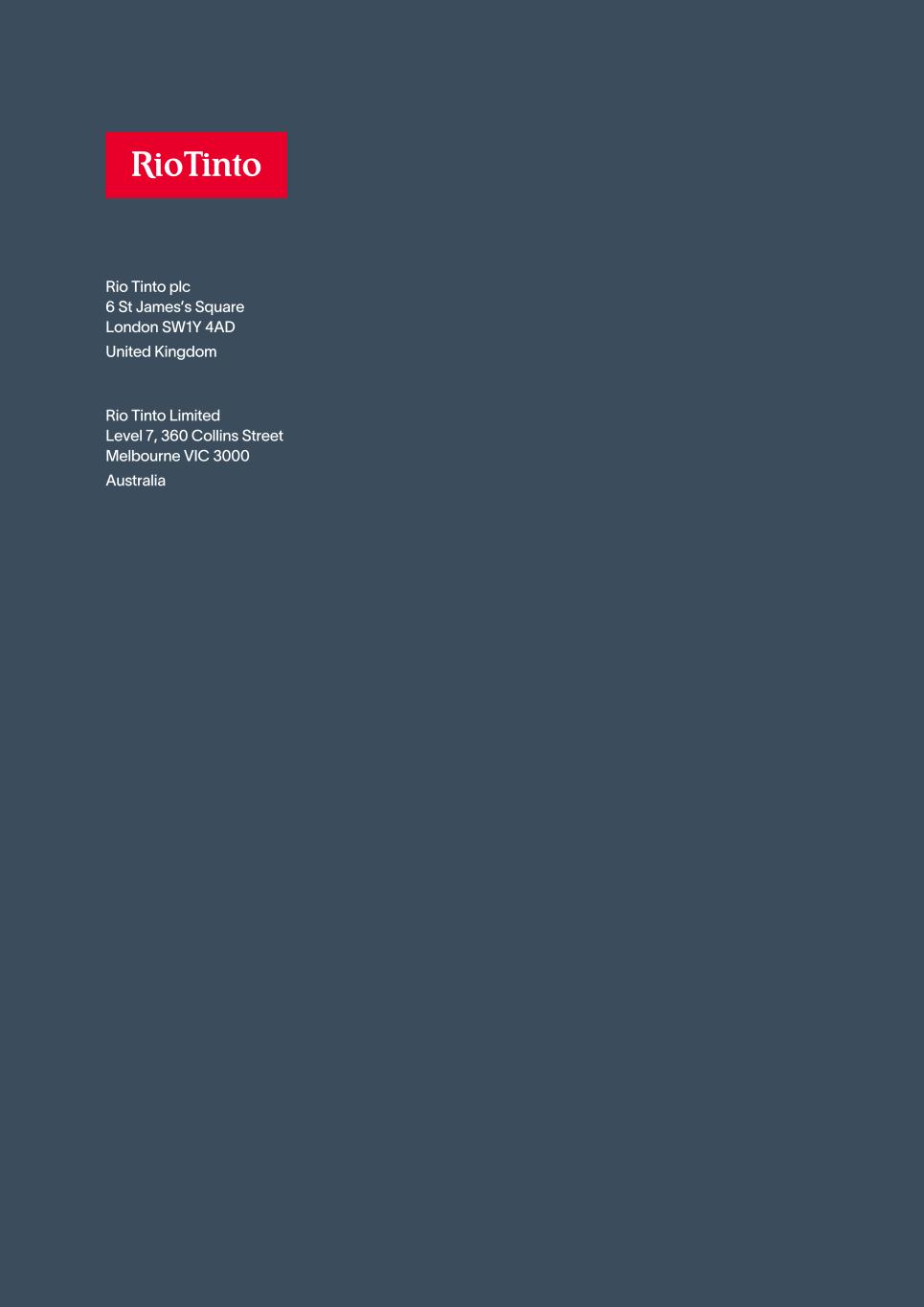
Rio Tinto plc 6 St James’s Square London SW1Y 4AD United Kingdom Rio Tinto Limited Level 7, 360 Collins Street Melbourne VIC 3000 Australia




